Home Blog Business Executive Summary: A Guide to Writing and Presentation

Executive Summary: A Guide to Writing and Presentation
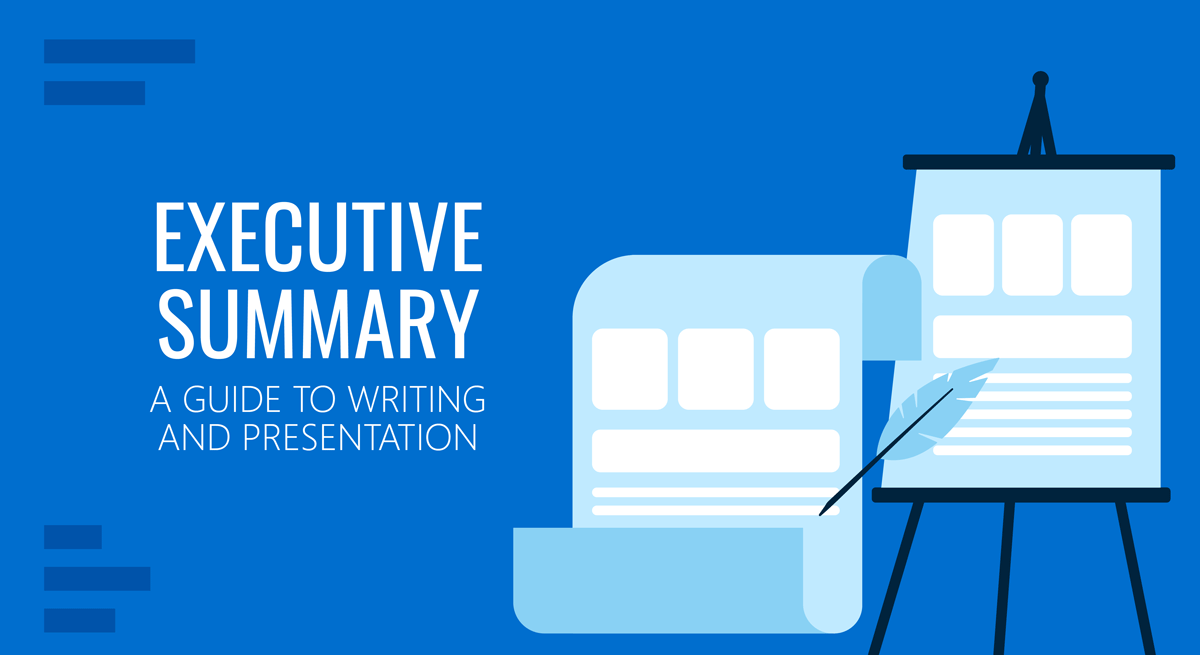
Executive summaries precede nearly every type of business document. Despite being the shortest part, they often leave the biggest impression on the reader. Yet, many writers choose to treat an executive summary as an afterthought. (And some presenters too!). Why? Because writing an executive summary is a seemingly hard task. But our mission is to prove otherwise!
What is an Executive Summary?
An executive summary is a preface to a larger business document such as an annual report, business plan, or whitepaper, succinctly summarizing the key discussion points. Effectively, an executive summary offers a preview of the content, so that the reader could form a baseline opinion about the contents prior to diving into a deep reading session.
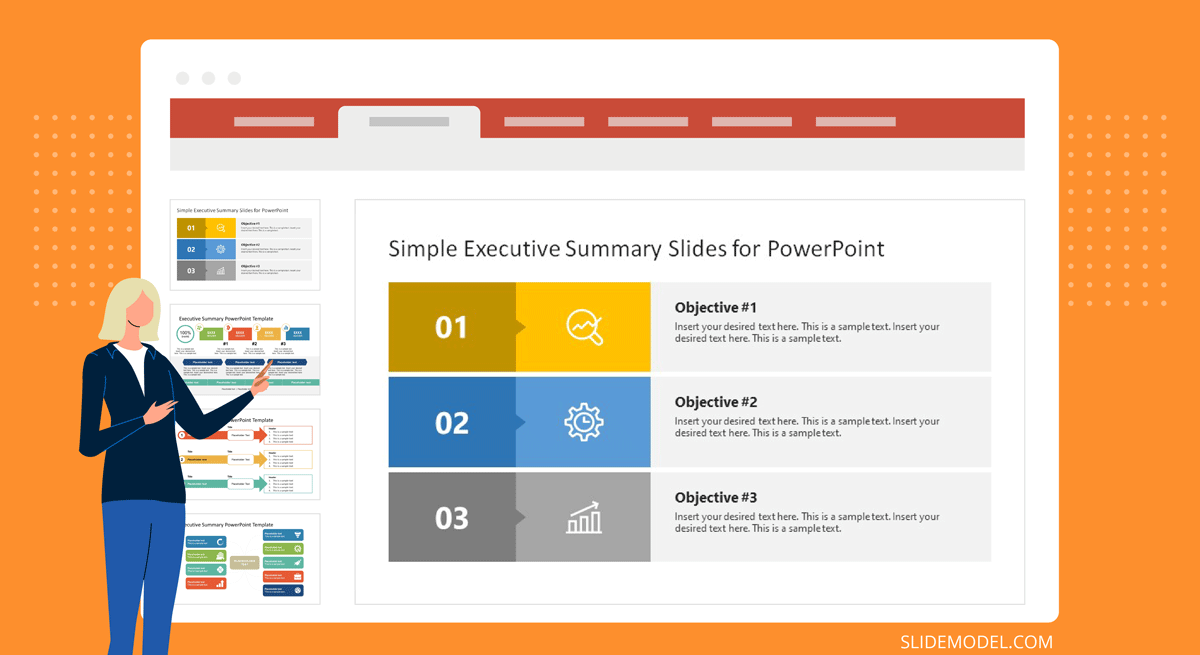
The University of Arizona offers a more elaborated executive summary definition which also notes that an executive summary should:
- Restate the purpose of the follow-up document
- Highlight the key discussion points and most notable facts
- Relay any notable results, conclusions, or recommendations
Though an executive summary is just a foreword to a bigger report, it’s one of the most labor-intensive items as you have to condense a lot of information into a high-level summary. Oftentimes, an executive summary also gets prominent placement in the follow-up presentation, done on the report.
Executive Summary Examples
Nearly every type of business document will have an executive summary. Some are better structured and presented than others. But it’s not just limited to business documents. Executive summaries are also used in scientific projects, articles, and education. Below are several admirable executive summary examples you may want to use as an inspiration for writing.
Accenture: Gaming: The Next Super Platform
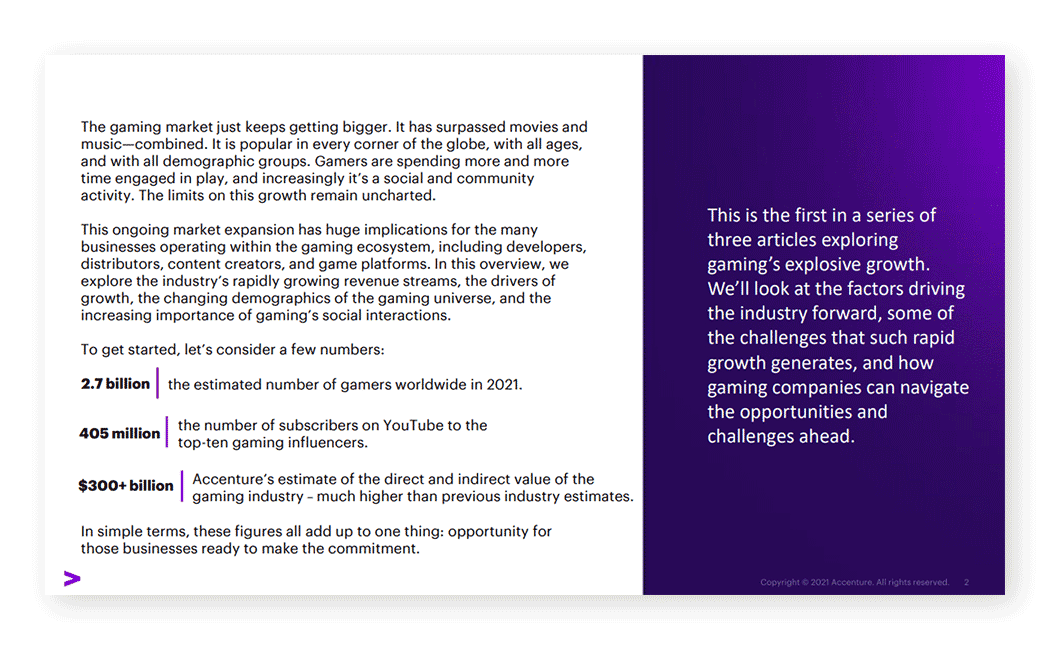
This executive summary for an industry report opens with some big quantifiable claims, clearly communicating the main agenda — describing the size and state of the global gaming market. The gaming industry is a huge market. The pullout texts on the sidebar further detail the scope of the document. Plus clarify for whom this report is intended.
IBM: Cost of a Data Breach Report 2020
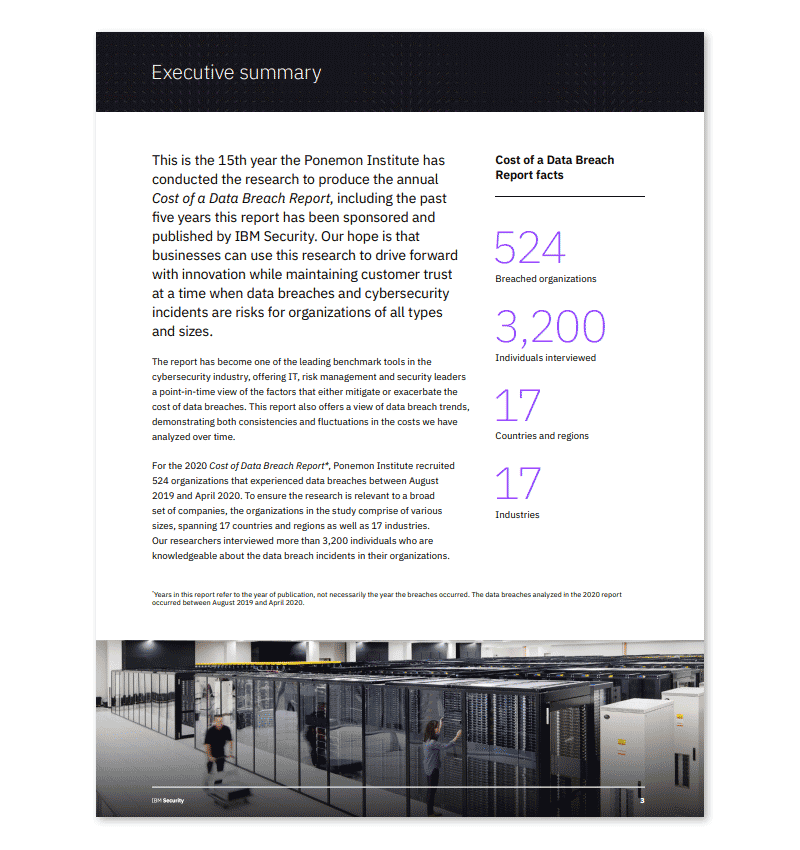
IBM conducts an annual joint report on cybersecurity with Ponemon Institute. They open the executive summary with a brief recap of their mission and past research. Then dwell on this year’s findings and methodology. If you are writing an executive summary for a similarly massive original research, it’s worth focusing more on your techniques for obtaining data and arriving at the conclusions as IBM did.
Deloitte Digital: Exploring the value of emotion-driven engagement
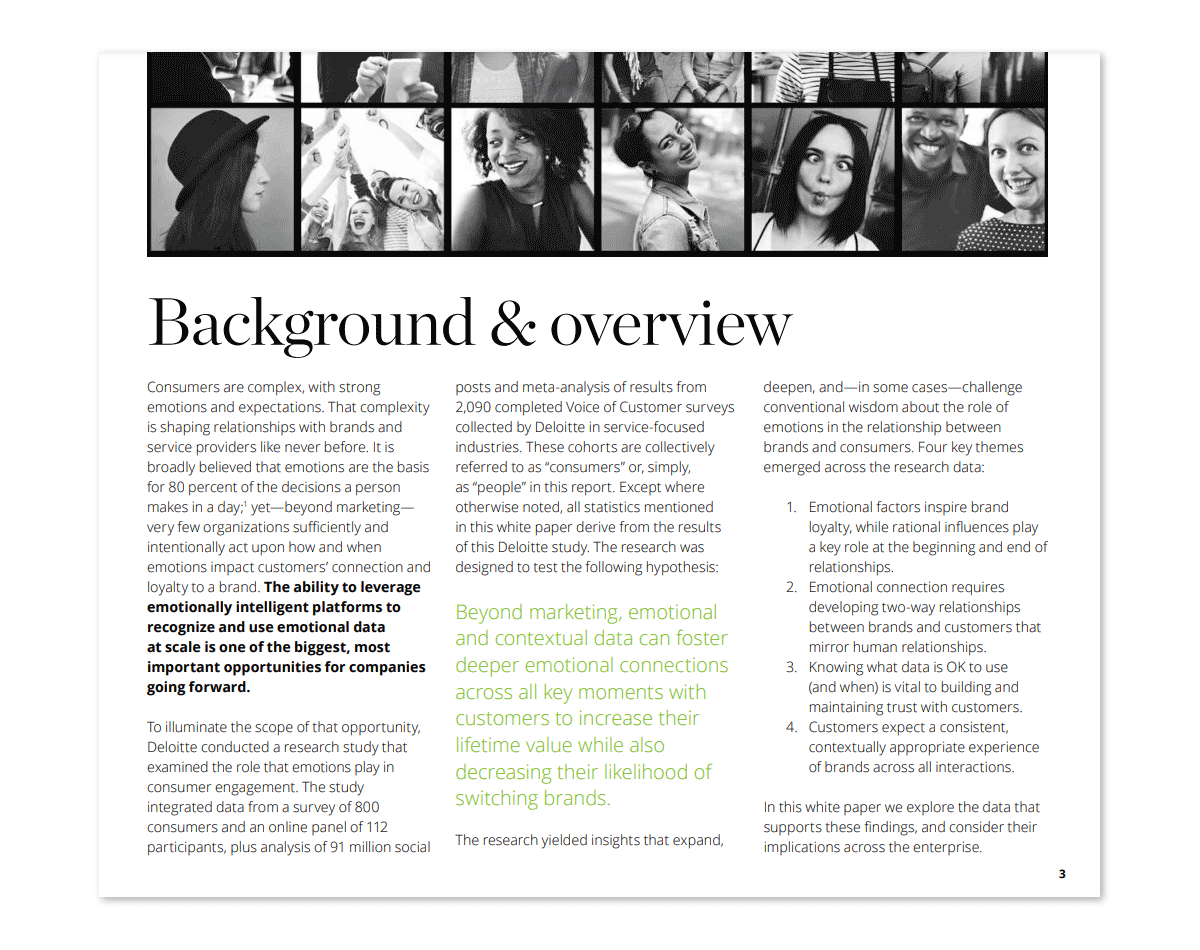
Deloitte selected a more narrative style for this executive summary, mixing some key data points and methodology with the core messaging of the report. This is a good example of structured data presentation . On one hand, you have an engaging narration flow. On the other, the summary covers all the important discussion points.
Executive Summary Format
As the above executive summary examples illustrated, there is no one fit-it-all format for writing an executive study. The best approach depends on your report type, purpose, and contents.
That being said, an executive summary needs to fulfill several earlier mentioned criteria — offer a preview, provide key information at glance, showcase any results, recommendations. That’s what most readers expect to see on the first page after all.
The easiest way to approach writing is to draft a preliminary executive summary outline featuring the following subsections:
- General introduction, explaining the key problems discussed
- Main problem statement(s)
- Selected findings or recommendations
- The importance of discussed points
Since you’d also be likely working on presenting the executive summary to other stakeholders , it helps you keep the above structured as bullet points at first. So that you could easily transfer the main ideas to your executive summary PowerPoint slide .
How Long Should an Executive Summary Be?
As a rule of thumb, an executive summary should not go longer than one vertical page. That is an equivalent of 300-500 words, depending on the typeface. For longer reports, two pages (a horizontal split) may be acceptable. But remember, brevity is key. You are working on a trailer for a movie (the full report).
How to Write an Executive Summary: a 3-Step Framework
You can start with the aforementioned loose format and then adapt it to your document type. Remember, you don’t need to follow all the recommendations to a T. Instead, mix some ideas to make your executive summary sound both professional and engaging. Here are several tips for that:
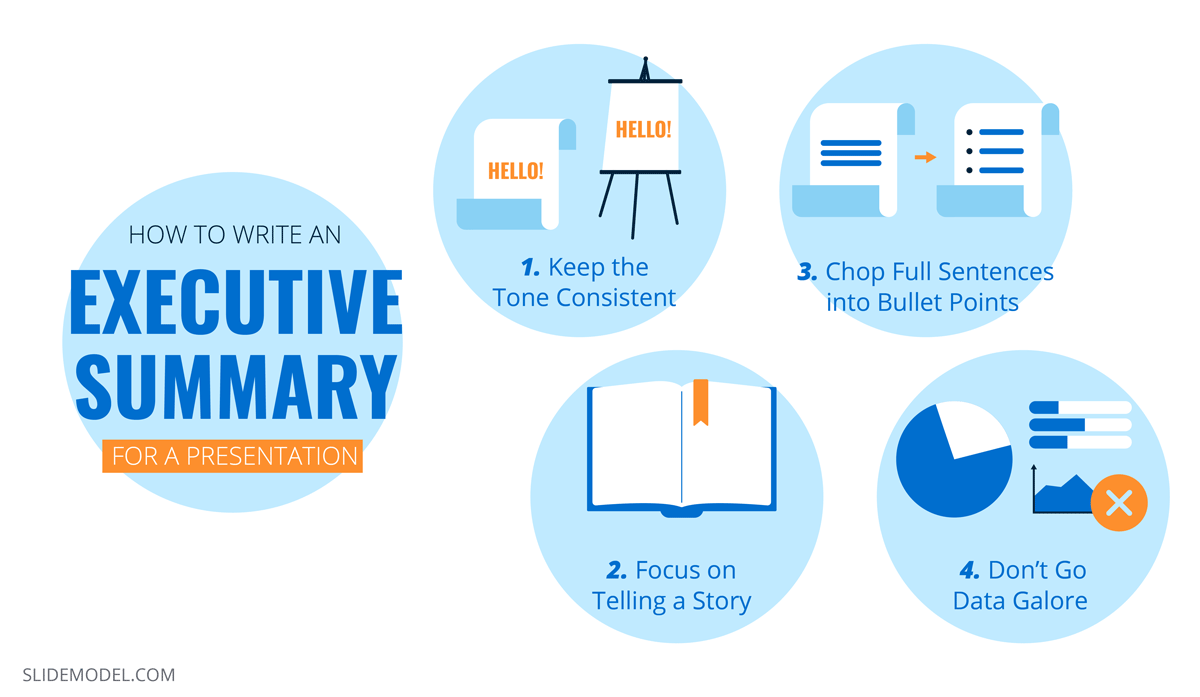
1. Start with a Problem Statement
Think of the first paragraph as if of an opening slide for a presentation : you need to make a big compelling statement that immediately communicates your agenda. Set the scene for the reader. There are several ways to do so:
- Answer the “why now” question in the opening paragraph
- Address the urgency of the matter
- Highlight the importance of the discussed issue
Alternatively, you can also go for a more traditional opening and explain the background of the research and discussed issue. For example, if you have conducted a go-to-market strategy evaluation for the team you can start by saying that “This report analyzed online furniture brand performance in 5 target EMEA markets in terms of market share, local brand recall, brand preference, and estimated online sales volumes.” Afterward, briefly communicate the main aim of the report.
2. Present the Main Discussion Points
Next, flesh out what’s included in the scope of this report to properly manage the reader’s expectations. You can use the report’s section subheads as key discussion points or come up with snappier, more descriptive statements.
Here are several good writing practices to follow:
- Use bullet points and numbered lists to break down text blocks.
- Quantify the biggest findings when possible. Style them as “call-outs”.
- Mention the limitations of your report and what it does not account for.
- Discuss the used research methods and data sources.
Finally, summarize the findings in one concluding paragraph if you have space. Or style it as a featured quote to draw the reader’s eye towards crucial information.
3. List the Recommendations or Next Steps
The bottom part of the page, around 100-150 words should be allocated towards underlining the results, conclusions, and follow-up action expected from the reader. Summarize what you have found during the course of your research. Mention if you have identified any specific type of solution or a type of recommended action.
Once you are done, send over an executive summary draft to a team member who hasn’t seen the complete report. Ask for their feedback. Can they tell what the report content is after reading the summary? Does the summary intrigue them? Is it descriptive enough for someone without any other context into the matter? Use the critique to further improve the document.

How to Prepare an Executive Summary Presentation
High chances are that you’ll also be asked to write the copy for the executive summary presentation, and perhaps even design it too. So let’s get you up to speed on this aspect as well.
How Does an Executive Summary Slide Look Like in PPT?
There’s no ultimate look for an executive summary slide as most presenters customize it to best reflect the content they’d want to showcase. But if you want some universal example, here’s our executive summary slide template :
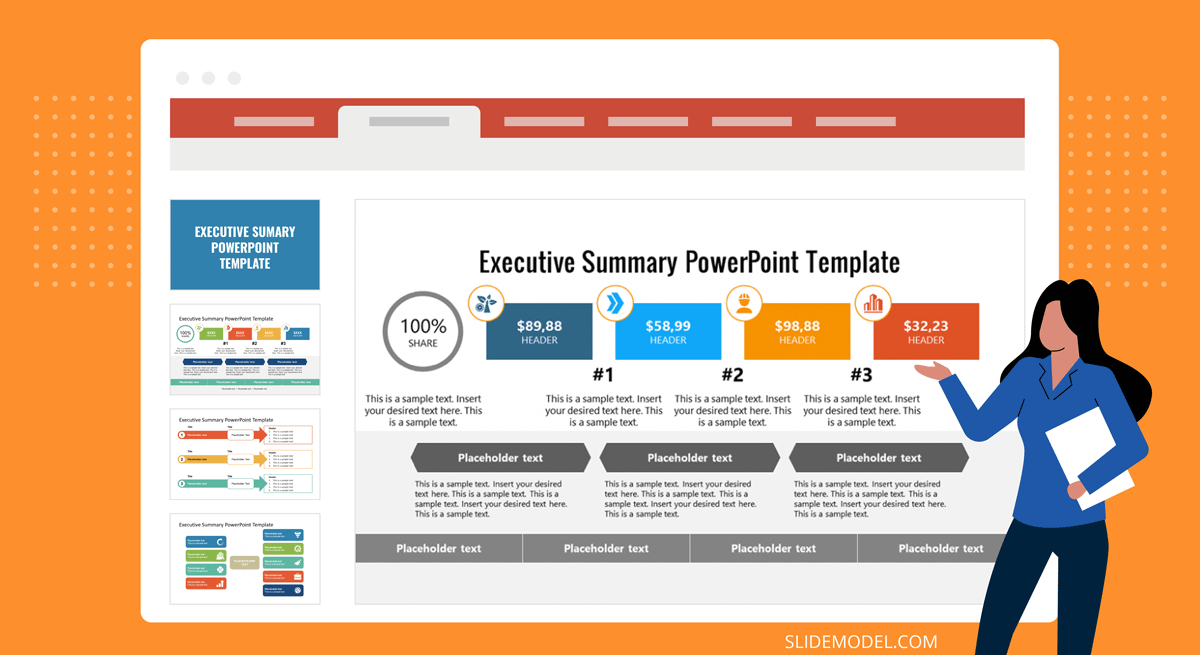
You can build an entire slide deck tailored for an executive summary or business presentation by using our AI Presentation Maker . Fill the topic, analyze & edit the proposed outline, and select a design. That’s it! You can create an engaging executive summary slide deck with any number of slides.
What Makes a Good Executive Summary Slide?
A good executive summary slide visually communicates all the important information from the full report. Typically, it’s an even more condensed version of the written executive summary, prefacing the document. Thus to create a good executive summary slide, be prepared to do some ruthless editing.
Include a condensed version of the:
- Main problem statement or report agenda
- Key findings. Prioritize quantifiable ones
- Recommendations and next steps.
Also, you will need some PowerPoint design mastery to ensure that an executive summary in your PowerPoint presentation looks compelling, but not cluttered. Prioritize white space. Here is where a good executive summary template can make your life easier. To minimize the number of texts, add icons and other simple visualizations. Trim headers and subheads to give the slide even more breathing room.
For those looking to create an engaging and visually appealing presentation, consider utilizing professional presentation templates to enhance the visuals of your executive summary slide. These templates are specifically designed to help presenters convey their message effectively and with style, ensuring that your audience remains captivated and fully understands the key points of your report.
How to Write an Executive Summary for a Presentation
Most likely you won’t need to write a brand new copy for this slide, but rather adapt the text at hand. That already makes your job a lot easier when summarizing a presentation into an executive summary slide. Still, you don’t want to mess anything up. So stick with the executive summary template you’ve chosen and fill in the gaps using our tips.
1. Keep the Tone Consistent
Use the same tone of voice and word choices in your slide deck as you’ve adopted in the report. If the tone of your presentation speech differs too much with terms used on the slide and in the report copy, some audience members may get confused, and then disengaged.
2. Focus on Telling a Story
Stakeholders will have the extra time to read the “dry” report. During the presentation, your main goal is to draw their attention to the most important issue, showcase the value-packed inside the report, and make them eager to learn more by actually flipping the full copy afterward.
3. Chop Full Sentences into Bullet Points
Go snappy and present information in a snackable manner. Remember, our brain can only keep 3-5 items at once in the working memory. So you shouldn’t try to overload the audience with a long list of “very important points” in one sitting.
Also, per a recent presentation survey, among the 3 things that annoy audiences most about presentations are slides that include full sentences of text. So, when working on your presentation summary slide, trim those lengthy texts and move on some of the other points to separate slides.
4. Don’t Go Data Galore
Including numbers and data visualizations is a great way to present your executive summary. However, overloading your data slides with data nuggets makes your presentation less impactful.
As presentation design expert Nancy Duarte explains :
“Data slides aren’t really about the data. They’re about the meaning of the data. It’s up to you to make that meaning clear before you click away. Otherwise, the audience won’t process — let alone buy — your argument.”
It’s a good idea to spotlight 3 main data points on your executive summary slide. Then use some extra minutes to comment on why you’ve chosen to present these.
To Conclude
An executive summary is the first page and/or slide a reader will see. That’s why the stakes are high to make it look just right. Granted, that shouldn’t be an issue. Since you now know how to write, design, and present a compelling executive summary to others!
1. Project Summary PowerPoint Template
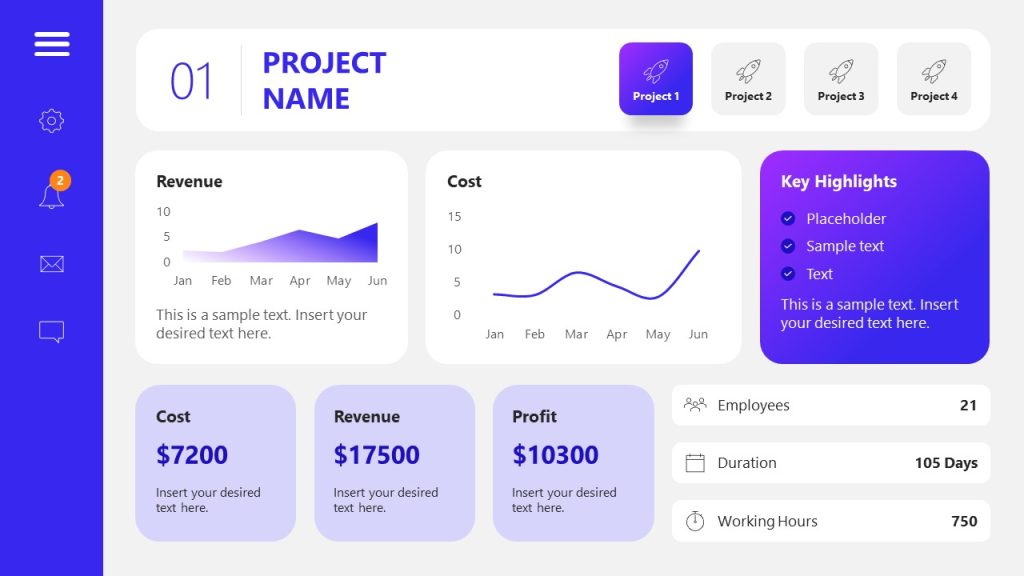
Use This Template
2. Simple Executive Summary Slide Template for PowerPoint
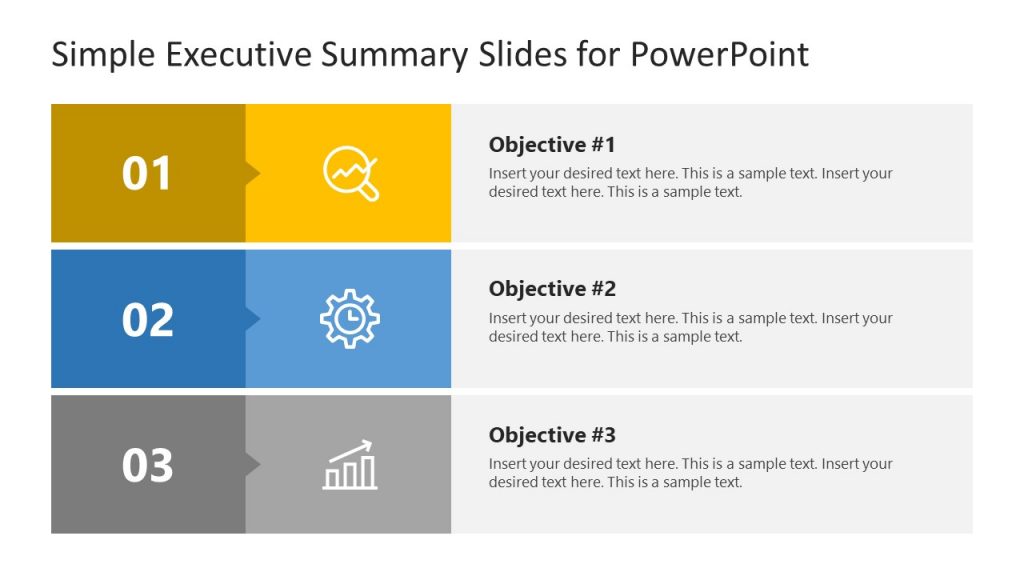
3. One Page Strategy Summary PowerPoint Template
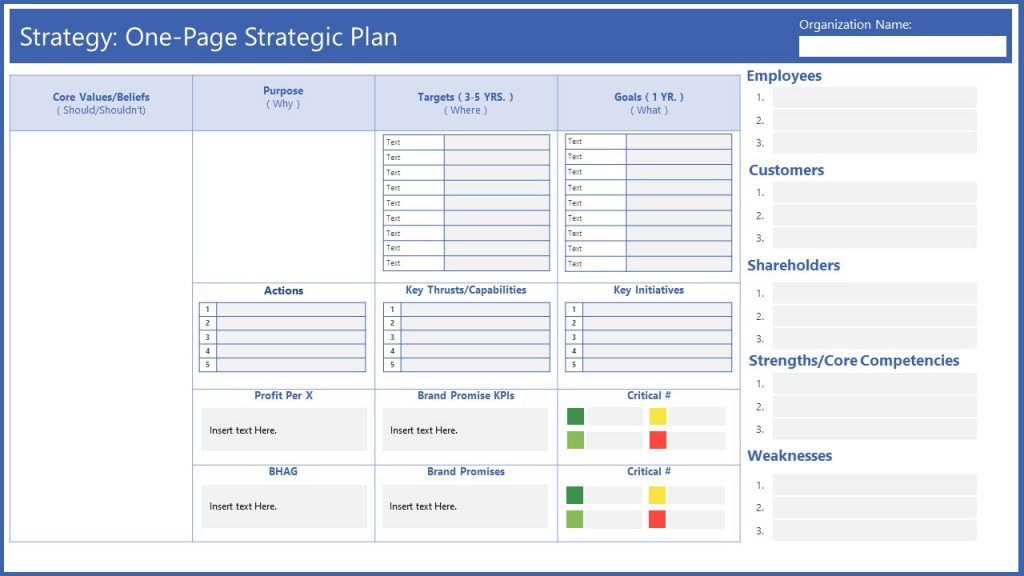
4. Executive Summary PowerPoint Template
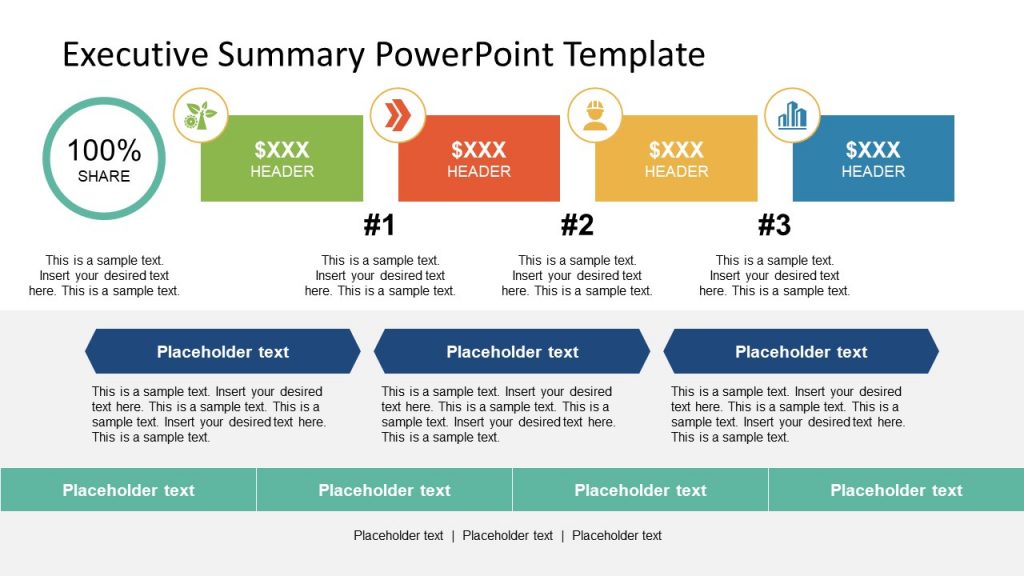
5. Executive Business PowerPoint Template

Like this article? Please share
Executive Reports, Executive Summary Filed under Business
Related Articles
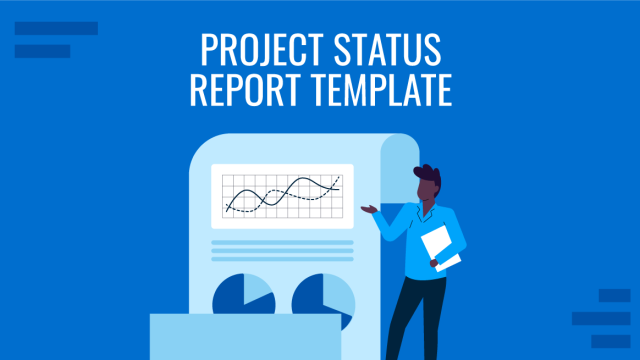
Filed under Business • August 31st, 2023
How to Build a Project Status Report Template: Complete Guide
Project status reports provide timely insights into project progress. Here are practical tips and a one-pager template for concise updates.
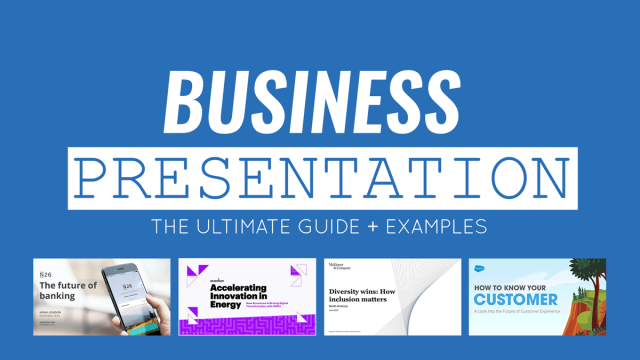
Filed under Business • October 25th, 2022
Business Presentation: The Ultimate Guide to Making Powerful Presentations (+ Examples)
A business presentation is a purpose-led summary of key information about your company’s plans, products, or practices, designed for either internal or external audiences. This guide teaches you how to design and deliver excellent business presentations. Plus, breaks down some best practices from business presentation examples by popular companies.
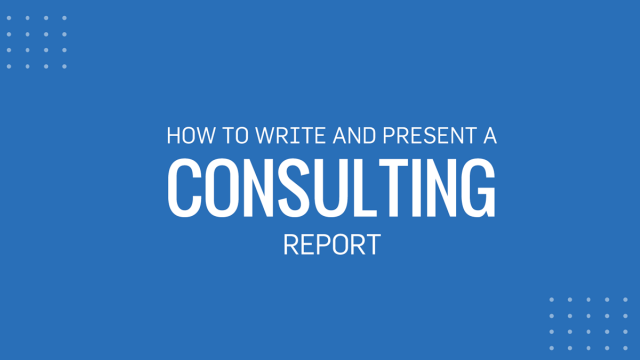
Filed under Business • October 7th, 2022
Consulting Report: How to Write and Present One
Consultants have many tools of the trade at their disposal: Frameworks, analytics dashboards, data science models, and more. Yet many clients still expect to receive a narrated consulting report. So how do you write one? This guide will show you.
Leave a Reply
- Strategy Templates
Consulting Templates
- Market Analysis Templates

- Business Case

- Consulting Proposal
All Templates
How to write an effective executive summary like a mckinsey or bcg consultant.

Table of contents
Key components of an effective executive summary, an in-depth look at each component of the executive summary (with examples), some practical tips and tricks, the bottom line.
Management consultants at firms like McKinsey, BCG, and Bain are renowned for their ability to present complex ideas in a clear, concise manner that is easy to digest and understand. A key component of this process is the executive summary slide – often presented as the first part of a presentation deck on a given topic or problem.
An executive summary aims to provide the audience with an overview of the subject at hand or a snapshot of the key points that will be discussed in greater depth. It should serve to quickly get the main messages and conclusions across and motivate audiences to dive deeper into the details.
In this post, we will outline the essential components of an effective executive summary using techniques from McKinsey, BCG, and Bain. We will also provide tips on how to craft a compelling executive summary in practice and give examples of best practices.
For a broader view on how to create consultant-style presentations take a look at our blog post 'How McKinsey Consultants Make PowerPoint Presentations' .
A good executive summary provides all the key information in one slide. The goal is to communicate as much information in as few words as possible.
To achieve this goal, you should focus on the following key components when crafting an executive summary slide:
- [optional] Objective: Clearly state the purpose and objective of the presentation.
- Situation: Provide relevant background information to set the context for the problem or opportunity being addressed.
- Complication: Define the complication (problem or opportunity) the presentation addresses in simple, to-the-point sentences. This includes identifying the root cause of the problem or opportunity and its implications for the organization.
- Resolution: Present the recommended solution or solutions to the complication in a clear and concise manner. This should be based on data-driven insights and analysis.
- [optional] Benefits: Articulate the benefits of implementing the recommended solution. These benefits should be linked to the organization's strategic objectives.
- Call to Action: Provide a clear call to action outlining what the organization needs to do to implement the recommended solution. This should be actionable and linked to the organization's strategic objectives.
This structure is similar to the SCQA (situation-complication-question-answer) framework.
Craft effective executive summaries for your consulting presentations .
Let's take a closer look at each component of the executive summary and how it can be used to craft an effective executive summary deck using the McKinsey/BCG/Bain methodology.
1. Objective
The objective of the executive summary should succinctly define the purpose of the presentation and why it is important for the audience to understand the key points.
To craft an effective objective, you should consider the following:
- Who is the target audience?
- What are the key points that the audience needs to understand?
- What is the purpose of the presentation?
- Why is it important for the audience to understand the key points?
An effective objective should be brief, clear, and focused on the needs of the audience. It should be written to clearly communicate what the presentation will cover and why it matters.
Example: "This presentation will provide an overview of the current state of the industry and highlight key trends and opportunities for growth."
2. Situation
The background or situation section of the executive summary provides relevant context to the audience to help them better understand the problem or opportunity being addressed.
This section should include:
- Relevant background information on the industry, market, or organization.
- Any key trends or developments that are important to the problem or opportunity being addressed.
- Any relevant historical information that helps to explain the current situation.
Some questions to ask when crafting the background section include:
- What is the context for the problem or opportunity being addressed?
- What are the key factors that have led to the current situation?
- What are the relevant historical or industry-specific factors that are important to understanding the problem or opportunity?
An effective background section should be concise and focused on the most important information. It should provide enough context for the audience to understand the problem or situation being addressed without overwhelming them with unnecessary information.
Here are some examples from McKinsey and BCG:
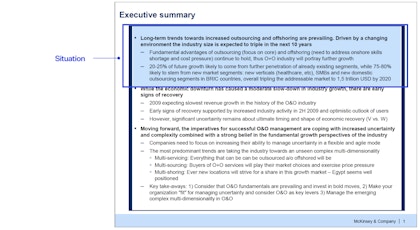
3. Complication
The complication section of the executive summary clearly and concisely defines the reason the situation requires action, either because there is a serious problem or there is a good opportunity. This includes identifying the root cause of the problem or opportunity and its implications for the organization.
- What is the problem or opportunity that the presentation is addressing?
- What are the root causes of the problem or opportunity?
- What are the implications of the problem or opportunity for the organization?
An effective complication section should be short and to-the-point, focusing on the most important aspects of the problem or opportunity. The root cause of the complication should be clearly identified, along with the most relevant data or evidence that supports this analysis. In addition, the implications of the problem or opportunity for the organization should be clearly articulated, highlighting why it is important for the audience to understand the problem/opportunity and its impact and why it requires action.
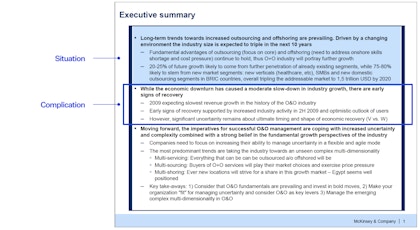
Enhance your proposal writing with our Consulting Proposal template , or explore our collection of 10 Real Consulting Proposals .
4. Resolution
The resolution section of the executive summary presents the proposed solution or strategy for addressing the complication. This should include a brief overview of the approach and any relevant supporting information or evidence.
- What is the proposed approach for addressing the problem or opportunity?
- What are the key elements of the strategy?
- What are the expected benefits or outcomes of the approach?
- What evidence is there to support the proposed solution or strategy?
An effective resolution section should provide enough detail for the audience to understand what is being proposed and why without overwhelming them with unnecessary detail. The proposed approach and any relevant supporting information or evidence should be clearly outlined. In addition, the expected benefits or outcomes of the approach should be highlighted, as this helps to emphasize why it is important for the audience to understand and support the proposed solution.
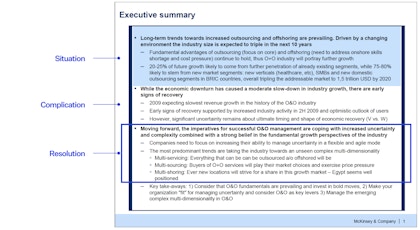
5. Benefits
The benefits section of the executive summary presents a brief overview of any expected benefits or outcomes from implementing the proposed solution. This section is optional, and sometimes included as a bullet point under the resolution section.
- What are the primary benefits or outcomes of implementing the proposed solution?
- What are the secondary benefits or outcomes?
- How will these benefits impact the organization and its stakeholders?
An effective benefits section should provide a clear and concise overview of any expected benefits or outcomes from implementing the proposed solution. The primary benefits should be highlighted, as well as any secondary benefits that are relevant to the audience. Emphasis should be on quantifiable benefits.
In addition, the impact of these benefits on the organization and its stakeholders should be emphasized, highlighting why it is important for the audience to understand and support the proposed solution.
Example: "The proposed approach will generate an incremental $10 million in revenue, reduce costs by 5%, and increase customer satisfaction by 10%. This will help to improve profitability, create new growth opportunities, and strengthen our competitive position in the sector."
6. Call to Action
The call to action section of the executive summary presents a brief overview of key proposed actions or decisions that need to be taken by the audience in order to implement the proposed solution. This section is also sometimes a bullet point under the resolution section.
- What are the proposed actions or decisions that need to be taken?
- Who needs to take these actions or make these decisions?
- What is the timeline for implementing the proposed solution?
An effective call to action/recommendation section should provide a clear and concise overview of any proposed actions or decisions that need to be taken by the audience. The proposed actions or decisions and who needs to take these actions or make these decisions should be clearly outlined.
In addition, the timeline for implementing the proposed solution should be highlighted, ensuring that the audience understands when and how these actions or decisions need to be taken.
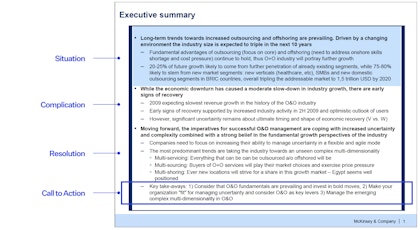
Apply these summary techniques in your Business Strategy template .
- Consultants typically communicate in a 'top down' or pyramid fashion, starting with the conclusion and then providing the supporting information.
- Write the most important takeaway of each section as the bolded text and follow with numbers and other supporting facts as bullet points.
- Read through the bolded text and see if the story makes sense.
- Spend the majority of the executive summary focusing on the solution/recommendation, rather than the situation and supporting analysis.
- The executive summary is not a play-by-play summary of a project. Instead, it is a decision document for your audience to understand the proposed solutions they have to decide on, and just enough information to set the solution in context and grasp the expected outcomes.
- Read through your executive summary and remove anything that is not directly relevant to deciding/agreeing with your proposed solution.
- Try to keep the executive summary as a single slide (sometimes two).
- Eliminate unnecessary words and sentences, and make sure that each sentence adds value to the overall message.
Creating executive summary slides like a McKinsey consultant can have a significant impact on the success of your communication and decision-making efforts. Although it seems simple and many people treat the executive summary like an after-thought, it should in fact be one of the slides you spend the most time on in any presentation.
A well-crafted executive summary helps you structure your entire presentation by making you focus on the solution you are proposing and only keeping in analyses and arguments that help explain the why, what, and how of that solution.
By following the essential components and strategies outlined above you can create a clear, concise, and compelling executive summary that effectively communicates complex ideas and drives action.
Cheat sheet
What is an executive summary exactly?
A short summary of the key messages and conclusions in a longer presentation, focused on actionable solutions or recommendations. In McKinsey and BCG consulting presentations the executive summary is typically one or two slides, but sometimes executive summary can also refer to a short deck.
What does an executive summary include and how do I write one?
See our 'How to' guide in this post.
Does an executive summary come before or after the table of contents?
Typically before the table of contents, as the first (or one of the first) slides after a title page.
Is there a good executive summary slide example?
Yes, you can download some examples from McKinsey and BCG here . You can also see full presentations from BCG and McKinsey here and here .
Or take a look at our full Business Strategy template or our Business Case template for real-life client examples.
Should I include visuals?
Generally McKinsey and BCG executive summaries do not include visuals, except perhaps icons to make the summary more visually appealing.
Download our most popular templates
High-end PowerPoint templates and toolkits created by ex-McKinsey, BCG, and Bain consultants
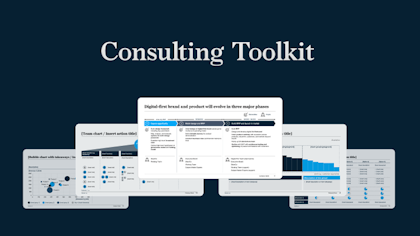
Consulting toolkit and template
A comprehensive library of slide layouts, templates, and typically consulting tools and frameworks.
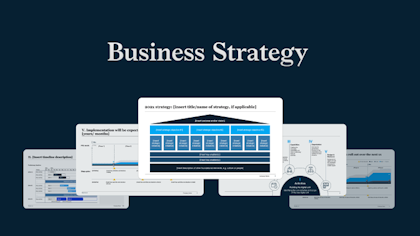
- Business Strategy
This template, created by ex-McKinsey and BCG consultants, includes everything you need to create a complete strategy.
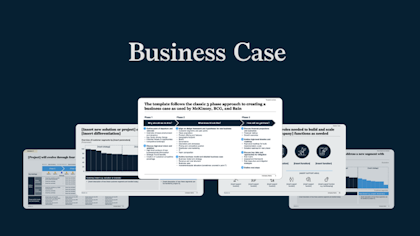
Create a full business case incl. strategy, roadmap, financials and more.
Related articles
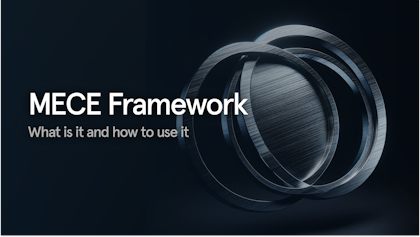
What is the MECE Framework – McKinsey Toolbox
In this post, we cover the MECE principle and how you can apply it to sharpen your thinking and simplify complex ideas into something that can easily be understood.
Dec 6, 2023
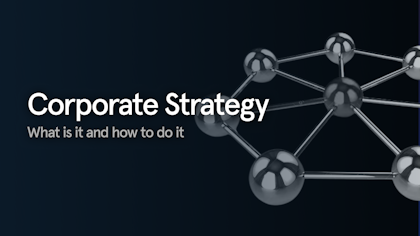
Corporate Strategy: What Is It and How To Do It (With Examples)
In this post, we'll cover corporate strategy as defined by BCG, McKinsey, and Bain. We'll go over what corporate strategy is, the key elements in defining a corporate strategy, examples of corporate strategies, and typical mistakes.
Nov 22, 2023

What are the Three Levels of Strategy in Organizations?
The three levels of strategy are corporate level strategy, business level strategy, and functional level strategy. In this article, we explain the differences and give you practical tips and tricks for each based on our experience at McKinsey, BCG, and Bain.
Nov 8, 2023

- Consulting Toolkit
- Market Analysis
- Market Entry Analysis
- Due Diligence Report
- Mergers & Acquisitions
- Digital Transformation
- Product Strategy
- Go-To-Market Strategy
- Operational Excellence I
- Operational Excellence II
- Operational Excellence III
- Consulting PowerPoint Templates
- How it works
- Terms & Conditions
- Privacy Policy
© 2023 Slideworks. All rights reserved
Denmark : Farvergade 10 4. 1463 Copenhagen K
US : 101 Avenue of the Americas, 9th Floor 10013, New York
How To Write Consulting Executive Summary Slides [BCG Example]
Table of contents.
If you’re anything like me, then y ou build all of the main body slides in your slide decks, sharpen the text , perfect your visualizations … and then quickly throw together an executive summary slide.
The problem? The executive summary slide is the first impression of your deck and the only place that the reader can get a complete overview of your argument.
Therefore, executive summary slides shouldn’t be an afterthought. In fact, it’s important to spend significant time writing a strong executive summary that clearly articulates your argument and inspires your reader to act.
What is an executive summary slide?
An executive summary is a written overview of the main points or arguments of a larger document, memo or other report.
Strategy consultants also write executive summaries for their presentations or slide decks.
An executive summary slide is the first slide in your presentation that fully summarizes the argument, storyline, and supporting evidence of the body slides.

Download 120+ strategy consulting presentations for free
Looking for slide inspiration? Download 120+ consulting slide decks from top strategy consulting firms, such as McKinsey, BCG and Bain!
Why do you need executive summary slides?
As a reader, it’s so easy to get lost in a PowerPoint slide deck. You need to keep previous slides and messages in your mind, follow the line of argument, and somehow put everything together into a coherent story that you can make sense of.
Executive summary slides help the reader “follow along” with your slide deck. There are a few main benefits:
- Executive summaries provide context to help the reader understand why the topic of the slide deck is important.
- Executive summaries communicate the high-level argument before the reader gets into the body of the slide deck. This helps the reader understand your more detailed body slides.
- Executive summaries are a “map” that the reader can reference back to if they start losing the line of argument in the body of the deck.
How to write executive summary slides
To understand the best practices of writing executive summary slides, we’re going to break down a BCG executive summary.
In doing so, we’re going to learn the simple framework for writing executive summary slides that is used by strategy consultants, such as McKinsey & Co, Bain, and BCG.
Below you can see an example of a BCG executive summary. This slide deck is a BCG report on “Melbourne as a Global Cultural Destination” and can be downloaded here .
Here are the two main executive summary slides:
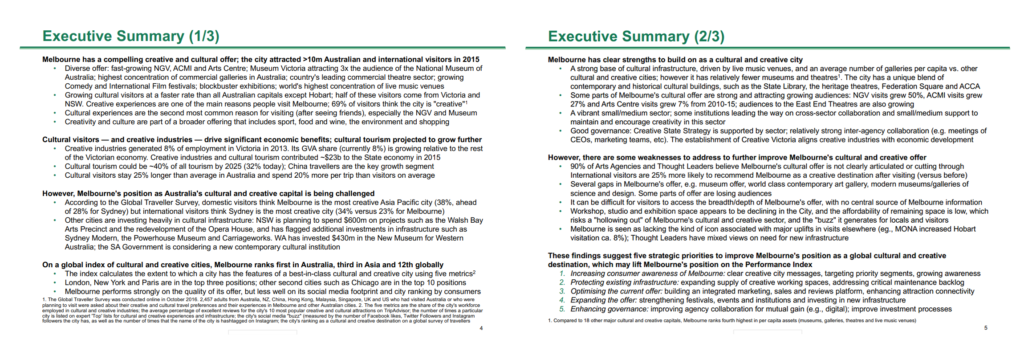
These BCG executive summary slides are a great example of an executive summary done well. So we’ll use them to describe best practices.
Best practice #1: Bold text for summary sentences, bullet points for supporting data
One of the first things you’ll notice about the BCG executive summary is the bold-bullet structure.
The bold sentences denote key statements or claims, and the bullet points support those statements (usually with data).
If there was no evidence to support their claims — or if the evidence was buried deep in the slide deck — then the reader could quite easily doubt the validity of the claim, and ultimately the end conclusion of the slide deck.
So one of the key aspects of strategy consulting slide decks is that no claim is made without evidence. And that includes the executive summary.
Let’s zoom in on one example:

The key statement in this part of the executive summary is “there are weaknesses in Melbourne’s cultural and creative offer”.
This claim is supported by a bunch of data points, such as 90% of agencies and thought leaders believe the cultural offer is not clearly articulated.
Best practice #2: Bold summary sentences can be read alone to tell a story
Executives are busy people and many of them aren’t interested in diving into the supporting bullet points. They will simply read through your bolded summary sentences to understand the high-level argument and recommendations.
This means that your executive summary should be “skimmable by design”.
In other words, your bolded summary sentences should tell a complete and logical story without requiring the supporting data in the bullet points below.
Let’s read just the bolded sentences in our BCG executive summary:
Melbourne has a compelling creative and cultural offer; the city attracted >10m Australian and international visitors in 2015. Cultural visitors and creative industries drive significant economic benefits; cultural tourism projected to grow further. However, Melbourne’s position as Australia’s cultural and creative capital is being challenged. On a global index of cultural and creative cities, Melbourne ranks first in Australia, third in Asia and 12th globally. Melbourne has clear strengths to build on as a cultural and creative city. However, there are some weaknesses to address to further improve Melbourne’s cultural and creative offer. These findings suggest five strategic priorities to improve Melbourne’s position as a global cultural and creative destination, which may lift Melbourne’s position on the Performance Index.
It reads just like a narrative!
Despite ignoring all the bullet points, we can still fully understand the argument that BCG is making in their executive summary (which is also reflected in the body of the slide deck).
Best practice #3: The executive summary should reflect the ‘SCR storyline’ structure of the slide deck
It’s not good enough to just “tell a story”, you need a tell the story using a particular structure.
The structure used by strategy consulting firms, such as McKinsey & Co, Bain, and BCG, is the ‘situation, complication, resolution’ structure.
As an aside, you can learn more about how to craft a compelling argument and SCR storyline for your slide deck in our Complete Guide To Building Strategy Presentations . If you haven’t read that guide, you should check it out.
Let’s take a look at how the SCR storyline applies to your slide deck:
- What baseline knowledge do people need to have before they understand our argument?
- How did this problem come about?
Complication
- What is the problem we need to solve?
- Why is this particular problem important to solve?
- How do we respond / solve the problem?
- What are the specific recommendations and/or next steps?
Your executive summary slide should communicate the complete storyline in your slide deck. And thus it should also follow the situation, complication, resolution structure.
In our BCG example, you can clearly see the SCR structure in action:
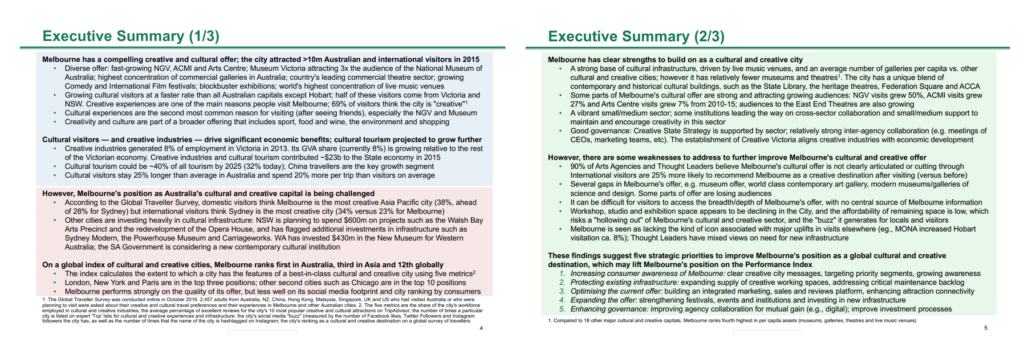
It’s important to set the context with the situation, as there’s no guarantee that all of you readers will have the background knowledge to understand your argument. It also gives you the opportunity to explain the causes of the problem that you’re addressing in the slide deck.
Then, in the complication section, you should succinctly define the problem and why it is important to solve. Some people suggest that you use a question format, for example “How can Melbourne improve its position as a global cultural and creative destination?”, although that’s really just a matter of style.
Finally, you need to clearly articulate your proposed resolution or “answer” to the problem. You’ll note that most of the executive summary real-estate is spent on the resolution component. From a reader’s perspective, the recommendations are the most important part of the slide deck.
Executive summary slide examples
Below you’ll find examples of executive summary slides from consulting firms like Bain & Co, BCG, L.E.K. Consulting, Oliver Wyman, and others.
![How To Write Consulting Executive Summary Slides [BCG Example] Bain executive summary slide](https://slidescience.co/wp-content/uploads/2021/09/Bain-executive-summary-slide.jpg)
.css-s5s6ko{margin-right:42px;color:#F5F4F3;}@media (max-width: 1120px){.css-s5s6ko{margin-right:12px;}} Join us: Learn how to build a trusted AI strategy to support your company's intelligent transformation, featuring Forrester .css-1ixh9fn{display:inline-block;}@media (max-width: 480px){.css-1ixh9fn{display:block;margin-top:12px;}} .css-1uaoevr-heading-6{font-size:14px;line-height:24px;font-weight:500;-webkit-text-decoration:underline;text-decoration:underline;color:#F5F4F3;}.css-1uaoevr-heading-6:hover{color:#F5F4F3;} .css-ora5nu-heading-6{display:-webkit-box;display:-webkit-flex;display:-ms-flexbox;display:flex;-webkit-align-items:center;-webkit-box-align:center;-ms-flex-align:center;align-items:center;-webkit-box-pack:start;-ms-flex-pack:start;-webkit-justify-content:flex-start;justify-content:flex-start;color:#0D0E10;-webkit-transition:all 0.3s;transition:all 0.3s;position:relative;font-size:16px;line-height:28px;padding:0;font-size:14px;line-height:24px;font-weight:500;-webkit-text-decoration:underline;text-decoration:underline;color:#F5F4F3;}.css-ora5nu-heading-6:hover{border-bottom:0;color:#CD4848;}.css-ora5nu-heading-6:hover path{fill:#CD4848;}.css-ora5nu-heading-6:hover div{border-color:#CD4848;}.css-ora5nu-heading-6:hover div:before{border-left-color:#CD4848;}.css-ora5nu-heading-6:active{border-bottom:0;background-color:#EBE8E8;color:#0D0E10;}.css-ora5nu-heading-6:active path{fill:#0D0E10;}.css-ora5nu-heading-6:active div{border-color:#0D0E10;}.css-ora5nu-heading-6:active div:before{border-left-color:#0D0E10;}.css-ora5nu-heading-6:hover{color:#F5F4F3;} Register now .css-1k6cidy{width:11px;height:11px;margin-left:8px;}.css-1k6cidy path{fill:currentColor;}
- Project planning |
- How to write an executive summary, with ...
How to write an executive summary, with examples

The best way to do that is with an executive summary. If you’ve never written an executive summary, this article has all you need to know to plan, write, and share them with your team.
What is an executive summary?
An executive summary is an overview of a document. The length and scope of your executive summary will differ depending on the document it’s summarizing, but in general an executive summary can be anywhere from one to two pages long. In the document, you’ll want to share all of the information your readers and important stakeholders need to know.
Imagine it this way: if your high-level stakeholders were to only read your executive summary, would they have all of the information they need to succeed? If so, your summary has done its job.
You’ll often find executive summaries of:
Business cases
Project proposals
Research documents
Environmental studies
Market surveys
Project plans
In general, there are four parts to any executive summary:
Start with the problem or need the document is solving.
Outline the recommended solution.
Explain the solution’s value.
Wrap up with a conclusion about the importance of the work.
What is an executive summary in project management?
In project management, an executive summary is a way to bring clarity to cross-functional collaborators, team leadership, and project stakeholders . Think of it like a project’s “ elevator pitch ” for team members who don’t have the time or the need to dive into all of the project’s details.
The main difference between an executive summary in project management and a more traditional executive summary in a business plan is that the former should be created at the beginning of your project—whereas the latter should be created after you’ve written your business plan. For example, to write an executive summary of an environmental study, you would compile a report on the results and findings once your study was over. But for an executive summary in project management, you want to cover what the project is aiming to achieve and why those goals matter.
The same four parts apply to an executive summary in project management:
Start with the problem or need the project is solving. Why is this project happening? What insight, customer feedback, product plan, or other need caused it to come to life?
Outline the recommended solution, or the project’s objectives. How is the project going to solve the problem you established in the first part? What are the project goals and objectives?
Explain the solution’s value. Once you’ve finished your project, what will happen? How will this improve and solve the problem you established in the first part?
Wrap up with a conclusion about the importance of the work. This is another opportunity to reiterate why the problem is important, and why the project matters. It can also be helpful to reference your audience and how your solution will solve their problem. Finally, include any relevant next steps.
If you’ve never written an executive summary before, you might be curious about where it fits into other project management elements. Here’s how executive summaries stack up:
Executive summary vs. project plan
A project plan is a blueprint of the key elements your project will accomplish in order to hit your project goals and objectives. Project plans will include your goals, success metrics, stakeholders and roles, budget, milestones and deliverables, timeline and schedule, and communication plan .
An executive summary is a summary of the most important information in your project plan. Think of the absolutely crucial things your management team needs to know when they land in your project, before they even have a chance to look at the project plan—that’s your executive summary.
Executive summary vs. project overview
Project overviews and executive summaries often have similar elements—they both contain a summary of important project information. However, your project overview should be directly attached to your project. There should be a direct line of sight between your project and your project overview.
While you can include your executive summary in your project depending on what type of project management tool you use, it may also be a stand-alone document.
Executive summary vs. project objectives
Your executive summary should contain and expand upon your project objectives in the second part ( Outline the recommended solution, or the project’s objectives ). In addition to including your project objectives, your executive summary should also include why achieving your project objectives will add value, as well as provide details about how you’re going to get there.
The benefits of an executive summary
You may be asking: why should I write an executive summary for my project? Isn’t the project plan enough?
Well, like we mentioned earlier, not everyone has the time or need to dive into your project and see, from a glance, what the goals are and why they matter. Work management tools like Asana help you capture a lot of crucial information about a project, so you and your team have clarity on who’s doing what by when. Your executive summary is designed less for team members who are actively working on the project and more for stakeholders outside of the project who want quick insight and answers about why your project matters.
An effective executive summary gives stakeholders a big-picture view of the entire project and its important points—without requiring them to dive into all the details. Then, if they want more information, they can access the project plan or navigate through tasks in your work management tool.
How to write a great executive summary, with examples
Every executive summary has four parts. In order to write a great executive summary, follow this template. Then once you’ve written your executive summary, read it again to make sure it includes all of the key information your stakeholders need to know.
1. Start with the problem or need the project is solving
At the beginning of your executive summary, start by explaining why this document (and the project it represents) matter. Take some time to outline what the problem is, including any research or customer feedback you’ve gotten . Clarify how this problem is important and relevant to your customers, and why solving it matters.
For example, let’s imagine you work for a watch manufacturing company. Your project is to devise a simpler, cheaper watch that still appeals to luxury buyers while also targeting a new bracket of customers.
Example executive summary:
In recent customer feedback sessions, 52% of customers have expressed a need for a simpler and cheaper version of our product. In surveys of customers who have chosen competitor watches, price is mentioned 87% of the time. To best serve our existing customers, and to branch into new markets, we need to develop a series of watches that we can sell at an appropriate price point for this market.
2. Outline the recommended solution, or the project’s objectives
Now that you’ve outlined the problem, explain what your solution is. Unlike an abstract or outline, you should be prescriptive in your solution—that is to say, you should work to convince your readers that your solution is the right one. This is less of a brainstorming section and more of a place to support your recommended solution.
Because you’re creating your executive summary at the beginning of your project, it’s ok if you don’t have all of your deliverables and milestones mapped out. But this is your chance to describe, in broad strokes, what will happen during the project. If you need help formulating a high-level overview of your project’s main deliverables and timeline, consider creating a project roadmap before diving into your executive summary.
Continuing our example executive summary:
Our new watch series will begin at 20% cheaper than our current cheapest option, with the potential for 40%+ cheaper options depending on material and movement. In order to offer these prices, we will do the following:
Offer watches in new materials, including potentially silicone or wood
Use high-quality quartz movement instead of in-house automatic movement
Introduce customizable band options, with a focus on choice and flexibility over traditional luxury
Note that every watch will still be rigorously quality controlled in order to maintain the same world-class speed and precision of our current offerings.
3. Explain the solution’s value
At this point, you begin to get into more details about how your solution will impact and improve upon the problem you outlined in the beginning. What, if any, results do you expect? This is the section to include any relevant financial information, project risks, or potential benefits. You should also relate this project back to your company goals or OKRs . How does this work map to your company objectives?
With new offerings that are between 20% and 40% cheaper than our current cheapest option, we expect to be able to break into the casual watch market, while still supporting our luxury brand. That will help us hit FY22’s Objective 3: Expanding the brand. These new offerings have the potential to bring in upwards of three million dollars in profits annually, which will help us hit FY22’s Objective 1: 7 million dollars in annual profit.
Early customer feedback sessions indicate that cheaper options will not impact the value or prestige of the luxury brand, though this is a risk that should be factored in during design. In order to mitigate that risk, the product marketing team will begin working on their go-to-market strategy six months before the launch.
4. Wrap up with a conclusion about the importance of the work
Now that you’ve shared all of this important information with executive stakeholders, this final section is your chance to guide their understanding of the impact and importance of this work on the organization. What, if anything, should they take away from your executive summary?
To round out our example executive summary:
Cheaper and varied offerings not only allow us to break into a new market—it will also expand our brand in a positive way. With the attention from these new offerings, plus the anticipated demand for cheaper watches, we expect to increase market share by 2% annually. For more information, read our go-to-market strategy and customer feedback documentation .
Example of an executive summary
When you put it all together, this is what your executive summary might look like:
![how to create an executive summary presentation [Product UI] Example executive summary in Asana (Project Overview)](https://assets.asana.biz/transform/8aa7d41f-aed9-4f82-bb7a-4305cea4404d/inline-project-planning-executive-summary-examples-1-2x?io=transform:fill,width:2560&format=webp)
Common mistakes people make when writing executive summaries
You’re not going to become an executive summary-writing pro overnight, and that’s ok. As you get started, use the four-part template provided in this article as a guide. Then, as you continue to hone your executive summary writing skills, here are a few common pitfalls to avoid:
Avoid using jargon
Your executive summary is a document that anyone, from project contributors to executive stakeholders, should be able to read and understand. Remember that you’re much closer to the daily work and individual tasks than your stakeholders will be, so read your executive summary once over to make sure there’s no unnecessary jargon. Where you can, explain the jargon, or skip it all together.
Remember: this isn’t a full report
Your executive summary is just that—a summary. If you find yourself getting into the details of specific tasks, due dates, and attachments, try taking a step back and asking yourself if that information really belongs in your executive summary. Some details are important—you want your summary to be actionable and engaging. But keep in mind that the wealth of information in your project will be captured in your work management tool , not your executive summary.
Make sure the summary can stand alone
You know this project inside and out, but your stakeholders won’t. Once you’ve written your executive summary, take a second look to make sure the summary can stand on its own. Is there any context your stakeholders need in order to understand the summary? If so, weave it into your executive summary, or consider linking out to it as additional information.
Always proofread
Your executive summary is a living document, and if you miss a typo you can always go back in and fix it. But it never hurts to proofread or send to a colleague for a fresh set of eyes.
In summary: an executive summary is a must-have
Executive summaries are a great way to get everyone up to date and on the same page about your project. If you have a lot of project stakeholders who need quick insight into what the project is solving and why it matters, an executive summary is the perfect way to give them the information they need.
For more tips about how to connect high-level strategy and plans to daily execution, read our article about strategic planning .
Related resources

Unmanaged business goals don’t work. Here’s what does.

How Asana uses work management to drive product development

How Asana uses work management to streamline project intake processes

How Asana uses work management for smoother creative production

How it works
Transform your enterprise with the scalable mindsets, skills, & behavior change that drive performance.
Explore how BetterUp connects to your core business systems.
We pair AI with the latest in human-centered coaching to drive powerful, lasting learning and behavior change.
Build leaders that accelerate team performance and engagement.
Unlock performance potential at scale with AI-powered curated growth journeys.
Build resilience, well-being and agility to drive performance across your entire enterprise.
Transform your business, starting with your sales leaders.
Unlock business impact from the top with executive coaching.
Foster a culture of inclusion and belonging.
Accelerate the performance and potential of your agencies and employees.
See how innovative organizations use BetterUp to build a thriving workforce.
Discover how BetterUp measurably impacts key business outcomes for organizations like yours.
A demo is the first step to transforming your business. Meet with us to develop a plan for attaining your goals.

- What is coaching?
Learn how 1:1 coaching works, who its for, and if it's right for you.
Accelerate your personal and professional growth with the expert guidance of a BetterUp Coach.
Types of Coaching
Navigate career transitions, accelerate your professional growth, and achieve your career goals with expert coaching.
Enhance your communication skills for better personal and professional relationships, with tailored coaching that focuses on your needs.
Find balance, resilience, and well-being in all areas of your life with holistic coaching designed to empower you.
Discover your perfect match : Take our 5-minute assessment and let us pair you with one of our top Coaches tailored just for you.

Research, expert insights, and resources to develop courageous leaders within your organization.
Best practices, research, and tools to fuel individual and business growth.
View on-demand BetterUp events and learn about upcoming live discussions.
The latest insights and ideas for building a high-performing workplace.
- BetterUp Briefing
The online magazine that helps you understand tomorrow's workforce trends, today.
Innovative research featured in peer-reviewed journals, press, and more.
Founded in 2022 to deepen the understanding of the intersection of well-being, purpose, and performance
We're on a mission to help everyone live with clarity, purpose, and passion.
Join us and create impactful change.
Read the buzz about BetterUp.
Meet the leadership that's passionate about empowering your workforce.
For Business
For Individuals
How to write an executive summary in 10 steps

Whether presenting a business plan, sharing project updates with stakeholders, or submitting a project proposal, an executive summary helps you grab attention and convey key insights.
Think of it as a condensed version of a document, report, or proposal that highlights the most important information clearly and concisely. It's like a "cheat sheet" that gives you a snapshot of the main points without reading the entire thing.
Throughout the article, we'll explore some examples of executive summaries to give you a better understanding of how they can be applied. Plus, we'll provide you with ready-to-use templates and best practices for writing compelling executive summaries.
What is an executive summary?
An executive summary is a concise overview of a longer document or report. It is typically written for busy executives or decision-makers who may not have the time to read the entire document but still need to grasp its key points and recommendations.
An effective executive summary should capture the essence of the document, highlighting the most important information in a brief and easily understandable way. It should provide a snapshot of the document's purpose, methodology, major findings, and key recommendations. The summary should be written in a way that allows the reader to quickly grasp the main ideas and make informed decisions based on the information presented.
Why do you need to write one?
For a business owner , an executive summary is one of the most important documents you will have. Like a business plan , they help you lay out the potential value of your business and your potential for success.
Unlike a business proposal, however, an executive summary is designed to be read in a brief amount of time. That makes them ideal for a variety of uses, like project proposals and research summaries. Sending your strategic plan to a prospective investor or stakeholder likely won’t get you far. But a brief report that clearly states your key findings and what’s in it for them might help you — and your proposal — stand out. It isn't all the details. It's what gets you the meeting to share more.
An executive summary is also a business document that can travel without you. It may be presented to other leaders and potential investors. If it’s written well, it will take on a life of its own. You may find that you get support and resources from places you never imagined.
What should be included in an executive summary?
Your executive summary should include brief descriptions of who your product, service, or proposal is for and your competitive advantage. Be sure to introduce your report concisely yet clearly . Note the most important points and its overall purpose––what do you hope to achieve with this report?
Also, include any necessary background information and statistics about the industry, high-level information about your business model, necessary financial information, or other insights you discuss in the report. Depending on your proposal, you may want to consider summarizing a market analysis of your target market.
Typically, an executive summary follows a structured format, including sections such as:
- Introduction: Provides a brief background and context for the document.
- Objective or purpose: Clearly states the goal of the document and what it aims to achieve.
- Methodology: Briefly describes the approach, data sources, and methods used to conduct the research or analysis.
- Findings: Summarizes the main findings, conclusions, or results derived from the document.
- Recommendations: Outlines the key recommendations or proposed actions based on the findings.
- Conclusion: Provides a concise wrap-up of the main points and emphasizes the significance of the document.

How do you write an executive summary?
When tackling an executive summary, it's all about following a structured approach to ensure you effectively communicate those crucial points, findings, and recommendations. Let’s walk through some steps and best practices to make it a breeze:
Step 1: Get to know the document
Take the time to dive into the full document or report that your executive summary will be based on. Read it thoroughly and identify the main objectives, key findings, conclusions, and recommendations.
Step 2: Know your audience
Think about who you're writing the executive summary for. Consider their knowledge level, interests, and priorities. This helps you tailor the summary to their needs and make it relevant and impactful.
Step 3: Outline the structure
Create an outline for your executive summary with sections like introduction, objective, methodology, findings, recommendations, and conclusion. This way, you'll have a logical flow that's easy to follow.
Step 4: Start strong
Kick off your executive summary with a captivating opening statement. Make it concise, engaging, and impactful to hook the reader and make them want to keep reading.
Step 5: Summarize objectives and methodology
Give a brief overview of the document's objectives and the methodology used to achieve them. This sets the context and helps the reader understand the approach taken.
Step 6: Highlight key findings
Summarize the main findings, conclusions, or results. Focus on the juiciest and most relevant points that support the document's purpose. Keep it clear and concise to get the message across effectively.
Step 7: Present key recommendations
Outline the important recommendations or proposed actions based on the findings. Clearly state what needs to be done, why it matters, and how it aligns with the document's objectives. Make those recommendations actionable and realistic.
Step 8: Keep it snappy
Remember, an executive summary should be short and sweet. Skip unnecessary details, jargon, or technical language . Use straightforward language that hits the mark.
Step 9: Review and polish
Once you've written the executive summary, give it a careful review for clarity, coherence, and accuracy. Make sure it captures the essence of the full document and represents its content faithfully. Take the extra step to edit out any fluff or repetition.
Step 10: Dress to impress
Consider formatting and presentation. Use headings, bullet points, and formatting styles to make it visually appealing and easy to skim. If it makes sense, include some graphs, charts, or visuals to highlight key points.
Tips for writing an effective executive summary
- Adapt your language and tone to suit your audience.
- Keep things concise and crystal clear—say no to jargon.
- Focus on the most important info that packs a punch.
- Give enough context without overwhelming your reader.
- Use strong and persuasive language to make your recommendations shine.
- Make sure your executive summary makes sense even if the full document isn't read.
- Proofread like a pro to catch any pesky grammar, spelling, or punctuation errors.
Executive summary template for business plans
Here's a general template for creating an executive summary specifically for business plans:
[Your Company Name]
[Business Plan Title]
Business overview
Provide a brief introduction to your company, including its name, location, industry, and mission statement . Describe your unique value proposition and what sets your business apart from competitors.
Market analysis
Summarize the key findings of your market research. Provide an overview of the target market, its size, growth potential, and relevant trends. Highlight your understanding of customer needs, preferences, and behaviors.
Product or service offering
Outline your core products or services, including their key features and benefits. Emphasize how your offerings address customer pain points and provide value. Highlight any unique selling points or competitive advantages.
Business model
Explain your business model and revenue generation strategy. Describe how you will generate revenue, the pricing structure, and any distribution channels or partnerships that contribute to your business's success.
Marketing and sales strategy
Summarize your marketing and sales approach. Highlight the key tactics and channels you will use to reach and attract customers. Discuss your promotional strategies, pricing strategies, and customer acquisition plans.
Management team
Introduce the key members of your management team and their relevant experience. Highlight their expertise and how it positions the team to execute the business plan successfully. Include any notable advisors or board members.
Financial projections
Summarize your financial projections, including revenue forecasts, expected expenses, and projected profitability. Highlight any key financial metrics or milestones. Briefly mention your funding needs, if applicable.
Funding requirements
If seeking funding, outline your funding requirements, including the amount needed, its purpose, and the potential sources of funding you are considering. Summarize the expected return on investment for potential investors.
Reiterate the vision and potential of your business. Summarize the key points of your business plan, emphasizing its viability, market potential, and the expertise of your team. Convey confidence in the success of your venture.
Note: Keep the executive summary concise and focused, typically within one to two pages. Use clear and compelling language, emphasizing the unique aspects of your business. Tailor the template to suit your specific business plan, adjusting sections and details accordingly.
Remember, the executive summary serves as an introduction to your business plan and should pique the reader's interest, conveying the value and potential of your business in a concise and persuasive manner.
Executive summary examples
Every executive summary will be unique to the organization's goals, vision, and brand identity. We put together two general examples of executive summaries to spark your creativity and offer some inspiration.
These are not intended to be used as-is but more to offer ideas for how you may want to put your own executive summary together. Be sure to personalize your own summary with specific statistics and relevant data points to make the most impact.
Example 1: executive summary for a communications business plan
Introduction:
We're thrilled to present our innovative [insert product] that aims to revolutionize the way people connect and engage. Our vision is to empower individuals and businesses with seamless communication solutions that break barriers and foster meaningful connections.
Market opportunity:
The communications industry is evolving rapidly, and we've identified a significant opportunity in the market. With the proliferation of remote work, the need for reliable and efficient communication tools has skyrocketed. Our extensive market research indicates a demand for solutions that prioritize user experience, security, and flexibility.
Product offering:
At [Company Name], we've developed a suite of cutting-edge communication tools designed to meet the diverse needs of our customers. Our flagship product is a unified communication platform that integrates voice, video, messaging, and collaboration features into a seamless user experience. We also offer customizable solutions for businesses of all sizes, catering to their unique communication requirements.
Unique value proposition:
What sets us apart from the competition? Our user-centric approach and commitment to innovation. We prioritize user experience by creating intuitive interfaces and seamless interactions. Our solutions are scalable, adaptable, and designed to keep up with evolving technological trends. By combining ease of use with advanced features, we deliver unparalleled value to our customers.
Target market:
Our primary focus is on small and medium-sized businesses (SMBs) that require efficient and cost-effective communication tools. We also cater to individuals, remote teams, and larger enterprises seeking reliable and secure communication solutions. Our target market encompasses industries such as technology, finance, healthcare, and professional services.
Business model:
To generate revenue, we employ a subscription-based business model. Customers can choose from different plans tailored to their specific needs, paying a monthly or annual fee. We also offer additional services such as customization, integration, and customer support, creating additional revenue streams and fostering long-term customer relationships.
Marketing and sales strategy:
Our marketing strategy centers around building brand awareness through targeted digital campaigns, content marketing, and strategic partnerships. We'll leverage social media, industry influencers, and online communities to reach our target audience. Additionally, our sales team will engage in proactive outreach, nurturing leads and providing personalized consultations to convert prospects into loyal customers.
Team and expertise:
Our team is composed of experienced professionals with a deep understanding of the communications industry. Led by our visionary founder and supported by a skilled and diverse team, we have the expertise to drive innovation, develop robust products, and deliver exceptional customer service. We're passionate about our mission and dedicated to making a lasting impact in the market.
Financial projections:
Based on extensive market research and financial analysis, we anticipate strong growth and profitability. Our financial projections indicate steady revenue streams, with increasing customer adoption and market share. We're committed to managing costs effectively, optimizing our resources, and continuously reinvesting in research and development.
Funding requirements:
To fuel our ambitious growth plans and accelerate product development, we're seeking [funding amount] in funding. These funds will be allocated towards expanding our team, scaling our infrastructure, marketing efforts, and ongoing product innovation. We believe this investment will position us for success and solidify our market presence.
Conclusion:
In summary, [Company Name] is poised to disrupt the communications industry with our innovative solutions and customer-centric approach. We're ready to make a positive impact by empowering individuals and businesses to communicate effectively and effortlessly. Join us on this exciting journey as we redefine the future of communication. Together, we'll shape a connected world like never before.
Example 2: executive summary for a project proposal
[Project Name]
[Project Proposal Date]
Hello! We're thrilled to present our project proposal for [Project Name]. This executive summary will provide you with a high-level overview of the project, its objectives, and the value it brings.
Project overview:
Our project aims to [describe the project's purpose and scope]. It's a response to [identify the problem or opportunity] and has the potential to bring significant benefits to [stakeholders or target audience]. Through meticulous planning and execution, we're confident in our ability to achieve the desired outcomes.
Objectives:
The primary goal of our project is to [state the overarching objective]. In addition, we have specific objectives such as [list specific objectives]. By accomplishing these goals, we'll create a positive impact and drive meaningful change.
Our proposed approach for this project is based on a thorough analysis of the situation and best practices. We'll adopt a structured methodology that includes [describe the key project phases or activities]. This approach ensures efficient utilization of resources and maximizes project outcomes.
The benefits of this project are truly exciting. Through its implementation, we anticipate [describe the anticipated benefits or outcomes]. These benefits include [list specific benefits], which will have a lasting and positive effect on [stakeholders or target audience].
Implementation timeline:
We've devised a comprehensive timeline to guide the project from initiation to completion. The project is divided into distinct phases, with well-defined milestones and deliverables. Our timeline ensures that tasks are executed in a timely manner, allowing us to stay on track and deliver results.
Resource requirements:
To successfully execute this project, we've identified the key resources needed. This includes [list the resources required, such as human resources, technology, equipment, and funding]. We're confident in our ability to secure the necessary resources and allocate them effectively to ensure project success.
A project of this nature requires a well-planned budget. Based on our analysis, we've estimated the required funding to be [state the budget amount]. This budget encompasses all project-related costs and aligns with the anticipated benefits and outcomes.
Our project proposal is an exciting opportunity to address [the problem or opportunity] and create tangible value for [stakeholders or target audience]. With a clear vision, defined objectives, and a robust implementation plan, we're ready to embark on this journey. Join us as we bring this project to life and make a lasting impact.

Is an executive summary the same as a project plan?
While both are important components of project management and documentation , they serve different purposes and contain distinct information.
An executive summary, as discussed earlier, is a concise overview of a longer document or report. It provides a snapshot of the key points, findings, and recommendations. It focuses on high-level information and aims to provide an overview of the document's purpose, methodology, findings, and recommendations.
On the other hand, a project plan is a detailed document that outlines the specific activities, tasks, timelines, resources, and milestones associated with a project. It serves as a roadmap for project execution, providing a comprehensive understanding of how the project will be carried out.
A project plan typically includes objectives, scope, deliverables, schedule, budget, resource allocation, risk management, and communication strategies. It is intended for project team members, stakeholders, and those directly involved in the execution.
In summary, an executive summary offers a condensed overview of a document's key points, while a project plan provides a comprehensive and detailed roadmap for executing a project.
Executive summaries vs. abstracts
An executive summary is not the same as an abstract. Executive summaries focus on the main points of a proposal. They highlight when and why a reader should invest in the company or project.
An abstract, on the other hand, concentrates on what the business does and its marketing plan. It typically doesn’t include detailed information about finances.
While it is usually compelling, it’s less of an elevator pitch and more of a summary. The goal of an abstract is to inform, not to persuade. On the other hand, the goal of an executive summary is to give readers who are pressed for time just enough information that they’ll want to look further into your proposition.
When do you use an executive summary?
An executive summary is used in various situations where there is a need to present a condensed overview of a longer document or report. Here are some common instances when an executive summary is used:
- Business proposals: When submitting a business proposal to potential investors, partners, or stakeholders, an executive summary is often included. It provides a concise overview of the proposal, highlighting the key aspects such as the business idea, market analysis, competitive advantage, financial projections, and recommended actions.
- Reports and research studies: Lengthy reports or research studies often include an executive summary at the beginning. This allows decision-makers, executives, or other stakeholders to quickly understand the purpose, methodology, findings, and recommendations of the report without going through the entire document.
- Project updates: During the course of a project, project managers may prepare executive summaries to provide updates to stakeholders or higher-level management. These summaries give a brief overview of the project's progress, achievements, challenges, and upcoming milestones.
- Strategic plans: When developing strategic plans for an organization, an executive summary is often included to provide an overview of the plan's goals, objectives, strategies, and key initiatives. It allows executives and stakeholders to grasp the essence of the strategic plan and its implications without reading the entire document.
- Funding requests: When seeking funding for a project or venture, an executive summary is commonly used as part of the funding proposal. It provides a succinct summary of the project, highlighting its significance, potential impact, financial requirements, and expected outcomes.
In general, an executive summary is used whenever there is a need to communicate the main points, findings, and recommendations of a document concisely and efficiently to individuals who may not have the time or inclination to read the entire content. It serves as a valuable tool for understanding and facilitates quick decision-making.
5 ways project managers can use executive summaries
Project managers can use executive summaries in various ways to effectively communicate project updates, status reports, or proposals to stakeholders and higher-level management. Here are some ways project managers can use executive summaries:
- Project status updates: Project managers can provide regular executive summaries to stakeholders and management to communicate the current status of the project. The summary should include key achievements, milestones reached, challenges encountered, and any adjustments to the project plan. It allows stakeholders to quickly grasp the project's progress and make informed decisions or provide guidance as needed.
- Project proposals: When pitching a project idea or seeking approval for a new project, project managers can prepare an executive summary to present the essential aspects of the project. The summary should outline the project's objectives, scope, anticipated benefits, resource requirements, estimated timeline, and potential risks. It helps decision-makers understand the project's value and make an informed choice about its initiation.
- Project closure reports: At the end of a project, project managers can prepare an executive summary as part of the project closure report. The summary should highlight the project's overall success, key deliverables achieved, lessons learned, and recommendations for future projects. It provides a concise overview of the project's outcomes and acts as a valuable reference for future initiatives.
- Steering committee meetings: When project managers present updates or seek guidance from a steering committee or governance board, an executive summary can be an effective tool. The summary should cover the important aspects of the project, such as progress, issues, risks, and upcoming milestones. It ensures that decision-makers are well-informed about the project's status and can provide relevant guidance or support.
- Change requests: When submitting a change request for a project, project managers can include an executive summary to summarize the proposed change, its impact on the project, potential risks, and benefits. It helps stakeholders and decision-makers quickly assess the change request and make informed decisions about its implementation.
Using executive summaries, project managers can efficiently communicate project-related information to stakeholders, executives, and decision-makers. The summaries provide a concise overview of the project's status, proposals, or closure reports, allowing stakeholders to quickly understand the key points and take appropriate action.
When should you not use an executive summary?
While executive summaries are widely used in many situations, there are some cases where they may not be necessary or suitable. Here are a few scenarios where an executive summary may not be appropriate, along with alternative approaches:
- Highly technical documents: If the document contains highly technical or specialized information that requires a detailed understanding, an executive summary alone may not be sufficient. In such cases, it is better to provide the complete document and supplement it with explanatory materials, presentations , or meetings where experts can explain and discuss the technical details.
- Personal or creative writing: Executive summaries are typically used for informational or analytical documents. If the content is more personal in nature, such as a memoir, novel, or creative piece, an executive summary may not be relevant. Instead, focus on providing an engaging introduction or book blurb that entices readers and conveys the essence of the work.
- Short documents: If the document itself is already concise and can be easily read in its entirety, an executive summary may be redundant. In these cases, it is more effective to present the complete document without an additional summary.
- Interactive presentations: In situations where you can present information interactively, such as in meetings, workshops, or conferences, it may be more effective to engage the audience directly rather than relying solely on an executive summary. Use visual aids, demonstrations, discussions, and Q&A sessions to convey the necessary information and capture the audience's attention.
Final thoughts on writing a compelling executive summary
An executive summary isn’t the kitchen sink — it’s the bells and whistles. Geared toward busy decision-makers, these one-pagers communicate your case for action and proposed solutions. When it’s written well, your audience will walk away with an understanding of what needs to be done, why it needs to happen, and why they should help it move forward.
But writing it well doesn’t just mean spell-checking. It means tailoring your communication to an influential, yet busy and distracted audience. To be effective, you’ll need to write your proposal with empathy and an understanding of what matters to them .
Invest in your career
Get your promotion. Make your career change. Build the future you dream about. And do it faster with a world-class BetterUp Coach by your side.
Allaya Cooks-Campbell
With over 15 years of content experience, Allaya Cooks Campbell has written for outlets such as ScaryMommy, HRzone, and HuffPost. She holds a B.A. in Psychology and is a certified yoga instructor as well as a certified Integrative Wellness & Life Coach. Allaya is passionate about whole-person wellness, yoga, and mental health.
Tips for how to write a LinkedIn summary and examples
12 resume career objective examples and tips for writing one, writing a resignation letter that’s effective and professional, executive development is personalized to leaders everywhere, what is a career statement, and should you write one, how executive functioning governs daily life activities, how stanford executive education embraces vulnerability as a form of resilience, executive presence: what is it, why you need it and how to get it, 10 personal brand statements to put all eyes on you, similar articles, how to create a scope of work in 8 steps, continuous improvement process: a 6 steps guide to implementing pdca, what’s a project scope, and how do you write one, how the minto pyramid principle can enhance your communication skills, how to make decisions like a multi-billion dollar corporation, cv versus resume demystify the differences once and for all, writing an elevator pitch about yourself: a how-to plus tips, how to write a memo: 8 steps with examples, stay connected with betterup, get our newsletter, event invites, plus product insights and research..
3100 E 5th Street, Suite 350 Austin, TX 78702
- Platform Overview
- Integrations
- Powered by AI
- BetterUp Lead
- BetterUp Manage™
- BetterUp Care™
- Sales Performance
- Diversity & Inclusion
- Case Studies
- Why BetterUp?
- About Coaching
- Find your Coach
- Career Coaching
- Communication Coaching
- Life Coaching
- News and Press
- Leadership Team
- Become a BetterUp Coach
- BetterUp Labs
- Center for Purpose & Performance
- Leadership Training
- Business Coaching
- Contact Support
- Contact Sales
- Privacy Policy
- Acceptable Use Policy
- Trust & Security
- Cookie Preferences
- PowerPoint Themes
- Latest PowerPoint Templates
- Best PowerPoint Templates
- Free PowerPoint Templates
- Simple PowerPoint Templates
- PowerPoint Backgrounds
- Project Charter
- Project Timeline
- Project Team
- Project Status
- Market Analysis
- Marketing Funnel
- Market Segmentation
- Target Customer
- Marketing Mix
- Digital Marketing Strategy
- Resource Planning
- Recruitment
- Employee Onboarding
- Company Profile
- Mission Vision
- Meet The Team
- Problem & Solution
- Business Model
- Business Case
- Business Strategy
- Business Review
- Leadership Team
- Balance Sheet
- Income Statement
- Cash Flow Statement
- Executive Summary
- 30 60 90 Day Plan
- SWOT Analysis
- Flow Charts
- Gantt Charts
- Text Tables
- Infographics
- Google Slides Templates
- Presentation Services
- Ask Us To Make Slides
- Data Visualization Services
- Business Presentation Tips
- PowerPoint Tutorials
- Google Slides Tutorials
- Presentation Resources

How To Write An Executive Summary Plus Examples Templates
Learn how to capture the essence of your business plan or proposal in a concise and compelling manner. Find the key elements to include, such as the problem statement, solution, market analysis, and financial projections. Enhance your communication skills and leave a lasting impression on busy executives with a winning executive summary.
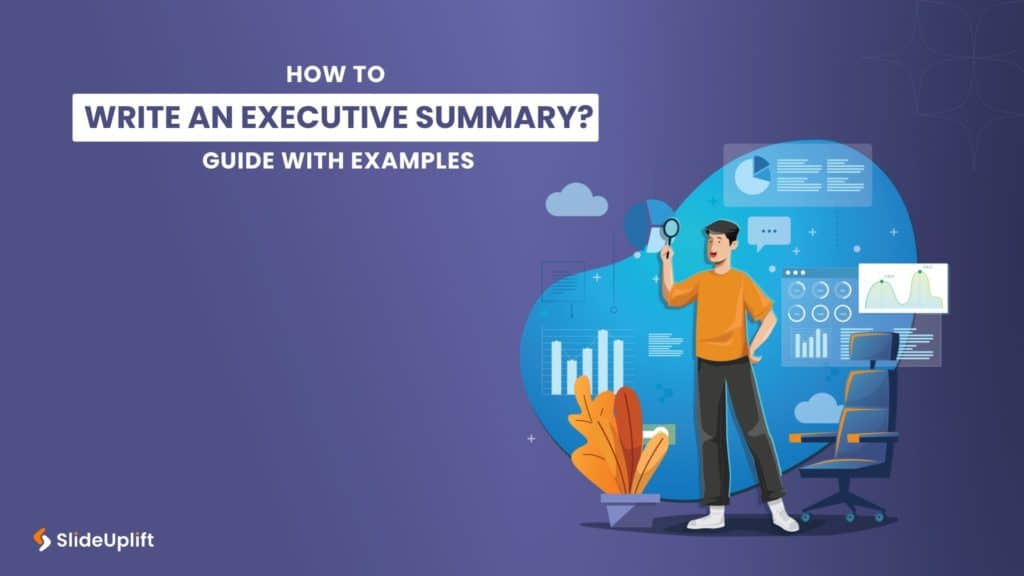
Nowadays, it is becoming challenging to grab the attention of business executives. With jam-packed schedules, quick decisions to make, and not much time to spare, the executives are always looking for value for their time. Hence the need for the Executive Summary to capture the attention of the busy audience by providing the gist of the entire presentation engagingly.
What Is An Executive Summary?
An executive summary is a vital part of any business presentation. In the broader sense, the executive summary is the brief that precedes a more extended report or presentation and outlines the essence of the entire report.
In business environments, an executive summary presentation summarizes the intent of the entire business deck in a concise form.
The purpose of an executive summary is to pique the reader’s curiosity by presenting facts from the larger piece of content. A robust executive summary creates value for the reader as a first impression and generates interest in viewing the rest of the content.
How To Write An Executive Summary
After dealing with several professional clients, we have found many things to keep in mind while writing an executive summary format. These tips will help you build a winning executive summary.
Begin with a bang
The opening statement of your executive summary needs to be effective. Use the most differentiating plus point of your company and present it as the lead sentence. A few examples:
- List the unique problem you are solving, and the impact your solution has.
- Highlight if you have a huge market size, growth opportunity, or high potential investor return.
- Drop known names in the industry if they have collaborated, invested, or endorsed you.
Keep it Simple and Short
The executive summary template should only be 5% – 10% of the length of the entire presentation. Putting too many details in the executive summary is contradicting to its purpose. Make the executive summary focused and simple, by using short paragraphs or bullets, and subheadings.
Placement of the Summary
The executive summary slide should be the last thing you should write when making the presentation . With every revision, the summary needs an update. However, it should be placed right after the table of contents PowerPoint template , and before the introduction of the presentation so that the audience knows what to expect.
The Interest of the Audience
Do your research and consider the mindset of your audience. Tailor the summary to intrigue them with your study and proposal, convincing them to invest more effort in your presentation, and read further.
Good Examples Of Executive Summary For Different Business Scenarios
SlideUpLift has an extensive collection of PowerPoint & Google slide templates to whip up a compelling executive summary instantly. The templates cater to building an executive summary for different types of business presentations. Below are a few executive summary examples:
Strategic Initiatives Executive Summary Template
In this business summary example, you can showcase the snapshot of the strategic initiatives you are proposing in your plan. In a single executive summary slide, you can convey the current facts about the market, market trends, key milestones you wish to achieve, and further how you plan to reach milestones through your initiatives.
The template is perfect to showcase your executive in one single slide. The effective use of icons and shapes makes this template a good executive summary template.
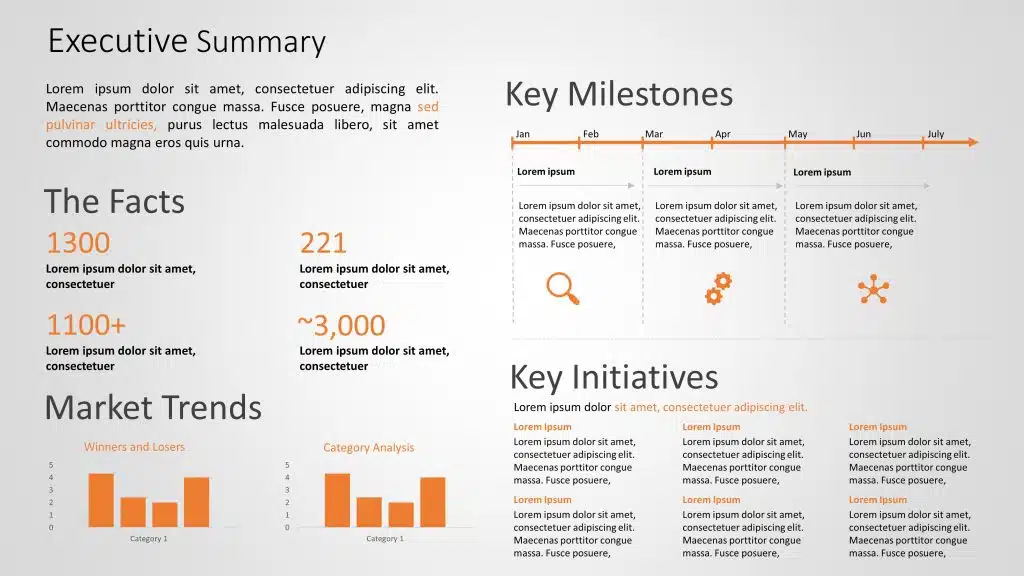
Business Proposal Executive Summary Template
This executive summary sample gives a snapshot of the size and expertise of your organization, conveying how you are qualified to take on the prospective client’s business.
An effective executive summary design format that showcases all important aspects can increase your chances to impress your client or prospect.
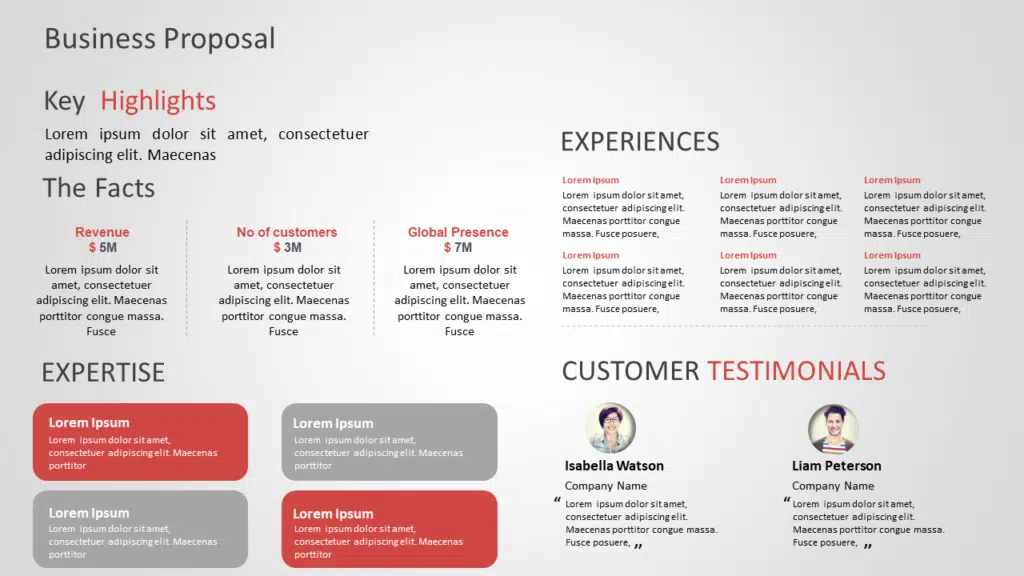
Customer Journey Executive Summary Template
This Executive Summary example showcases a customer’s journey with a brand, company, or organization using creative infographics. This framework allows the brands to summarize factors such as – a customer’s tenure, activity status, demographics, and customer spread across the world.
By using an Executive Summary Template to exhibit a customer’s journey, brands can improve their sales efficiency.
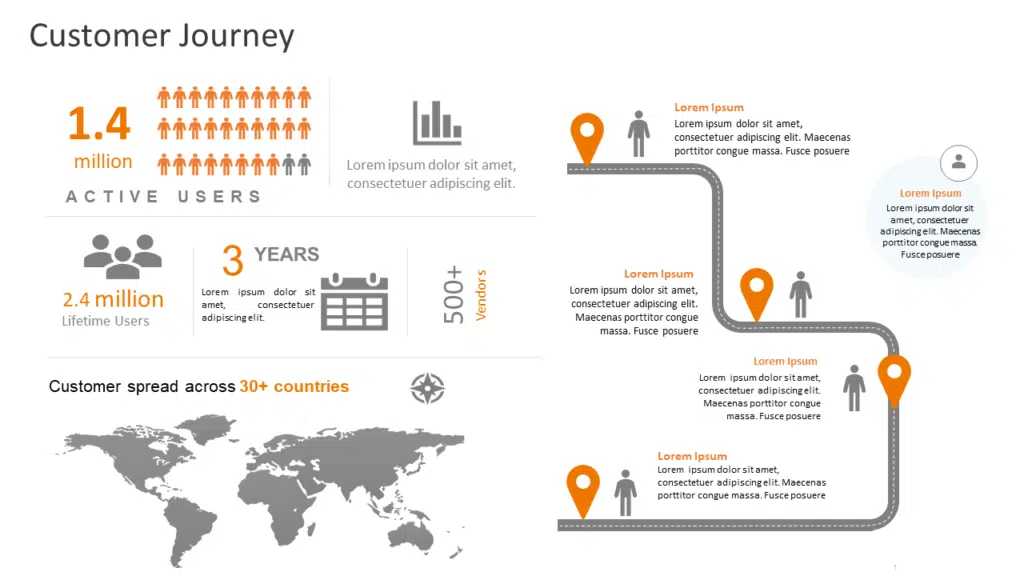
Business Review Executive Summary Template
The following sample of executive summary summarizes the major points an executive need to know for a business review. The slide covers, key milestones, market share and growth, product profile, company strategy, revenue, and profit, all in a structured way.
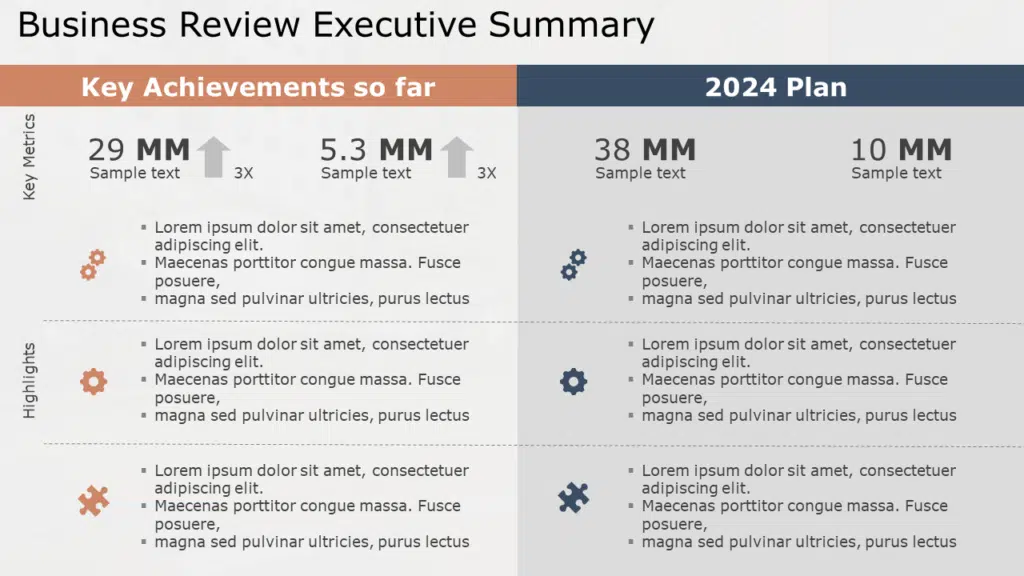
Project Executive Summary Template
This project executive summary example is used to outline a project plan in a business presentation. Using this executive summary of a project template, you can give a quick overview of a project plan with a focus on Team Members, key highlights, and the background of the project. This framework also allows you to compare actions taken and measure the results of a project plan.
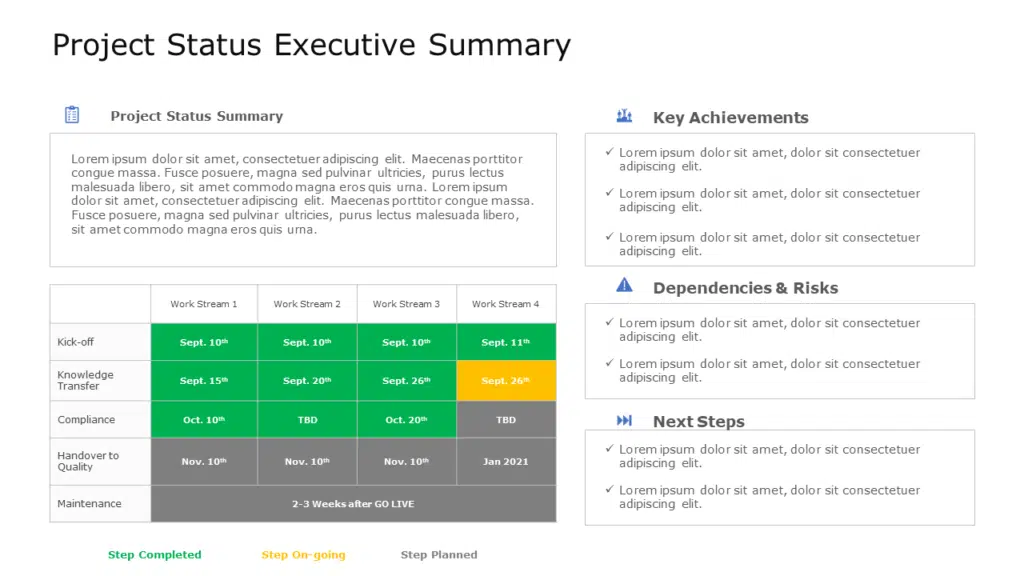
Project Launch Executive Summary Template
This project executive summary template allows you to give a quick overview of the context of your project planning.
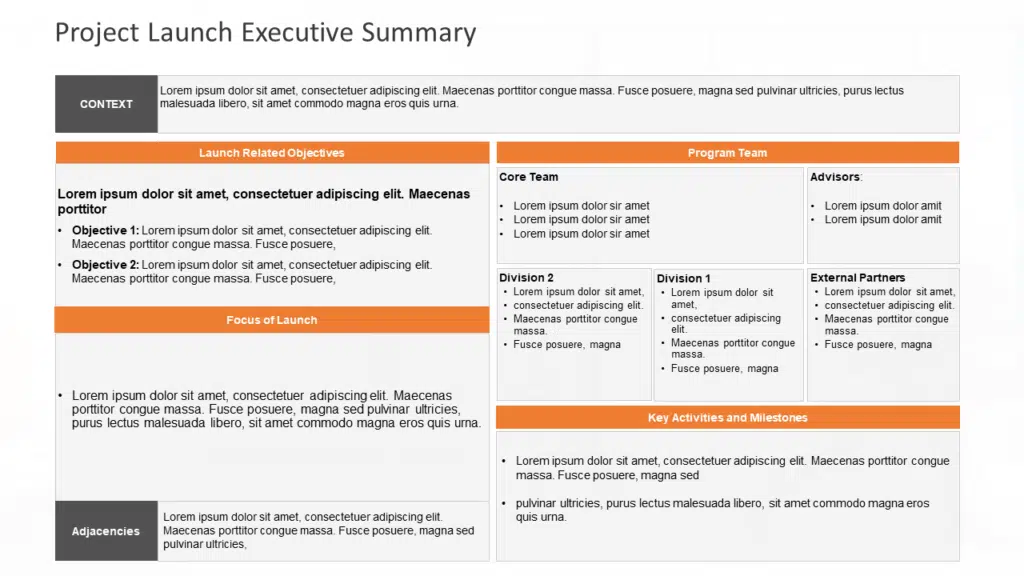
Sales Executive Summary Template
This is a marketing plan executive summary example that can be used to summarize your marketing and sales plan.
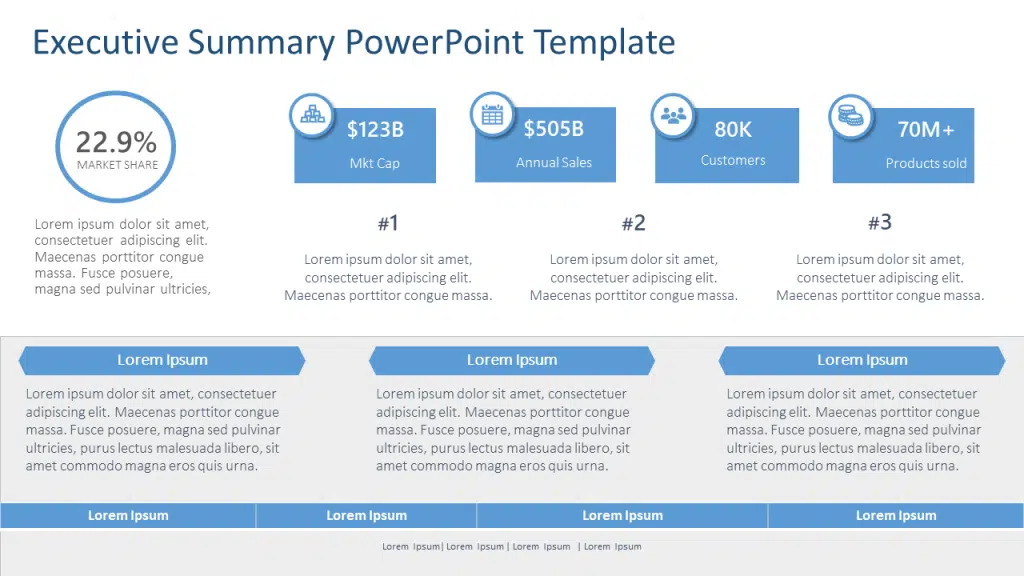
Financial Plan Executive Summary Template
This executive summary sample can help summarize financials in your presentation.
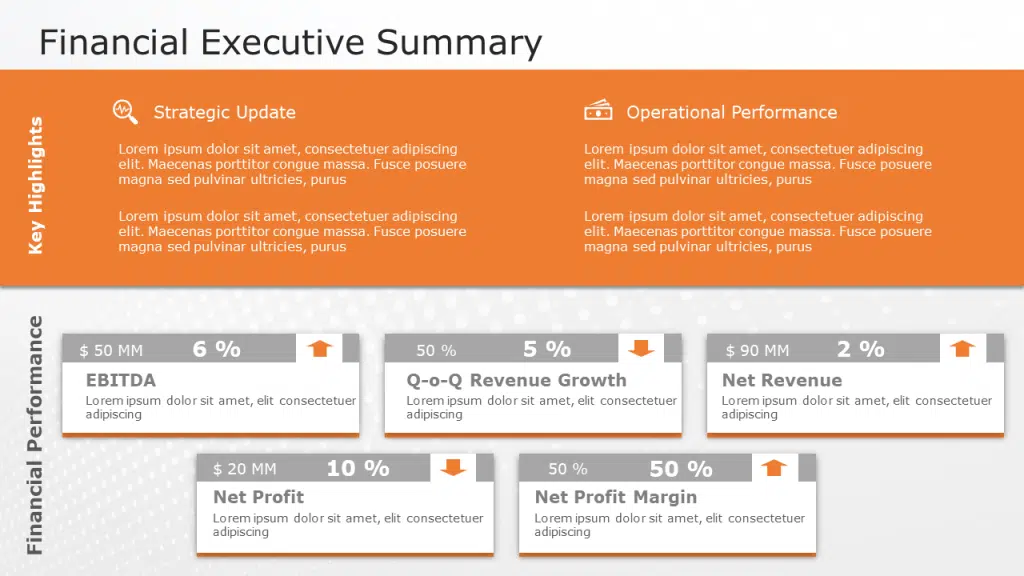
Resume Executive Summary Template
This is the best executive summary example that helps you highlight your career experiences and achievements and allows you to showcase the reasons that make you a suitable candidate.
Best Executive Summary Templates Collection
This collection of executive summary templates that cover most of the summarization of business professionals is available in PowerPoint Themes and Google Slides themes .
Building An Executive Summary Template For A Startup
Now that we know what an executive summary is and learn the tips on how to write an effective Executive Summary. An executive summary example for a startup should be a lean abbreviated version of a business plan with no extra fat. It is like a business plan executive summary example that is crisp. The goal of the startup executive summary presentation is to get a meeting with venture capitalists however the objective of a great executive summary format for a business proposal may include a company profile, existing client information, rich media like charts, graphs, images, projections, and more to keep the readers hooked.
The Punch Statement
The first statement or paragraph should make your audience stop everything else and focus on you. Lead with the most convincing statement and tell why your idea is huge and worthy of your audience’s time. If possible, throw in names that impress the room, like world-class advisors, famous companies you are already working with, or renowned investors you have.
The Problem
Emphasize how the problem you aim to solve is big and impacts a large demographic.
The Solution
What specifically are you offering to whom? Software, hardware, service, combination? Use commonly used terms to state concretely what you have, or what you do, that solves the problem you’ve identified.
The Opportunity
Briefly describe your target customer, size of the market, growth opportunities, market dynamics, and plan for the market.
Your competitive advantage
Describe the competitive position of your company over your competitors, the possible opportunities in the future, plans for growth, and overcoming possible competitor threats.
The Business Model
How specifically are you going to generate revenues, and from whom? Why is your model leverageable and scalable? Why will it be capital efficient?
Why is your team uniquely qualified to win? Don’t just add a shortened form of each founder’s resume; explain why the background of each team member fits.
Detail the exact amount you want to raise, and the key areas where you will invest the funds. Use this section to highlight the growth and add perspective for the reader by showing relevant numbers.
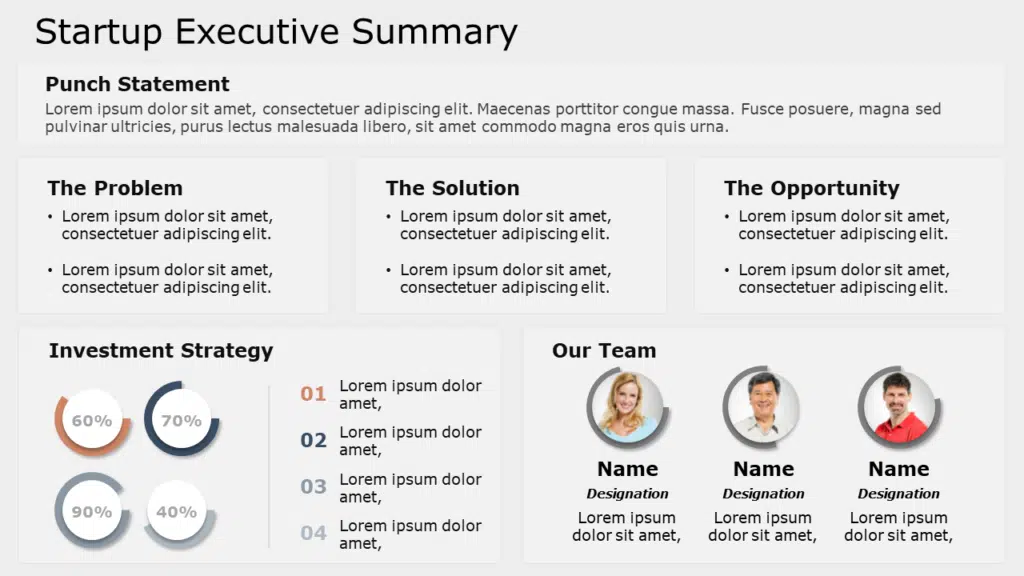
In short, having a good executive summary is crucial to capturing the attention and excitement of your audience. An effective executive summary template captures the core message of your presentation and successfully raises your audience’s intrigue to read further into your presentation.
Build an excellent executive summary to convey to the business executives how you value their time and are worthy of the same, increasing the likelihood of the success of your business presentation . Get ideas from 100+ creative ways of building executive summaries from SlideUpLift Library.
Table Of Content
Related presentations.

Executive Summary PowerPoint Template

Project Executive Summary PowerPoint Template

Related blogs

10 Bad PowerPoint Slides Examples to Avoid

10 Best Animated PowerPoint Templates

10 Best Business PowerPoint Templates for Presentations

10 Best Free PowerPoint Templates
Tags and categories, privacy overview.
Necessary cookies are absolutely essential for the website to function properly. This category only includes cookies that ensures basic functionalities and security features of the website. These cookies do not store any personal information
Any cookies that may not be particularly necessary for the website to function and is used specifically to collect user personal data via ads, other embedded contents are termed as non-necessary cookies. It is mandatory to procure user consent prior to running these cookies on your website.

- Get access now
How to Design and Present Executive Summary Slides
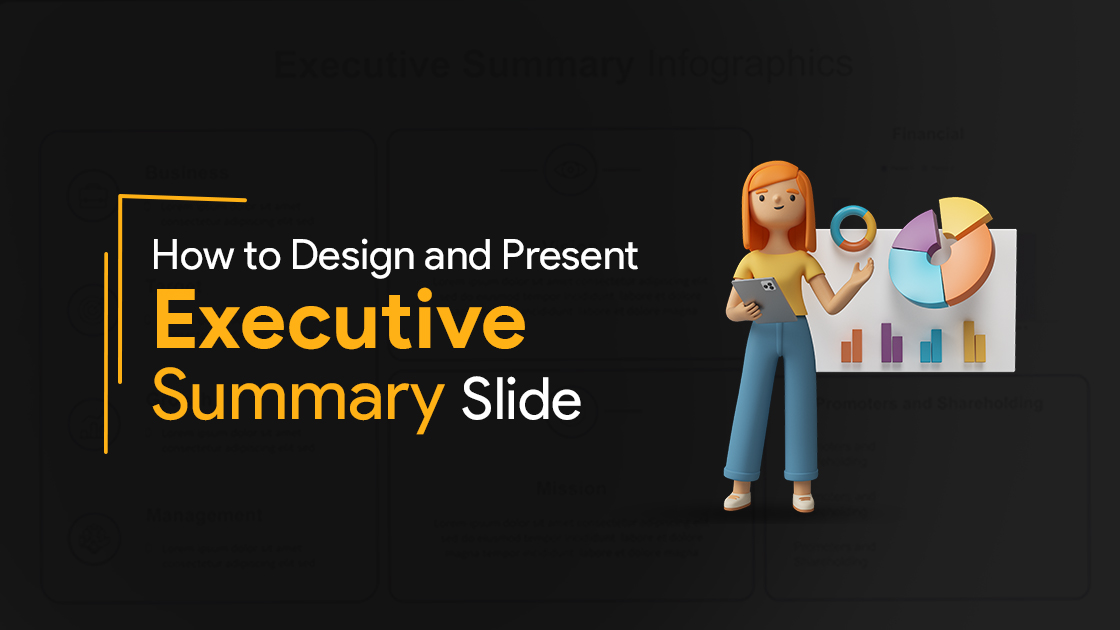
Introduction
Welcome to a simple guide on making and presenting executive summary slides . It allows you to make a significant impact instantly! Let’s explore how to make fantastic executive summary slides.
Understanding the Executive Summary:
An executive summary is a brief prelude to major documents such as business plans or reports. It is kind of a trailer before reading the whole thing. It restates the purpose of the document, highlights key points, and discusses results or recommendations.
Creating an Executive Summary Slide:
The executive summary slide does not have to be made just one way. It depends on the document and its intended significance to determine its importance. However, it must present key discussions, the primary concern, and findings or recommendations.
Examples of Effective Executive Summary Slides:
There are many ways to make a good executive summary slide. Here are some top executive summary templates examples to inspire you:
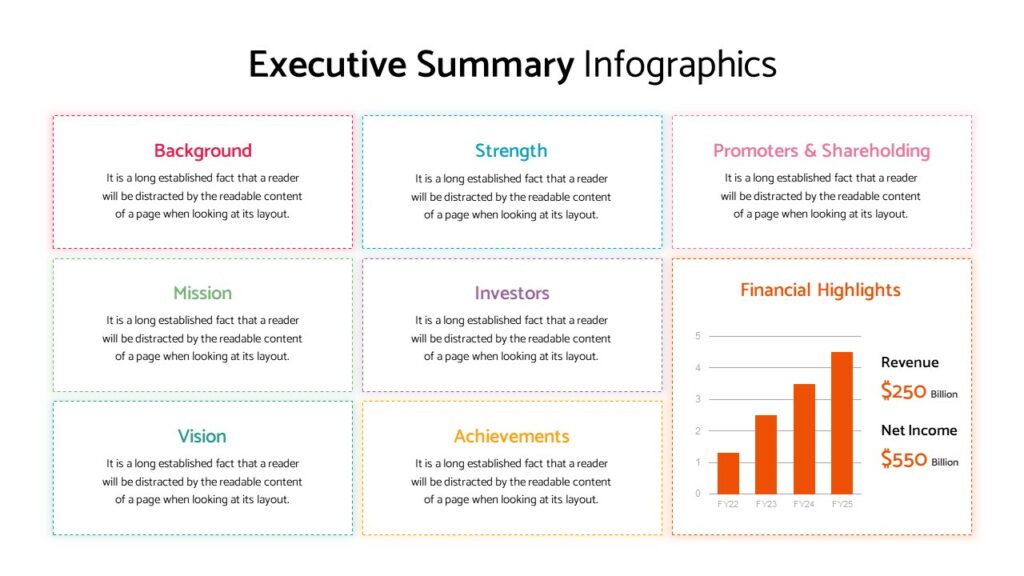
Making a Good Executive Summary Slide:
Google Slides can be used to make a great summary slide. Utilize your space sparingly, incorporate straightforward images, and use concise headings and subtitles. Templates can be useful too.
Why Use Executive Summary Slides?
These slides are like maps for your audience. They make everything understandable and ensure that everyone keeps up.
Steps to Create an Executive Summary Slide:
Making a good executive summary slide is like creating a short and powerful article with the most important points. It’s easy when you follow a few simple steps.
Know Your Audience:
Determine the viewers of your slide, like coworkers, customers, or stakeholders. Understand their interests, knowledge level, and values.
Understand the Goal:
Identify a clear message that you want your readers to take away from the story. Ensure your goal aligns with the objective of your presentation.
Pick Important Info:
Choose the most important details that reinforce your key message. Focus on relevant key achievements, milestones, or meaningful data.
Clarify your thoughts:
Do not use confusing or technical words.
Make a Catchy Title:
Develop a catchy heading that encapsulates the main idea of your message. Make sure the title is catchy and creates interest.
Add Pictures or Graphs:
Use images, charts, or graphs to show data for graphic displays of information. Choose clear and simple graphic design that aid in the understanding process.

Keep It Short:
Do not overload the slide with text to make sure you do not overwhelm your audience. Use bullet points or short sentences to provide information concisely.
Show Important Numbers:
If relevant, highlight important numbers or statistics that demonstrate success or improvements. Make sure these figures are meaningful to your target audience.
Give a Little Context:
Make a short introduction that will help your audience understand why the information given is important. Integrate the provided details within a larger framework of your project or initiative.
Use the Same Style:
Keep visual uniformity with other slides in your presentation. Make sure the slide complies with your colors, fonts, and overall design.
Check and Fix:
Critically review the content to ensure meaning, cohesion, and accuracy. Make appropriate changes to the slide to improve its overall appearance.
Ask for Feedback:
Share your slide with other co-workers or teammates. Evaluate the feedback to indicate what changes can be made.
Put It in Your Presentation:
Include the executive summary slide into your presentation smoothly. Make sure that there is a smooth passage from the executive summary to other slides.
Making a Summary Slide Interesting:
Start with a clear structure :.
Begin by outlining your slide’s key sections: Start, Issue Statement, Answer, Market Checking, and Financial Summary with End.
Keep Text Minimal and Impactful :
Avoid lengthy paragraphs. Share your message simply using bullet points, brief sentences, or keywords. Use big, strong headlines or subheadings to make important information stand out.
Practice Clarity and Brevity in Delivery:
When you speak in front, be confident and focus on providing key points quickly. Don’t just look at the slides – use them as helpers to add more facts and talk better with your listeners.
Conclusion:
Creating and presenting best executive summary slides needs a thought-out method. Keep your slides simple, easy to understand, and visually appealing. This will assist you in telling important things to others clearly, so they won’t forget this quickly.
Welcome Back!
Please sign in to continue..

Please sign up to continue.
How To Write A High-Impact Executive Summary
By Derek Jansen | January 2018

In this post, I’ll deconstruct the often-misunderstood executive summary and show you how to develop a high-impact executive summary for your assignment, research report or even your dissertation or thesis.
So, what is an executive summary?
An executive summary (sometimes called an abstract ) is quite simply a summary of summaries. In other words, an executive summary provides a concise summary of each of your assignment or report chapters/sections . More specifically, it should communicate the key points/insights/findings/suggestions from the following chapters:
- Introduction
- Recommendations
- Implementation (if applicable)
- Reflection (if applicable)
I’ll discuss which key points from each section need to be addressed a bit later. On a separate note – if you’re writing an executive summary for a dissertation or thesis, all of the concepts described in this post will still apply to you, however, you’ll include an additional paragraph about your methodology, and you’ll likely spend more word count discussing your analysis findings.
The 4 Important Attributes Of An Exec Summary
Before I discuss what goes into the executive summary, let’s quickly look at 4 attributes that make for a strong executive summary:
#1 – It should be able to stand alone.
The executive summary should be able to stand independently as an informative document . In other words, the reader should be able to grasp your broad argument without having to read the full document. Further reading should be purely for attaining more detail. Simply put, the executive summary should be a “Mini-Me” of the assignment.
This independence means that anything you write in the executive summary will need to be re-stated in the body of your assignment. A common mistake that students make is to introduce key points in the executive summary and then not discuss them again in the document – accordingly, the marker must view the main document as missing these key points. Simply put – make sure you discuss key points in both the executive summary and the main body . It will feel repetitive at times – this is normal.

#2 – It should be written for the intelligent layman.
When crafting your executive summary, its useful to keep the intelligent layman front of mind. What I mean by this is that you should write your summary assuming that your reader (i.e. the marker) will be intelligent but won’t be familiar with your topic and/or industry. This means that you should explain any technical concepts, avoid jargon and explain acronyms before using them.
#3 – It should be concise.
Typically, your executive summary should be a one-pager (one and a half pages at worst). To summarise a 3000 – 5000-word document into one page is no easy task, so you’ll need to:
- Present only the most important information (key insights, recommendations, etc).
- Write concisely – i.e. with brevity and completeness.
To the first point, I’ll explain what the “most important” information is for each chapter shortly. To the second point (writing concisely), there are various ways to do this, including:
- Using simple, straightforward language.
- Using the active voice.
- Removing bloaty adverbs and adjectives.
- Reducing prepositional phrases.
- Avoiding noun strings.
Does this sound like gibberish to you? Don’t worry! The Writing Center at the University of Wisconson-Madison provides a practical guide to writing more concisely, which you can download here.
On a related note, you typically would not include headings, citations or bulleted/numbered lists in your executive summary. These visual components tend to use a lot of space, which comes at a premium, as you know.
#4 – It should be written last.
Given that your executive summary is a summary of summaries, it needs to be written last , only once you’ve identified all your key insights, recommendations and so on. This probably sounds obvious, but many students start writing the summary first (potentially because of its position in the document) and then end up re-writing it multiple times, or they don’t rewrite it and consequently end up with an executive summary which is misaligned with the main document.
Simply put, you should leave this section until everything else is completed. Once your core body content is completed, you should read through the entire document again and create a bullet-point list of all the key points . From this list, you should then craft your executive summary . The approach will also help you identify gaps, contradictions and misalignments in your main document.

So, what goes into an executive summary?
Right, let’s get into the meat of it and consider what exactly should go into your executive summary. As I’ve mentioned, you need to present only the absolutely key point points from each of your chapters, but what does this mean exactly?
Each chapter will typically take the form of 1 paragraph (with no headings) in your executive summary. So, 5 chapters means 5 paragraphs. Naturally, some will be longer than others (let this be informed by the mark allocation), but assuming one page contains 500 words, you’re aiming for roughly 100 words per paragraph (assuming a 5-paragraph structure). See why conciseness is key!
Now, let’s look at what the key points are for each chapter in the case of a typical MBA assignment or report. In the case of a dissertation or thesis, the paragraph structure would still mimic the chapter structure – you’d just have more chapters, and therefore, more paragraphs.
Paragraph 1: Introduction
This paragraph should cover the following points:
- A very brief explanation of the business (what does it do, for whom and where?).
- Clear identification and explanation of the problem or opportunity that will be the focus of the assignment/report.
- A clear statement of the purpose of the assignment (i.e. what research questions will you seek to answer?).
- Brief mention of what data sources were utilised (i.e. secondary research) and any fieldwork undertaken (i.e. primary research ).
In other words, your first paragraph should introduce the business, the problem/opportunity to be addressed, why it’s important, and how you approached your analysis. This paragraph should make it clear to the reader what the assignment is all about at a broad level. Here’s a practical example:
This assignment focuses on ABC Ltd, a XXX business based in XXX, which provides XXX to XXX customers. To date, the firm has relied almost exclusively on XXX marketing channel. Consequently, ABC Ltd has little understanding of consumer segments, wants, and needs. This marketing channel is now under regulatory threat due to XXX. The core challenge, therefore, is that whilst ABC Ltd seeks to grow its market share, it has little understanding of its market characteristics or competitive set, and its sole marketing channel under regulatory threat. Accordingly, the objective of this assignment is XXX. The assignment draws on survey, interview, and industry data.
Paragraph 2: Analysis and findings
In this paragraph, you should discuss the following:
- What exactly did you analyse? For example, you might have analysed the macro context (i.e. PESTLE analysis), followed by the meso (i.e. competitor or industry analysis) and then the micro (i.e. internal organisational analysis).
- What were your key findings in relation to the purpose of the assignment? For example, you may have identified 4 potential causes of a problem and would then state them.
In other words, your second paragraph should concisely explain what you analysed and what your main findings were . An example of this:
Segmentation analysis, consisting of macro, industry and firm-level analyses, revealed a strong segmentation variable in the form of XXX, with distinct needs in each segment. Macro analysis revealed XXX, while industry and firm-level analyses suggested XXX. Subsequently, three potential target segments were established, namely XXX, XXX and XXX. These were then evaluated using the Directional Policy Matrix, and the results indicated XXX.
From a presentation perspective, you might structure this section as:
- Analysis 1, findings from analysis 1.
- Analysis 2, findings from analysis 2.
- Analysis 3, findings from analysis 3.
Importantly, you should only discuss the findings that are directly linked to the research questions (i.e. the purpose of the assignment) – don’t digress into interesting but less relevant findings. Given that the analysis chapter typically counts for a large proportion of marks, you could viably write 2-3 paragraphs for this. Be guided by the mark allocation.
Lastly, you should ensure that the findings you present here align well with the recommendations you’ll make in the next paragraph. Think about what your recommendations are, and, if necessary, reverse engineer this paragraph to create a strong link and logical flow from analysis to recommendations.

Paragraph 3: Recommendations
With the key findings from your analysis presented in the preceding paragraph, you should now discuss the following:
- What are your key recommendations?
- How do these solve the problems you found in your analysis?
- Were there any further conclusions?
Simply put, this paragraph (or two) should present the main recommendations and justify their use (i.e. explain how they resolve the key issue). As mentioned before, it’s critically important that your recommendations tightly align with (and resolve) the key issues that you identified in the analysis. An example:
Based on the Directional Policy Matrix analysis, it is recommended that the firm target XXX segment, because of XXX. On this basis, a positioning of XXX is proposed, as this aligns with the segment’s key needs. Furthermore, a provisional high-level marketing mix is proposed. The key aspects of the marketing mix include XXX, XXX and XXX, as these align with the firm’s positioning of XXX. By adopting these recommendations, the key issue of XXX will be resolved.
Also, note that (typically) the tone changes from past to present tense when you get to the recommendations section.
Paragraph 4: Implementation
If your assignment brief requires an implementation/project plan-type section, this paragraph will typically include the following points:
- Time requirements (how long will it take?)
- People requirements (what skills are needed and where do you find them?)
- Money requirements (what budget is required?)
- How will the project or change be managed? (i.e. project management plan)
- What risks exist and how will these be managed?
Depending on what level of detail is required by your assignment brief, you may need to present more, less or other details in this section. As always, be guided by the assignment brief.
A practical example:
A high-level implementation plan is proposed, including a stakeholder analysis, project plan and business case. Resource requirements are presented, detailing XXX, XXX and XXX requirements. A risk analysis is presented, revealing key risks including XXX, XXX and XXX. Risk management solutions are proposed, including XXX and XXX.

Paragraph 5: Reflection
As with the implementation chapter, the need for a reflection chapter/section will vary between assignments and universities. If your assignment has this requirement, it’s typically good to cover the following points:
- What were your key learnings? What were your ah-ha moments?
- What has changed in the real world as a consequence of these learnings? I.e. how has your actual behaviour and approach to “X” changed, if any?
- What are the benefits and/or disadvantages of this change, if any?
This section is very personal, and so each person’s reflections will be different. Don’t take the above points as gospel.
Time to test it out.
Once you’ve written up your executive summary and feel confident that it’s in good shape, it’s time to test it out on an unsuspecting intelligent layman. This is a critically important step, since you, as the writer, are simply too close to the work to judge whether it all makes sense to a first-time reader. In fact, you are the least suitable person on the planet!
So, find someone who is not familiar with your assignment topic (and ideally, not familiar with your industry), and ask them to have a read through your executive summary. Friends and family will usually tell you its great, regardless of the quality, so you need to test them on their understanding. Do this by asking them to give the details back to you in their own words. Poke and prod – can they tell you what the key issues and recommendations were (in their own words!). You’ll quickly spot the gaps this way, and be able to flesh out any weak areas.
Wrapping up.
In this post, I’ve discussed how to write the all too often undercooked executive summary. I’ve discussed some important attributes of a strong executive summary, as well as the contents that typically go into it. To recap on the key points:
The key attributes of a high-impact executive summary:
- It should be able to stand alone.
- It should be written for the intelligent layman.
- It should be concise.
- It should be written last.
The key contents of a high-impact executive summary:
Each paragraph should cover a chapter from the document. For example, In the case of a typical assignment, it would be something like:
- Summary of the introduction chapter.
- Summary of the analysis chapter.
- Summary of the recommendations and/or conclusions chapter.
- Depending – summary of the implementation and reflection.
Lastly, don’t forget to test out your executive summary on an unsuspecting layman or two. This is probably the most important step of them all!
If you have any questions or suggestions, we’d love to hear from you. Please get in touch here or leave a comment below.
You Might Also Like:

Thanks so much for your methodical process and explanation of Executive Summary. It is exactly what I was researching for.
Regards Saane
It’s a pleasure!
This was really helpful with how to structure my assignment.
Thank you so much for the step by step process. It’s so helpful for beginners like me.
Great! This post is very informative and gives clear guidance on to write an executive summary. Thanks very much for sharing this information, it’s very helpful.
Thanks for the feedback, Anna. Best of luck with your writing 🙂
Thank you for the great article, really helped explain what was needed.
Great insight and tips . Thanks
Thank you so much for sharing this. It was exactly what I was looking for.
Thank you for your help
Submit a Comment Cancel reply
Your email address will not be published. Required fields are marked *
Save my name, email, and website in this browser for the next time I comment.
- Print Friendly
- Google Slides Presentation Design
- Pitch Deck Design
- Powerpoint Redesign
- Other Design Services

- Business Slides
- Guide & How to's
How to structure, design, write, and finally present executive summary presentation?
What is a powerpoint executive summary.
An executive summary is a much shorter version of a longer document, while an executive summary in PowerPoint is a visual summary with facts from an extensive piece of content. If you have a 30-40 page presentation, what is the one page that summarizes your key message? Sounds small, but this amount keeps you within boundaries and up to a point.
You might have a bunch of data and really interesting information, but the executives you present to are limited in time, so they will appreciate your concise and professional presentation design to grasp data easily. Remember that every time you cannot summarize your presentation’s takeaway in a couple of seconds, you look unprofessional and unable to share with your audience specific things.
What Is the Value of Presentation for Businesses/Students?
1. it clarifies your thinking.
Some presenters pull together different slides with plenty of charts, tables, and quotes but do not compile a cohesive story within executive summary ppt slides. Thus, your exam or report has no clear and concise message. If you only have 30 seconds with this audience, what do you want to convey or deliver?
2. It gives your audience what they’re looking for
The purpose of the executive summary ppt is to move your audience from point A to point B with attractive visuals that grasp and retain their attention.
3. It provides flexibility
By presenting your whole presentation on the executive summary, you can easily skip certain sections and jump directly to slides that are of value for the specific moment, question, or audience generally.
What Are the Features of Executive Summary Presentation?
The executive summary presentation is directed at executives like the top-level managers and decision-making parties, so the included facts must be relevant.
Executives use the summary to decide whether or not to move forward on the proposal, so the presentation must be convincing.
The executive summary for the PowerPoint presentation contains the same slides as sections of the full proposal, so it reads like the longer proposal, but each section must be condensed to main points and key evidence.
The 10% rule applies here, so a summary must not exceed 10% of the actual proposal length. If your proposal has 20 sections, the word document should be 2 pages. And the presentation should include no more than 20 slides (better 10).
What Should Be Included in Executive Summary Slides and What Should Not?
1. the most important slide.
The executive summary can be one slide in the presentation. When preparing, e.g., a 10 slides presentation for executives, make sure to include a 1-page opening slide. Sometimes, it becomes not possible to present the whole material. Thus, it’s better to present key takeaways.
2. Purpose of report
This slide or slides should state the investigated problem and purpose of the report in a concise format using the present tense. We advise using bullet points, heading/subheadings, SmartArt figures, and other graphic elements to design the text attractively .
This slide should report data only in summary form. There is no need to include dozens of tables even though they are so well-made. Provide key findings from each report table or appendices.
4. Findings and conclusion
This section is also summarized without reference to supporting tables or appendices.
5. Recommendations
Recommendation or advice for a specific proposal is better presented in bullet-list format.
How to Design and Present Executive Summary Slides?
Put minimum text.
We advise a maximum of five first-level bullets and sub-bullets. If you put too much information on one slide in a great room, people won’t remember or even see anything. You lose their attention whenever they do not see or understand the text.
Focus on insights
Every slide, no… EVERY SLIDE must include the answer, results, insights, and other ‘so what’s’ that add impeccable and fundamental value. For instance, you can provide one context sentence at the top of each slide.
Choose neutral colors and background
The executive summary slide design has to be attractive and visible from every room angle. Also, don’t waste space on your slides with unnecessary background messages that make it impossible to read the text. Choose neutral and calm colors that do not drag audiences’ attention from words. If you hesitate on your design choices, feel free to contact professional pitch deck design services and get top-notch assistance.
A good summary presentation summarizes or synthesizes what you want your audience to leave with on one slide. Your presentation’s success isn’t measured by the number of slides you’ve designed and presented. The only purpose of the executive summary ppt is to give the audience the key messages you want them to leave with. Having all on one or few slides makes conveying all information attractive and ensures that your audience hears your messages.
#ezw_tco-2 .ez-toc-widget-container ul.ez-toc-list li.active::before { background-color: #ededed; } Table of contents
- Presenting techniques
- 50 tips on how to improve PowerPoint presentations in 2022-2023 [Updated]
Keynote VS PowerPoint
- Types of presentations
- Present financial information visually in PowerPoint to drive results

- Design Tips

How to start and end a presentation: top tips and tricks from professionals (+ special focus)

The importance of visual storytelling in presentations (+ effective tips to consider)
How to Write an Executive Summary and Translate It Into a Presentation

An executive summary is a crucial document that summarizes the essence of a business proposal, plan, or project. It is the first thing an investor, partner, or executive reads to determine if a project is worth investing in. Because they’re looking for high level updates, it should be concise, clear, and convincing.
It’s one thing to write a killer executive summary and another to translate it into a presentation that keeps your audience engaged and interested. In a presentation, an executive summary is usually a “too long, didn’t read” slide at the end of the deck (although it can be an entire presentation, too). If your summary is effective, executives should be able to pick up the key takeaways from the presentation in just a few points.
In this blog post, we'll explore the key elements of a winning executive summary and how you can include it in your deck.
How to write an effective executive summary
If an executive summary is foreign to you, let’s start with how to write one. Keep these 3 things in mind when writing your next executive summary.
Understand your audience
The first step to crafting an effective executive summary is to understand your audience. Who are they? What are their interests, goals, and challenges? Pinpointing what they care about most, and answering those questions, will help you tailor your summary to their needs. If you're presenting to investors, for example, you'll want to highlight the financial benefits of your proposal. Similarly, if you're presenting to executives, you'll want to focus on the strategic implications.
Focus on the biggest wins
Your executive summary should highlight the biggest wins or benefits of your proposal or project. Think of it as a high level overview— or sparknotes— of your story. What's in it for your audience? What problem does it solve, or what opportunity does it create? Highlight these wins upfront and organize them in a logical and compelling way. You might opt for bullet points, graphics, or charts to emphasize key points and make them easier to digest.
Keep it simple and clear
A good executive summary should be concise and easy to understand. After all, the whole point is to summarize your content. To keep things simple, avoid jargon, technical terms, or complex charts that may confuse your audience. Remember, your goal is to communicate effectively and get to the point quickly, not to impress your audience with your vocabulary.
Adding an executive summary to your presentation
Now that you know the basics of how to write an executive summary, let’s add it to your presentation.
As we mentioned, you should limit your executive summary to one slide and only include the most important and meaningful information. Usually, this slide will live at the end of the deck so your audience can refer back to it for a quick recap of the presentation when they need to make a decision.
Tell a compelling story
Imagine your audience skimmed through the entire deck and is relying on the last slide to tell them exactly what they need to know— will it make sense? Even though an executive summary is short and sweet, it should still maintain a nice flow.
People love stories, so use that to your advantage. Compile your key takeaways in a compelling story that captures the essence of your proposal or project. Use anecdotes, examples, or data that demonstrate its value and impact. You might also include one or two visuals, or videos, that bring your story to life and grab the attention of your audience.
Practice and prepare
As with any presentation, practice makes perfect. But chances are, if you’re including an executive summary, you’re presenting to a powerful audience and the stakes are high. Take the time to rehearse your presentation in front of a mirror or a friend to eliminate any kinks. Pay attention to your body language, tone of voice, and timing.
You’ll also want to ensure your presentation is well-organized, and your visuals or videos are working correctly. Lastly, be prepared to answer questions or objections and have backup data or evidence to support your claims in your executive summary.

Jordan Turner
Jordan is a Bay Area writer, social media manager, and content strategist.
Recommended Articles
How to ensure your team finds and uses the right content always, bring remote presentations to life with animations, the 7 essential presentation tips for non-designers, the ultimate guide to sales and creating winning sales presentations.
Creating an Executive Summary PowerPoint Presentation in 2024: Expert Tips and Techniques
What is an executive summary in powerpoint presentations.
A n executive summary slide gives a quick peek into a more extended presentation, usually found at the start of a slide deck. Its job is to summarize the main points so readers don’t have to go through the whole thing. These slides often have more text than regular slides because they’re meant to be read, not presented live. It’s important to keep live presentations engaging by avoiding too much text on slides.
Think of an executive summary as a short version of a big document, giving important info in an easy-to-understand way. Even though it’s short, an excellent executive summary must focus on the main message. Executives and decision-makers, who are often busy, like presentations that get to the point quickly and professionally. If you can’t do that, you might seem unprepared or unable to communicate well.
An executive summary PPT slide makes presenting vital info from a bigger report or business plan easier. It usually includes a title slide, an agenda or outline slide, and a few summary slides. This helps quickly share critical details like the problem you’re addressing, solutions, expected outcomes, and budget plans.
An executive summary template condenses a more extended presentation into crucial points. It aims to catch readers’ interest, clarify the presentation’s goals, and prepare the audience for the discussion. A good executive summary grabs attention and sets the stage for a complete understanding of the topic.
What are the Benefits of an Executive Summary in Slide Presentations?
In slide presentations, a business plan executive summary is a crucial connection between the presenter and the audience, giving a quick look into what’s coming up. Stakeholders often need to understand proposals, project details, or research quickly, especially in business. Creating a well-organized executive summary ensures that essential points are easy to see, setting the stage for deeper exploration if needed.
In the midst of a PowerPoint slide deck, it’s easy for readers to get lost, trying to remember earlier slides and the main story. Executive summary slides help guide readers through the presentation. They have a few main jobs:
1. Providing Context: Executive summaries provide background information, explaining why the slide deck’s topic is important, which helps the audience understand better.
2. Showing the Main Argument: Executive summaries help readers understand the main idea of the presentation before getting into the details by summarizing the central argument right away.
3. Acting as a Guide: These summaries work like maps for readers, helping them stay on track with the presentation’s story.
Executive summaries, especially in PowerPoint, are handy in the business world. They’re the first thing the audience sees, grabbing attention and making people curious by summarizing long and potentially dull content. The benefits of using an executive summary PowerPoint template include:
1. Saving Time: Executive summaries save presenters and audience members time by condensing important points from long reports or presentations.
2. Clear Organization Overview: These summaries give a quick and optimistic overview of the organization, showing its successes and goals, which makes the audience want to learn more about it.
Executive summaries in slide presentations are crucial for smoother communication and ensuring everyone can easily understand important information. By guiding the audience to deeper insights, they make engagement and understanding easier, moving the story along with clarity and purpose.
How To Write an Effective Executive Summary Slide

To ensure clarity and engagement, crafting a compelling executive summary for slide templates involves several key steps.
1. Start with a Clear Problem Statement: Think of your first paragraph as the opening slide of a presentation. You need to make a strong statement that immediately communicates the agenda. Address the urgency of the issue, highlight its importance, or provide background information to set the scene. Clearly outline the chief goals of the report or document.
2. Present the Main Discussion Points: Expand on the points or scope of the report to meet audience expectations. Break down large blocks of text into bullet points for easier digestion. Use figures to highlight key findings and quantify significant results. Discuss the research methods and data sources, and mention any report limitations. Summarize the conclusions in a paragraph or as a featured quote to highlight critical information.
3. List Recommendations or Next Steps: Allocate a section at the bottom of the summary to emphasize outcomes, conclusions, and follow-up actions expected from the reader. Summarize the research findings and identify any recommended solutions or actions. Seek feedback from team members who have not seen the full report to ensure the summary effectively conveys the document’s content and piques interest without additional context.
By following these steps, you can create an executive summary that effectively communicates the main points of your presentation and encourages audience engagement.
How To Make an Executive Summary Engaging

A creative executive summary presentation involves several vital strategies to capture your audience’s attention and convey the main points effectively.
1. Create an Engaging Slide Title: The title of your slide is the first thing your audience will see. Make it count by clearly stating the main takeaway and setting the tone for the rest of the slide.
2. Use Basic Story Structure: Your summary should provide a complete presentation overview, including a clear beginning, middle, and end. Many summaries focus solely on insights or data without providing a proper introduction or conclusion.
3. Ensure Scannability: Executive summary slides often contain lots of information, making them dense and challenging to navigate. Make it easier for your audience by organizing information into easily discernible sections. Group related text and graphs together, and include text headers for each section so even those scanning will understand the main points.
4. Maintain Consistent Tone: Ensure that the tone and language used in your slide match those of the primary document. Consistency in tone prevents confusion and keeps the audience engaged.
5. Focus on The Story: While stakeholders may have time to read the full report later, your goal during the presentation is to draw their attention to the most critical issues and highlight the value within the report, enticing them to delve deeper.
6. Use Bullet Points: Present information in bullet points to keep it concise and easily digestible. Avoid overloading your audience with long lists or full sentences, as this can overwhelm them and diminish the impact of your presentation.
7. Limit Data Overload: While data is essential, too much of it can overwhelm your audience. Choose three main data points to highlight on your executive summary slide and provide context for why these points are significant.
8. Utilize Professional Presentation Templates: Consider using presentation templates designed specifically for executive summaries. These help you create visually appealing slides that enhance your message and engage your audience. Prioritize white space and use icons and simple visualizations to minimize clutter and make your slides visually appealing.
By incorporating these strategies, you can create an executive summary slide that conveys important information and keeps your audience curious and engaged.
Crafting a compelling executive summary in slide presentations is essential for conveying critical information concisely and engagingly.
By following strategies such as creating an engaging slide title, using basic story structure, ensuring scannability, maintaining a consistent tone, focusing on the story, using bullet points, limiting data overload, and utilizing professional presentation templates, presenters can captivate their audience’s attention and communicate their main points effectively.
An engaging executive summary sets the stage for a deeper exploration of the topic and facilitates smoother communication, ultimately leading to better stakeholder understanding and engagement.
Frequently Asked Questions (FAQs)
1. What is the purpose of an executive summary slide in a presentation?
An executive summary PPT slide gives a quick overview of a more extended presentation, usually at the beginning of a slide deck. It summarizes the main points so readers don’t have to review the entire presentation. These slides are more text-heavy because they’re meant to be read, not presented live.
2. Why is it essential to have an executive summary in slide presentations?
Executive summaries are a crucial connection between presenters and audiences, offering a glance into the content ahead. They help stakeholders quickly understand proposals, project details, or research findings. By guiding readers through the presentation and providing context, they ensure that important points are easily grasped, setting the stage for deeper exploration if needed.
3. What are the key sections typically included in an executive summary?
An executive summary usually includes sections such as introduction, problem statement, outcomes/recommendations, and importance. These sections help readers understand the document quickly. It’s common to organize them into a clear outline using bullet points to make them easier to turn into slides for a PowerPoint presentation.
4. How can I make an executive summary slide engaging?
Crafting a creative executive summary slide involves:
- Creating an engaging slide title.
- Using basic story structure.
- Ensuring scannability.
- Maintaining a consistent tone.
- Focusing on the story.
- Using bullet points.
- Limiting data overload.
- Utilizing professional presentation templates.
Presenters can capture their audience’s attention by incorporating these strategies and effectively communicate their main points.
Ready to Transform Your Presentations?
Are you looking to elevate your presentations to new heights? Look no further than Prezentium! With our AI-powered services, including overnight presentations, Prezentation Specialists, and Zenith Learning workshops, we’re here to make your presentations shine.
Whether you need a stellar deck delivered by tomorrow morning or expert guidance on transforming ideas into captivating slides, Prezentium has you covered. Don’t settle for mediocre presentations—join the ranks of satisfied clients who trust Prezentium to deliver excellence every time.
Get started today and experience the power of impactful presentations with Prezentium!

How to Write an Effective Executive Summary (free powerpoint slide)
An executive summary (also called a business proposal executive summary or executive overview) is a concise documentation of your business plan or business challenge. It should be able to stand alone, conveying the most important aspects of your business proposal in an easily digestible format.

StrategyPunk
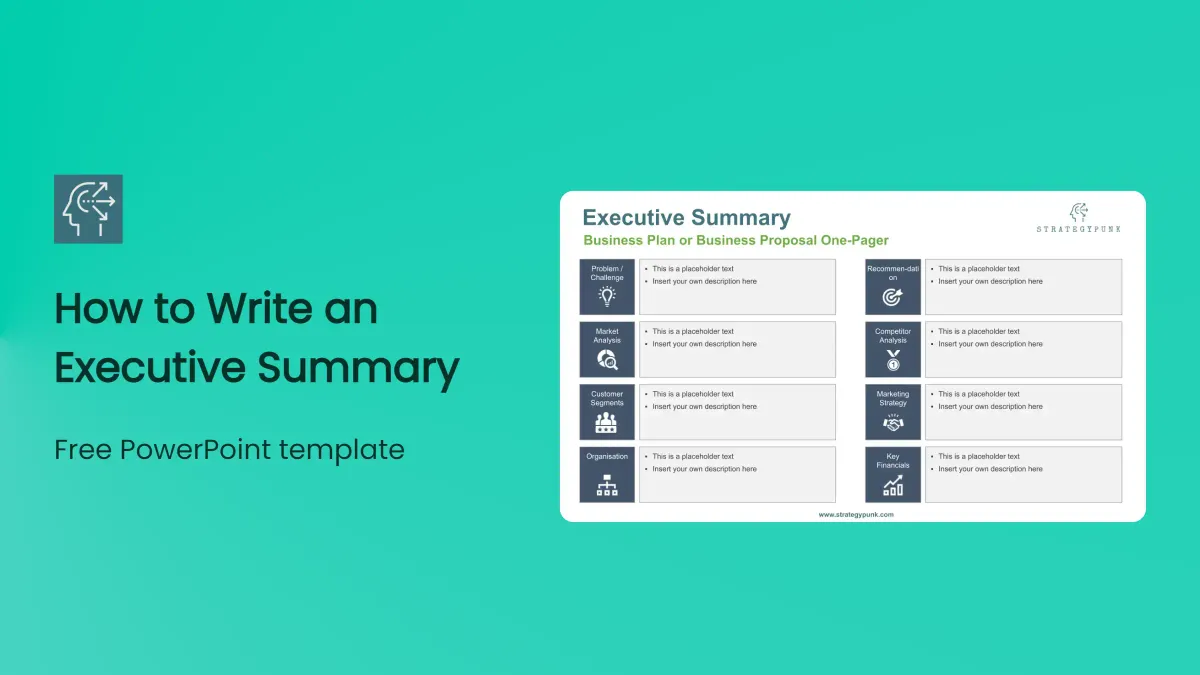
An executive summary (a business proposal or executive overview) concisely documents your business plan or business challenge. It should be able to stand alone, conveying the most important aspects of your business proposal in an easily digestible format.
Today, more than ever, executives are flooded with information. At any given moment, a busy executive can have on their desk an endless stream of memos, emails, reports, and documents requesting their attention. To stand out from the crowd and get noticed by the busy executive, you need to craft the executive summary of your paper so that it is concise and compelling.
A practical executive summary will inform and motivate the reader to dive deeper into the rest of your document.
Read on for more details about an executive summary and how to write one effectively.
What is an Executive Summary?
An executive summary is a concise overview of your business plan. This is the first section of your business proposal that executives, investors, or team members will read. The executive summary is usually the first section of a business plan, but it can also appear at the end of a report, following an introduction and other related material.
It is a short synopsis that highlights the report's main points and is meant to inform readers about the report’s findings and conclusions.
Why write an Executive Summary?
The benefits of an executive summary are two-fold:
Firstly, it allows readers to quickly assess whether the rest of the business plan is relevant to them – they can quickly evaluate the key points, decide what they want to read, and move on. This is useful if several executives or investors have requested your business plan.
Secondly, it allows you to craft a narrative tailored to your audience and speaks to their interests. So, even if your readers decide to read the entire business plan or proposal, they will understand it better because they have been given an overview beforehand.
A step-by-step guide to writing a compelling Executive Summary
The first thing to do is to ask yourself: Who is reading this? What are their interests? What do they want to know about my business? This will help you decide on your Executive Summary's content and tone.
Next, could you decide on the format? Most businesses write their Executive Summary in a slide or PowerPoint format. Executives or investors are accustomed to the design.
Could you decide on a headline that summarises your business? This can be a number, percentage, or statistic highlighting your key difference point. Choose the main points you want to cover in the summary and structure your Executive Summary accordingly.
An executive summary's purpose is to ensure you understand the main ideas of your writing clearly and concisely. It should be written so that a reader with only time to skim it can understand the critical points of your writing. Make sure to proofread your Executive Summary and align it with the rest of your analysis or argumentation before submitting it to an executive, board, or investors.
Some people use an executive summary as their first draft and then revise it for clarity based on feedback from readers.
What is the format of an executive summary?
Executive summary (sometimes called “summary”) is a one- to two-page overview of the main points in a written document. The purpose of the executive summary is to give readers a glance at the key issues and topics covered by the document.
The executive summary should be written first, followed by the rest of the body text elaborating on those points. In addition to summarizing a document, an executive summary can serve as a teaser for potential readers interested in reading more about the subject matter. When writing an executive summary, readers must remember that they want maximum clarity and brevity.
Avoid excessive detail and jargon — stick to high-level concepts and core ideas critical to understanding your document's content.
We recommend preparing the executive summary in PowerPoint or Google Slides format. Executives or investors are accustomed to the format.
What Information is included in an Executive Summary?
The executive summary is the first thing an executive or investor will read while looking at your business plan or proposal. A practical executive summary should include a compelling problem/challenge and recommendation.
So, what should I include in your executive summary to make it successful?
Problem (or Challenge)
The problem section of an executive summary should be concise but persuasive. This section should explain the problem to the reader without making them feel as if they are being sold something. Please keep it in a neutral tone.
Recommendation
The recommendation section should provide the solution to the problem, telling them why they need to invest in this idea. It must show how this solution is feasible.
A good executive summary has several vital features to support the argumentation:
- Market analysis
- Competitor analysis
- Customer segments (or Sales strategy)
- Marketing strategy
- Business structure (or Organisation)
- Key financials
Of course, more than one size fits solution is needed. You can adapt our template for your purposes. Our template is fully editable.
How long is an executive summary?
Try to create an executive summary that is between 5-10% of the length of the finished document (for a report or presentation that is 20 slides or less, create a one-page executive summary).
The executive summary is often the first thing an executive or investor reads when they receive your business plan or proposal. With this in mind, making it as engaging and compelling as possible is essential.
When you write your summary, it is also essential to consider who is reading it and what they want to know. By keeping these things in mind, you can write a compelling executive summary to catch an executive's or potential investors' attention.
Executive Summary Template
In powerpoint and google slides format (for subscribers).
Download the templates for free. 100% editable. Subscribe for free. It's perfect for any business professional or student.
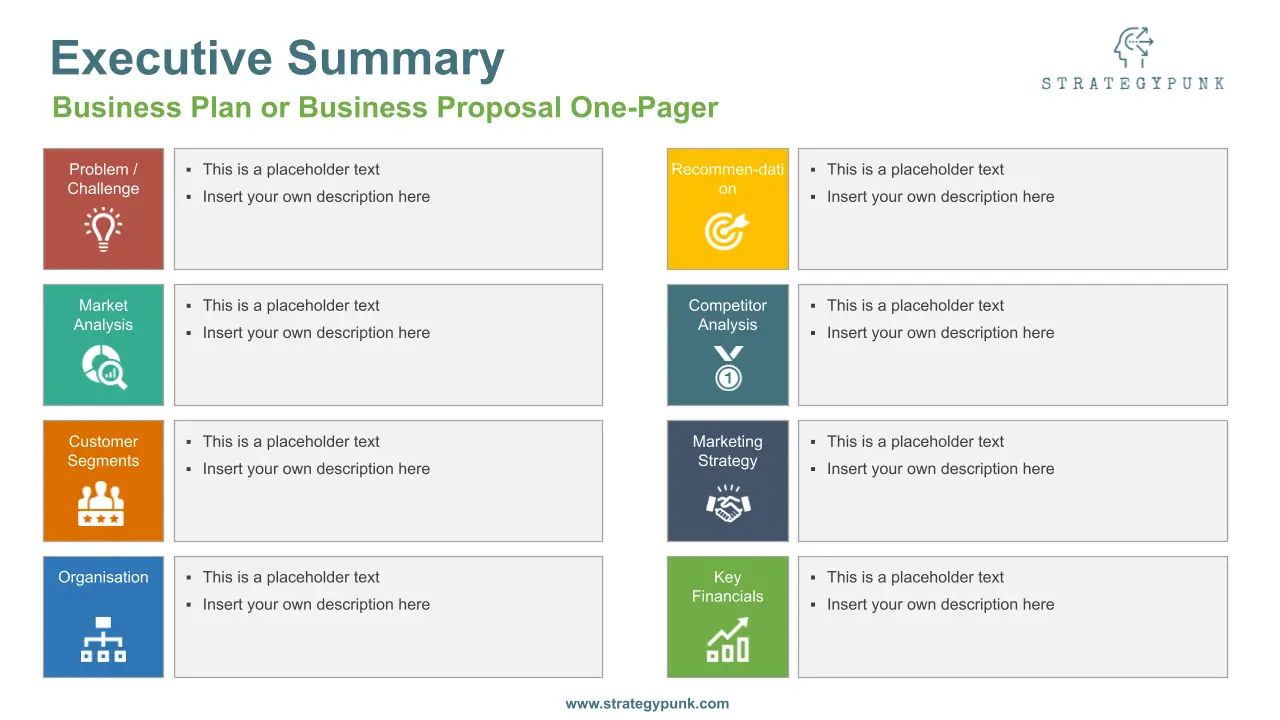
Xpeng SWOT Analysis: Free PPT Template and In-Depth Insights (free file)
Unlock key insights into Xpeng with our free SWOT analysis PPT template. Dive deep into its business dynamics at no cost.

Strategic Insights 2024: A SWOT Analysis of Nestle (Plus Free PPT)
Explore Nestle's strategic outlook with our SWOT analysis for 2024. This PowerPoint template highlights key areas for growth and challenges.
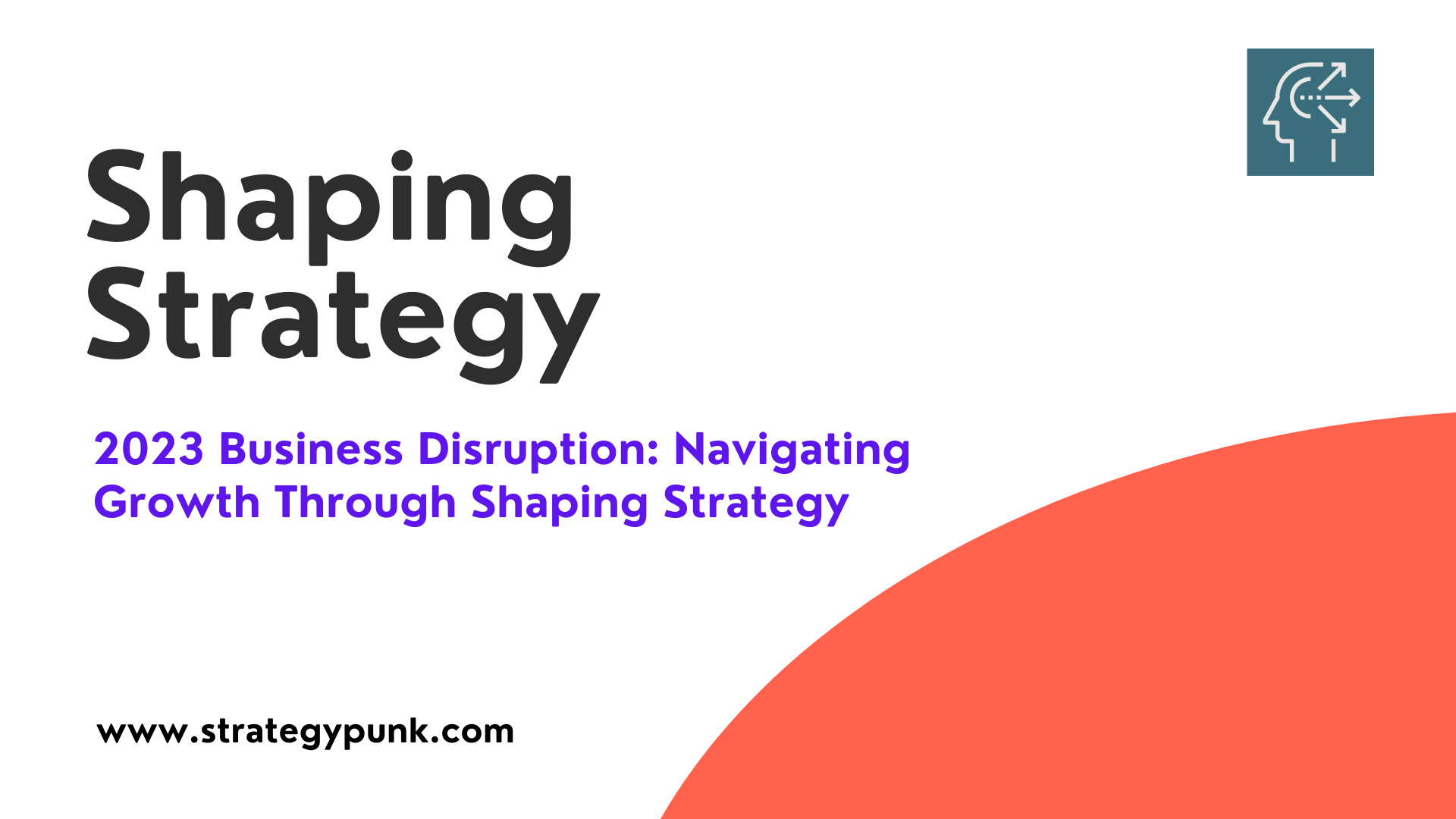
2024 Business Disruption: Navigating Growth Through Shaping Strategy
Discover the importance of being a shaper in 2023's business ecosystem. Shaping strategy, attracting a critical mass of participants, and finding the right strategic path to create value.
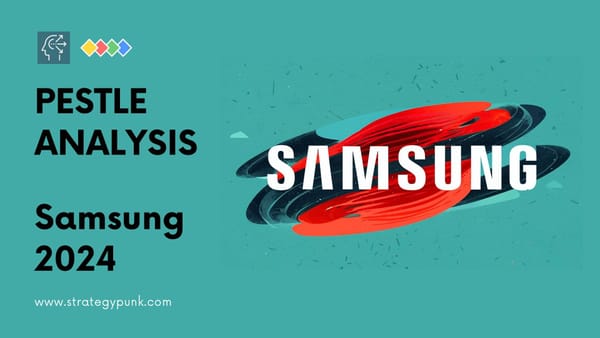
Samsung PESTLE Analysis: Unveiling the Driving Forces (Free PPT)
Download our comprehensive guide: Samsung PESTLE Analysis (Free PPT). Discover the strategic insights & driving forces shaping Samsung's future.
- Contact sales
Start free trial
How to Write an Executive Summary (Example & Template Included)

Here’s the good news: an executive summary is short. It’s part of a larger document like a business plan, business case or project proposal and, as the name implies, summarizes the longer report.
Here’s the bad news: it’s a critical document that can be challenging to write because an executive summary serves several important purposes. On one hand, executive summaries are used to outline each section of your business plan, an investment proposal or project proposal. On the other hand, they’re used to introduce your business or project to investors and other stakeholders, so they must be persuasive to spark their interest.
Writing an Executive Summary
The pressure of writing an executive summary comes from the fact that everyone will pay attention to it, as it sits at the top of that heap of documents. It explains all that follows and can make or break your business plan or project plan . The executive summary must know the needs of the potential clients or investors and zero in on them like a laser. Fortunately, we’ll show you how to write and format your executive summary to do just that.
Getting everything organized for your executive summary can be challenging. ProjectManager can help you get your thoughts in order and collaborate with your team. Our powerful task management tools make it easy to get everything prioritized and done on time. Try it free today.

What Is an Executive Summary?
An executive summary is a short section of a larger document like a business plan , investment proposal or project proposal. It’s mostly used to give investors and stakeholders a quick overview of important information about a business plan like the company description, market analysis and financial information.
It contains a short statement that addresses the problem or proposal detailed in the attached documents and features background information, a concise analysis and a conclusion. An executive summary is designed to help executives and investors decide whether to go forth with the proposal, making it critically important. Pitch decks are often used along with executive summaries to talk about the benefits and main selling points of a business plan or project.
Unlike an abstract, which is a short overview, an executive summary format is a condensed form of the documents contained in the proposal. Abstracts are more commonly used in academic and research-oriented writing and act as a teaser for the reader to see if they want to read on.

Get your free
Executive Summary Template
Use this free Executive Summary Template for Word to manage your projects better.
How to Write an Executive Summary
Executive summaries vary depending on the document they’re attached to. You can write an executive summary for a business plan, project proposal, research document, or business case, among other documents and reports.
However, when writing an executive summary, there are guidelines to ensure you hit all the bases.
Executive Summary Length
According to the many books that have been written about executive summaries, as well as training courses, seminars and professional speakers, the agreed-upon length for an executive summary format should be about five to 10 percent of the length of the whole report.
Appropriate Language
The language used should be appropriate for the target audience. One of the most important things to know before you write professionally is to understand who you’re addressing. If you’re writing for a group of engineers, the language you’ll use will differ greatly from how you would write to a group of financiers.
That includes more than just the words, but the content and depth of explanation. Remember, it’s a summary, and people will be reading it to quickly and easily pull out the main points.
Pithy Introduction
You also want to capture a reader’s attention immediately in the opening paragraph. Just like a speech often opens with a joke to break the tension and put people at ease, a strong introductory paragraph can pull a reader in and make them want to read on. That doesn’t mean you start with a joke. Stick to your strengths, but remember, most readers only give you a few sentences to win them over before they move on.
Don’t forget to explain who you are as an organization and why you have the skills, personnel and experience to solve the problem raised in the proposal. This doesn’t have to be a lengthy biography, often just your name, address and contact information will do, though you’ll also want to highlight your strengths as they pertain to the business plan or project proposal .
Relevant Information
The executive summary shouldn’t stray from the material that follows it. It’s a summary, not a place to bring up new ideas. To do so would be confusing and would jeopardize your whole proposal.
Establish the need or the problem, and convince the target audience that it must be solved. Once that’s set up, it’s important to recommend the solution and show what the value is. Be clear and firm in your recommendation.
Justify your cause. Be sure to note the key reasons why your organization is the perfect fit for the solution you’re proposing. This is the point where you differentiate yourself from competitors, be that due to methodology, testimonials from satisfied clients or whatever else you offer that’s unique. But don’t make this too much about you. Be sure to keep the name of the potential client at the forefront.
Don’t neglect a strong conclusion, where you can wrap things up and once more highlight the main points.
Related: 10 Essential Excel Report Templates
What to Include in an Executive Summary
The content of your executive summary must reflect what’s in the larger document which it is part of. You’ll find many executive summary examples on the web, but to keep things simple, we’ll focus on business plans and project proposals.
How to Write an Executive Summary for a Business Plan
As we’ve learned above, your executive summary must extract the main points of all the sections of your business plan. A business plan is a document that describes all the aspects of a business, such as its business model, products or services, objectives and marketing plan , among other things. They’re commonly used by startups to pitch their ideas to investors.
Here are the most commonly used business plan sections:
- Company description: Provide a brief background of your company, such as when it was established, its mission, vision and core values.
- Products & services: Describe the products or services your company will provide to its customers.
- Organization and management: Explain the legal structure of your business and the members of the top management team.
- SWOT analysis: A SWOT analysis explains the strengths, weaknesses, opportunities and threats of your business. They describe the internal and external factors that impact your business competitiveness.
- Industry & market analysis: This section should provide an overview of the industry and market in which your business will compete.
- Operations: Explain the main aspects of your business operations and what sets it apart from competitors.
- Marketing plan: Your marketing plan describes the various strategies that your business will use to reach its customers and sell products or services.
- Financial planning: Here, you should provide an overview of the financial state of your business. Include income statements, balance sheets and cash flow statements.
- Funding request: If you’re creating your business plan to request funding, make sure to explain what type of funding you need, the timeframe for your funding request and an explanation of how the funds will be used.
We’ve created an executive summary example to help you better understand how this document works when using it, to sum up a business plan.
To put all of that information together, here’s the basic format of an executive summary. You can find this same information in our free executive summary template :
- Introduction, be sure to know your audience
- Table of contents in the form of a bulleted list
- Explain the company’s role and identify strengths
- Explain the need, or the problem, and its importance
- Recommend a solution and explain its value
- Justify said solution by explaining how it fits the organization
- A strong conclusion that once more wraps up the importance of the project
You can use it as an executive summary example and add or remove some of its elements to adjust it to your needs. Our sample executive summary has the main elements that you’ll need project executive summary.

Executive Summary Example
For this executive summary example, we’ll imagine a company named ABC Clothing, a small business that manufactures eco-friendly clothing products and it’s preparing a business plan to secure funding from new investors.
Company Description We are ABC Clothing, an environmentally-friendly manufacturer of apparel. We’ve developed a unique method of production and sourcing of materials that allows us to create eco-friendly products at a low cost . We have intellectual property for our production processes and materials, which gives us an advantage in the market.
- Mission: Our mission is to use recycled materials and sustainable methods of production to create clothing products that are great for our customers and our planet.
- Vision: Becoming a leader in the apparel industry while generating a positive impact on the environment.
Products & Services We offer high-quality clothing products for men, women and all genders. (Here you should include pictures of your product portfolio to spark the interest of your readers)
Industry & Market Analysis Even though the fashion industry’s year-over-year growth has been affected by pandemics in recent years, the global apparel market is expected to continue growing at a steady pace. In addition, the market share of sustainable apparel has grown year-over-year at a higher pace than the overall fashion industry.
Marketing Plan Our marketing plan relies on the use of digital marketing strategies and online sales, which gives us a competitive advantage over traditional retailers that focus their marketing efforts on brick-and-mortar stores.
Operations Our production plant is able to recycle different types of plastic and cotton waste to turn it into materials that we use to manufacture our products . We’ve partnered with a transportation company that sorts and distributes our products inside the United States efficiently and cost-effectively.
Financial Planning Our business is profitable, as documented in our balance sheet, income statement and cash flow statement. The company doesn’t have any significant debt that might compromise its continuity. These and other financial factors make it a healthy investment.
Funding Request We’re requesting funding for the expansion of our production capacity, which will allow us to increase our production output in order to meet our increasing customer demand, enter new markets, reduce our costs and improve our competitiveness.
If you’d like to see more executive summary examples for your business plan, you can visit the U.S. small business administration website. They have business plans with executive summary examples you can download and use.
Executive summaries are also a great way to outline the elements of a project plan for a project proposal. Let’s learn what those elements are.
How to Write an Executive Summary for a Project Proposal
An executive summary for your project proposal will capture the most important information from your project management plan. Here’s the structure of our executive summary template:
- Introduction: What’s the purpose of your project?
- Company description: Show why you’re the right team to take on the project.
- Need/problem: What is the problem that it’s solving?
- Unique solution: What is your value proposition and what are the main selling points of your project?
- Proof: Evidence, research and feasibility studies that support how your company can solve the issue.
- Resources: Outline the resources needed for the project
- Return on investment/funding request: Explain the profitability of your project and what’s in for the investors.
- Competition/market analysis: What’s your target market? Who are your competitors? How does your company differentiate from them?
- Marketing plan: Create a marketing plan that describes your company’s marketing strategies, sales and partnership plans.
- Budget/financial planning: What’s the budget that you need for your project plan?
- Timeline: What’s the estimated timeline to complete the project?
- Team: Who are the project team members and why are they qualified?
- Conclusions: What are the project takeaways?
Now that we’ve learned that executive summaries can vary depending on the type of document you’re working on, you’re ready for the next step.
What to Do After Writing an Executive Summary
As with anything you write, you should always start with a draft. The first draft should hit all the marks addressed above but don’t bog yourself down in making the prose perfect. Think of the first draft as an exploratory mission. You’re gathering all the pertinent information.
Next, you want to thoroughly review the document to ensure that nothing important has been left out or missed. Make sure the focus is sharp and clear, and that it speaks directly to your potential client’s needs.
Proofread for Style & Grammar
But don’t neglect the writing. Be sure that you’re not repeating words, falling into cliché or other hallmarks of bad writing. You don’t want to bore the reader to the point that they miss the reason why you’re the organization that can help them succeed.
You’ve checked the content and the prose, but don’t forget the style. You want to write in a way that’s natural and not overly formal, but one that speaks in the manner of your target audience . If they’re a conservative firm, well then, maybe formality is called for. But more and more modern companies have a casual corporate culture, and formal writing could mistakenly cause them to think of you as old and outdated.
The last run should be proofing the copy. That means double-checking to ensure that spelling is correct, and there are no typos or grammatical mistakes. Whoever wrote the executive summary isn’t the best person to edit it, however. They can easily gloss over errors because of their familiarity with the work. Find someone who excels at copy-editing. If you deliver sloppy content, it shows a lack of professionalism that’ll surely color how a reader thinks of your company.
Criticism of Executive Summaries
While we’re advocating for the proper use of an executive summary, it’d be neglectful to avoid mentioning some critiques. The most common is that an executive summary by design is too simple to capture the complexity of a large and complicated project.
It’s true that many executives might only read the summary, and in so doing, miss the nuance of the proposal. That’s a risk. But if the executive summary follows the guidelines stated above, it should give a full picture of the proposal and create interest for the reader to delve deeper into the documents to get the details.
Remember, executive summaries can be written poorly or well. They can fail to focus on results or the solution to the proposal’s problem or do so in a vague, general way that has no impact on the reader. You can do a hundred things wrong, but if you follow the rules, then the onus falls on the reader.
ProjectManager Turns an Executive Summary Into a Project
Your executive summary got the project approved. Now the real work begins. ProjectManager is award-winning project management software that helps you organize tasks, projects and teams. We have everything you need to manage each phase of your project, so you can complete your work on time and under budget.
Work How You Want
Because project managers and teams work differently, our software is flexible. We have multiple project views, such as the kanban board, which visualizes workflow. Managers like the transparency it provides in the production cycle, while teams get to focus only on those tasks they have the capacity to complete. Are you more comfortable with tasks lists or Gantt charts? We have those, too.

Live Tracking for Better Management
To ensure your project meets time and cost expectations, we have features that monitor and track progress so you can control any deviations that might occur. Our software is cloud-based, so the data you see on our dashboard is always up to date, helping you make better decisions. Make that executive summary a reality with ProjectManager.

You’ve now researched and written a persuasive executive summary to lead your proposal. You’ve put in the work and the potential client sees that and contracts you for the project. However, if you don’t have a reliable set of project management tools like Gantt charts , kanban boards and project calendars at hand to plan, monitor and report on the work, then all that preparation will be for nothing.
ProjectManager is online project management software that gives you real-time data and a collaborative platform to work efficiently and productively. But don’t take our word for it, take a free 30-day trial.

Deliver your projects on time and under budget
Start planning your projects.

- Certifications

Crafting the Perfect Executive Summary in PowerPoint
- December 27, 2022
- 93 Comments
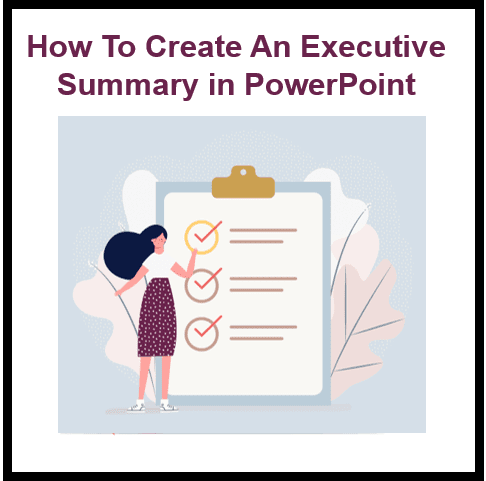
An executive summary is a short presentation of the most important points in your business plan. It serves to provide an overview of the company, its products, and its goals. It’s one of the first things potential investors will want to see when you are pitching your company.
However, no two companies are exactly alike, which means there isn’t a single template for an executive summary. Instead, it’s up to you to tailor the presentation according to the type of funding you are seeking. If you are raising capital from private investors or venture capitalists, be sure that your executive summary has enough information about your key risks and competitive advantages.
For government grants or loans, focus on how your business plan will benefit society and create jobs. And for crowdfunding campaigns, highlight the social media following and number of backers that you already have in order to attract potential donors.
An executive summary is a brief overview of your company’s business. It usually includes the company’s vision, some financials such as revenue and earnings, and its goals for the future. This document is often shared with potential investors or other key stakeholders to give them a concise, easy-to-read overview of what you’re all about. A well-written executive summary, crafted with precision and care, serves as a crucial asset for any company. This succinct document can significantly enhance your prospects during fundraising and M&A endeavors. Utilizing a proficient summary generator can streamline the process and improve the overall quality of your executive summary.
The goal of this task is not only to explain what you would like to present, but also summarize the key points of your presentation . Here are some tips on how to create one that will make a lasting impression on anyone who reads it.
What is an executive summary?
An executive summary is one of the most important documents in your company. It’s a one-page document that summarizes your company. This document is often shared with potential investors or other key stakeholders in your company to give them a concise overview of the company’s business.
Why is an Executive Summary important?
An executive summary is an important document because it is one of the first things people will read about your company. If you want to make an impression on a potential investor , it’s important that your executive summary stands out and gets their attention.
A good executive summary should be concise and easy to read, with the goal of summarizing the key points of your presentation. A poorly written or confusing executive summary can cause your business to not get as much interest as you would like.
In this article we’ll provide 3 best practices for creating an effective summary in PowerPoint : 1) create a brief summary of your presentation including the key points; 2) identify and summarize each section of your presentation; 3) highlight the main takeaway and how it solves the problem. Not sure where to start? We’ve got some tips that will help you out!
Who reads the Executive Summary?
The Executive Summary is usually distributed to potential investors or other key stakeholders. The goal is to engage them and keep them interested in your business!
Begin by introducing the company, including its background information and current financials. Include an overview of the company’s strategy for the future. This should include what the company hopes to accomplish in the next 1-2 years. Finally, provide an outlook of what might happen if they implement their plan.
Don’t forget to include any other salient information about your company that might be important to your readers (for example, if you are a small privately-held company).
How to Create a Successful Executive Summary
Business-focused presentations often include an executive summary, and it’s important to know how to create one. This document is a quick overview of your company’s business and should be concise and easy to read.
How to highlight the main takeaway and how it solves the problem
Your presentation is not always going to have a single takeaway. It’s important to identify the main story of your presentation and how it solves the problem.
A great example of this is what we see in movies, when there’s the big reveal at the end of the film. This is often done by showing what was really happening throughout the movie, but it could also show how one event led to another event.
The purpose of this is to keep your audience engaged for longer periods of time. You want them to stay focused on your message and remember what you’re saying. It should be easy for them to understand where you’re coming from, why you’re talking about it, and how they can benefit by listening to you.
How to identify and summarize each section of your presentation
When you’re summarizing each section of your presentation, it’s important to be as concise as possible. You want to briefly cover the key points of that section.
For example, if you have a PowerPoint slide about your company’s vision, it would be helpful to summarize what your business is trying to achieve in the near future. The key points are the things that are most relevant for investors or other decision makers.
Another example would be if you have a slide on how your company is performing financially. If this slide includes revenue and earnings , then it would be helpful to include some projections for the following year. This can help potential investors make an informed decision about investing in your company.
General tips for making a successful executive summary
-Keep it brief. Your summary should be concise and to the point. Provide the key points of your presentation without too much detail. The goal is not to provide an in-depth description, but to clarify what you would like to present.
-Be clear about your intentions. This is a summary of your presentation, so it should include which audience you want to present to and why this topic is important to that audience.
-Provide an overview of each section of the presentation. It’s often helpful for readers to see all the information in one place rather than reading through slides one by one.
-End with a takeaway message or how it solves the problem at hand. Think about what your audience will remember most from your summary and make sure that’s included in the final paragraph!
Tips for different industries
Tips for a tech company.
Tech companies are in a fiercely competitive market. Considering that, it’s important for them to use all the tools at their disposal to get ahead of the competition. Some of the tools include executive summaries—a brief overview of your company’s business.
Tips for a law firm
If you work in a law firm, these 3 tips will help you create a good summary for your executive summary.
In the business world, the term “partner” is often associated with someone who has been working with a company for many years and is an integral part of the organization. A partner often has a stake in the company, takes on leadership roles, and is responsible for helping to set the long-term goals. Becoming a partner is usually a clear sign that an employee is trusted and valued by their company.
Tips for the fashion industry
Are you in the fashion industry? If so, your biggest competitor is up-to-date trends. The fashion world moves fast. But to stay on top of the game, it’s important to be aware of what’s happening in the industry and know what consumers want.
-Stay on top of current trends by reading trade magazines or having a subscription to a website that provides overviews on what’s new in the industry.
-Keep a running list of all the brands you’re interested in and note any items from those brands that you want, as well as why they’re on your list. This is a good way to help remember trends or styles that interest you.
-Gain inspiration from other industries as well! Fashion often takes cues from other industries such as architecture, art, and engineering.
An executive summary is an important document that can help you get your message across to your audience. Hope the above information was useful to understand what an executive summary is, what it’s used for, how to create one, and what you should be aware of when writing one.
Share This Post:
93 thoughts on “crafting the perfect executive summary in powerpoint”.
Wonderful goods from you, man. I have understand your stuff previous to and you’re just too great. I actually like what you’ve acquired here, certainly like what you’re stating and the way in which you say it. You make it entertaining and you still take care of to keep it sensible. I cant wait to read far more from you. This is really a wonderful site.
Some really interesting info , well written and broadly speaking user genial.
A big thank you for your blog.Thanks Again. Want more.
I truly appreciate this blog post.Much thanks again. Cool.
A round of applause for your blog post.Much thanks again.
Appreciate you sharing, great blog post.Thanks Again. Great.
Thanks for sharing, this is a fantastic article.Really looking forward to read more. Keep writing.
A big thank you for your blog post. Really Cool.
I really liked your blog.Really thank you!
A big thank you for your blog article.Thanks Again. Cool.
Really appreciate you sharing this article.Really looking forward to read more. Cool.
I value the blog.Thanks Again. Keep writing.
Hey, thanks for the article.Really thank you!
I really liked your article.Really thank you! Really Cool.
Very informative article.Really thank you! Want more.
Fantastic blog article.Really looking forward to read more. Fantastic.
This is one awesome blog post.Much thanks again. Much obliged.
Thank you for your article post. Much obliged.
I am so grateful for your blog post.Much thanks again. Much obliged.
A big thank you for your post.Really thank you! Awesome.
This is one awesome blog article.Thanks Again. Cool.
Im grateful for the article. Fantastic.
Very neat post. Great.
Major thankies for the post. Really Cool.
Very neat blog article.Thanks Again. Really Great.
Great, thanks for sharing this blog post. Want more.
Great, thanks for sharing this blog article.Really thank you! Really Great.
Major thankies for the blog.Thanks Again.
Major thankies for the article post.Really thank you! Great.
Thanks a lot for the article post.Really looking forward to read more. Great.
I am so grateful for your article post.Much thanks again.
I am so grateful for your blog article.Much thanks again. Keep writing.
Fantastic blog.Really thank you! Fantastic.
Thank you ever so for you blog article.Much thanks again. Much obliged.
Thanks again for the article.Really thank you! Great.
Very neat post.Really looking forward to read more. Really Great.
Major thankies for the article. Will read on…
I really liked your blog article.Really thank you! Great.
Thanks again for the post.Really thank you! Awesome.
Major thanks for the post.Much thanks again. Want more.
Thanks again for the article post.Really thank you! Keep writing.
I think this is a real great blog.Much thanks again. Much obliged.
Great, thanks for sharing this blog article.Really thank you! Cool.
Great, thanks for sharing this blog post.Really thank you! Will read on…
Thanks a lot for the post.Really thank you! Much obliged.
Really informative blog article.Really looking forward to read more.
Thanks for the article post.Really looking forward to read more. Fantastic.
Very good post.Really looking forward to read more. Awesome.
Thanks-a-mundo for the article.Much thanks again. Really Cool.
Major thanks for the blog.Really thank you! Really Cool.
Im thankful for the article.Thanks Again. Much obliged.
Muchos Gracias for your blog.Really looking forward to read more. Want more.
Great article post.Much thanks again. Much obliged.
I really like and appreciate your blog. Will read on…
Great article post.Really thank you! Want more.
I really like and appreciate your blog. Will read on…
I really liked your post.Really looking forward to read more. Great.
I cannot thank you enough for the article post.Really thank you! Really Great.
I truly appreciate this article. Really Great.
Thanks a lot for the article.Really looking forward to read more. Much obliged.
I really like and appreciate your blog.Really looking forward to read more. Want more.
Thank you for your post.Really thank you! Keep writing.
I really like and appreciate your blog article. Keep writing.
Very neat article.Really thank you!
I cannot thank you enough for the blog article.Thanks Again. Will read on…
Say, you got a nice blog.Really thank you! Awesome.
Thanks a lot for the article.Really looking forward to read more. Really Cool.
Im grateful for the blog.Really looking forward to read more. Much obliged.
Fantastic blog article.Much thanks again. Want more.
I really like and appreciate your blog post.Much thanks again. Want more.
Thanks again for the blog.Really looking forward to read more. Keep writing.
Thanks for the blog.
Really enjoyed this article.Much thanks again. Really Great.
Thanks a lot for the article. Awesome.
I cannot thank you enough for the blog post.Really looking forward to read more.
Im thankful for the blog post.Much thanks again. Fantastic.
Very informative article. Want more.
Say, you got a nice blog.Really thank you! Will read on…
Major thankies for the blog.Really thank you! Will read on…
Im grateful for the blog. Will read on…
This is one awesome blog article.Really looking forward to read more. Great.
Say, you got a nice blog article.Much thanks again. Cool.
Major thanks for the blog. Much obliged.
I appreciate you sharing this article.Really looking forward to read more. Cool.
Very informative blog.Thanks Again. Really Cool.
Fantastic blog post.Thanks Again. Really Great.
Hey, thanks for the blog article. Awesome.
A big thank you for your post.Thanks Again.
Thank you ever so for you blog article. Will read on…
Thanks-a-mundo for the blog post.Really looking forward to read more. Will read on…
I appreciate you sharing this blog article.Much thanks again. Really Cool.
Great, thanks for sharing this blog post.Much thanks again. Much obliged.
Thank you for your article.Much thanks again. Great.
Add a Comment Cancel reply
Save my name, email, and website in this browser for the next time I comment.
Get A 5X Raise In Salary

Reset Password
Insert/edit link.
Enter the destination URL
Or link to existing content

Researched by Consultants from Top-Tier Management Companies

Powerpoint Templates
Icon Bundle
Kpi Dashboard
Professional
Business Plans
Swot Analysis
Gantt Chart
Business Proposal
Marketing Plan
Project Management
Business Case
Business Model
Cyber Security
Business PPT
Digital Marketing
Digital Transformation
Human Resources
Product Management
Artificial Intelligence
Company Profile
Acknowledgement PPT
PPT Presentation
Reports Brochures
One Page Pitch
Interview PPT
All Categories
Top 7 Executive Summary Templates With Samples and Examples
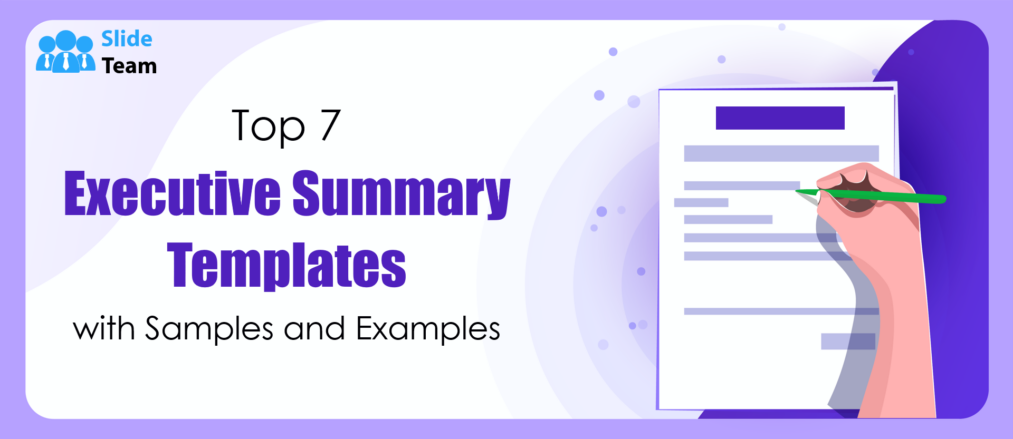
Naveen Kumar
C-suite executives are akin to budget shoppers in Walmart. Neither of them spends time or money on things that are not necessary. While budget shoppers make budgets or shopping lists, business persons depend on short versions of documents like executive summaries to manage their time. In the vast landscape of reports, analyses, and proposals, where every minute counts and decisions hold the weight of an entire enterprise, the executive summary emerges as a strategic tool that condenses the essence of information into a concise format.
Executive Summaries: Your Shortcut to Information Nirvana
An executive summary is a concise and condensed overview of a document, report, or presentation. It provides busy executives, decision-makers, or stakeholders with a quick and comprehensive understanding of the main points, key findings, recommendations, and essential insights within the document. An executive summary captures vital information in a way that allows the reader to grasp the main ideas without reading the entire document. For that, it should include:
- Context and Purpose : The background and purpose of the document highlight why the information is important and relevant.
- Findings : Summarize the key discoveries, results, or conclusions. Highlight the essential data, trends, or insights that the document presents.
- Recommendations : If applicable, provide any suggestions or action points that arise from the findings. These could be advice for future actions, strategies, or decisions based on the information provided in the document.
- Key Points : Condense the main points of each section or topic covered in the full document. It helps the reader understand the document's structure and scope.
- Data and Evidence : Highlight significant data, statistics, or evidence supporting the findings or conclusions of the document.
- Conclusion : Summarize the overall implications or significance of the information presented and reiterate its importance to the reader.
Executive summaries are used in business, academia, research, and various professional settings to communicate important information in a quick manner to individuals who do not have the time or need to read the entire document. These succinct snapshots offer a remarkable advantage, allowing decision-makers to grasp the essence of complex matters without being bogged down by exhaustive details.
Simplify Documents With Executive Summary Templates
The effectiveness of an executive summary lies in its structure, brevity, and ability to encapsulate critical insights.
Our executive summary templates emerge as indispensable tools to assist professionals in making these documents the most effective with less time and effort. These content-ready slides, crafted with careful consideration of best practices, provide a much-needed structure that streamlines the process of condensing extensive content into a concise yet impactful format. The 100% customizable nature of these designs gives the desired flexibility to create professional executive summaries and presentations that make messages accessible and compelling and ensure effective communication of key points.
From a high-stakes board meeting to presenting research findings, these executive summary templates can be the key to delivering resonating information. Let's dive in!
1. Executive Summary PowerPoint Presentation Deck
Step into a world of concise brilliance with our versatile collection of industry-tailored executive summary templates, catering to diverse sectors like food and beverage, IT organizations , soft drink companies, car manufacturing organizations, consumer goods firms, fashion clothing brands, consultancy services, and cement companies. These PPT Designs encapsulate the essence of your business, ensuring key insights are conveyed in an effective manner. Crafted for leaders, managers, and decision-makers, our deck equips you with the tools to captivate your audience and convey critical information. Whether you're presenting to stakeholders, colleagues, or clients, these PowerPoint Slides empower you to distill complex data into impactful executive summaries that shine. Download it now!
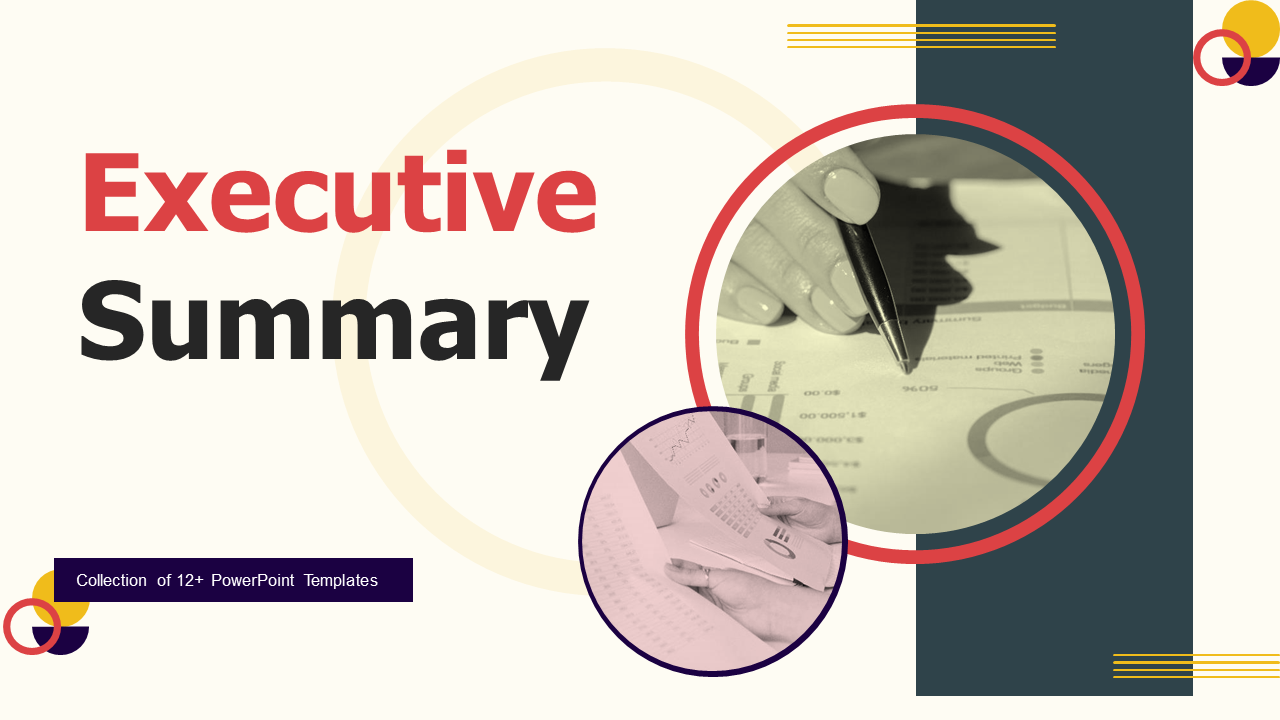
Download this template
2. Outsourcing Proposal Executive Summary Presentation Deck
Revolutionize the way you present your outsourcing strategies with a single click with our meticulous and expert-designed slides that redefine clarity and impact. This exhaustive collection empowers you to communicate your company's mission, vision, and meeting agendas. Display problems and solutions with precision using executive dashboards, financial insights, target market analyses, and growth matrices. Elevate your workforce's strategic prowess as you unveil unique selling propositions, value proposition expansions, feedback loops, and profit margin possibilities. From product sales volumes to action plans and desired outcomes, this PowerPoint Set becomes your compass in crafting a compelling outsourcing proposal. Get it now!
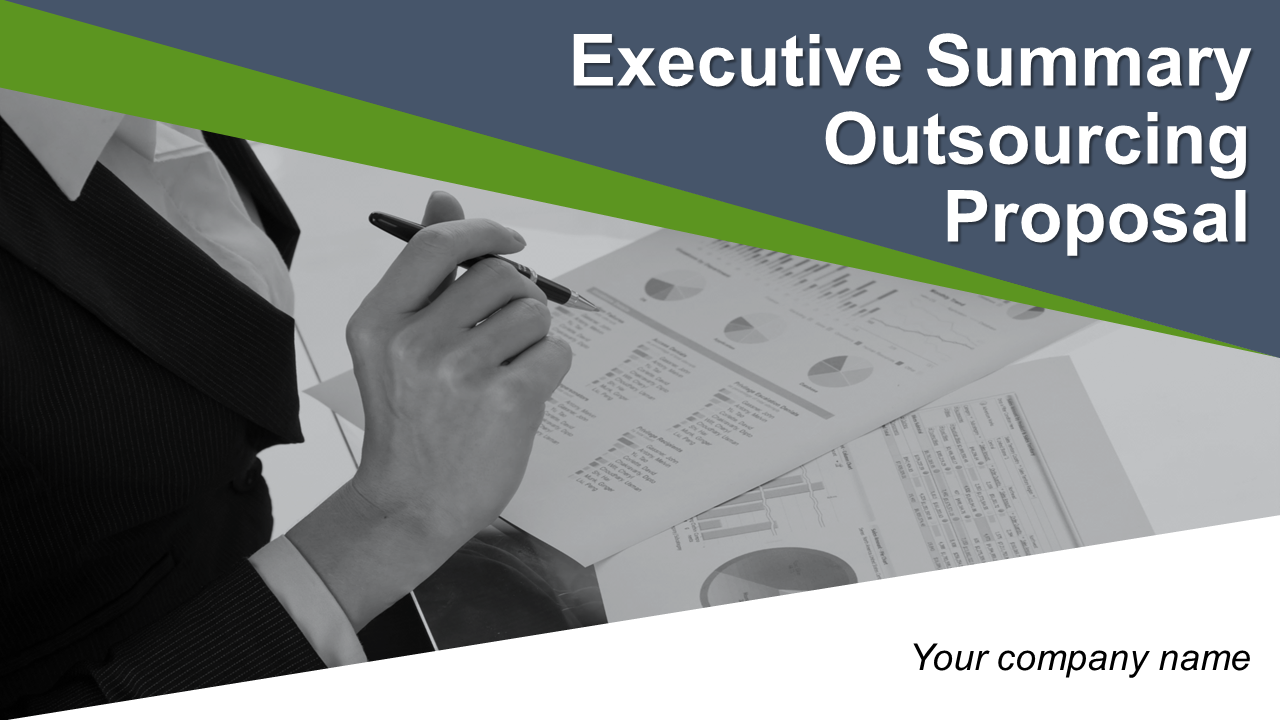
3. Marketing Plan Executive Summary Presentation Template
The well-organized sections of this executive summary presentation slide unveil a panoramic company overview, defined target markets, and the quintessential roadmap of marketing strategies that foster exponential growth. This PPT template empowers entrepreneurs, marketing mavens, and visionary leaders to distill complex marketing plans into masterful executive summaries that resonate. From captivating company narratives to laser-focused target market analyses and growth-oriented strategies, each slide is a canvas for your ideas to flourish. Grab it today!
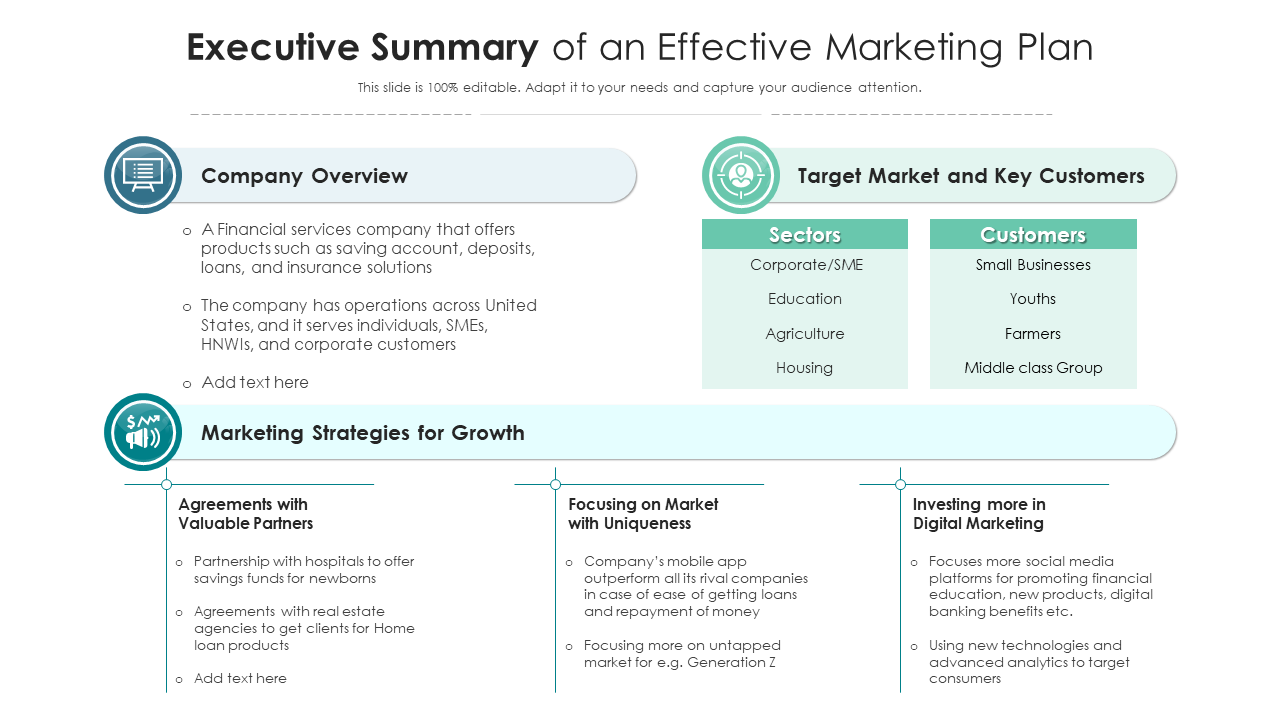
4. Project Report Executive Summary Presentation Template
This ready-to-use one-page PPT Layout unravels a scenic project overview, showcasing key milestones achieved and the visionary roadmap ahead. Dive into financial insights, and navigate the deliverable timeline and the tempest of key project risks with the seamless guidance of this concise yet comprehensive presentation layout. It empowers you to condense intricate project reports into simplified executive summaries that resonate. Fuel your insights with visual storytelling through charts and timelines that command attention. Download it now!
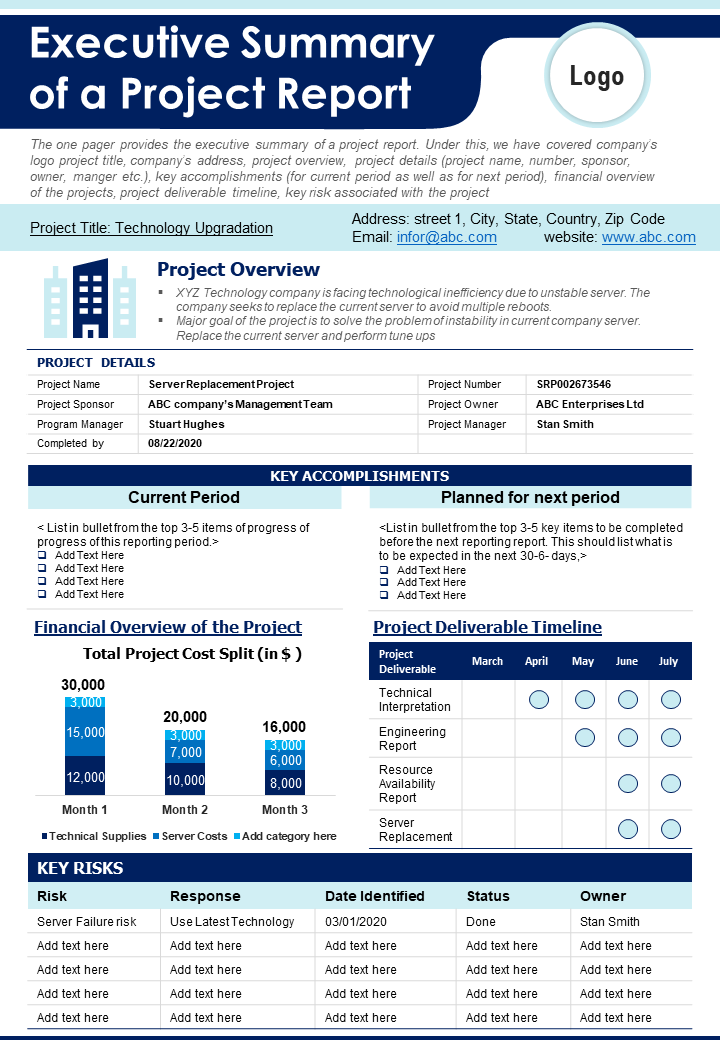
5. Startup Company Executive Summary Presentation Template
Unveil your brilliance in a single glance and ignite the potential of your startup journey with our one-page startup executive summary design. This presentation slide is a masterpiece that showcases your business vision, accomplishments, and expertise, in one cohesive page. It empowers you to capture the very essence of your startup in a succinct yet impactful manner. From the business landscape to a financial trajectory, every element of this one-page PPT Slide is a stroke of strategic genius. With our PowerPoint template, you can present your business mission, products, and core team, while showcasing your readiness to excel with confidence. This slide becomes your beacon for pitching, investor meetings, and networking events. Get it now!
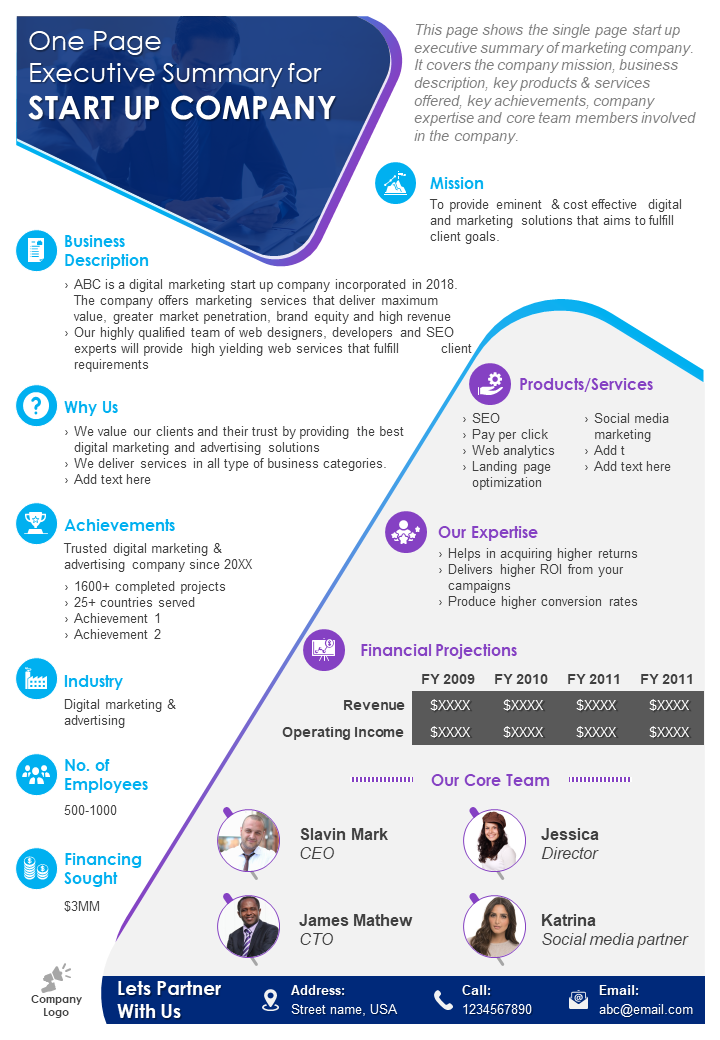
6. Investment Pitch Executive Summary Presentation Template
This single-page investment template is a symphony of insights curated for startups, visionaries, and audacious entrepreneurs ready to shake the investment landscape. This template packs a punch in portraying your venture's essence, from company details to your dream team. Dive into the intricacies of customer conundrums and unveil how your solutions are second to none. With a flick of the slide, showcase your rivals and assert your competitive edge like a chess master. The revenue model unfolds, aligning visions of profit and growth. Reveal how investor funds will be used and the exit strategy to give investors a VIP pass to the thrilling last act of acquisition by venture capital. Grab it today!
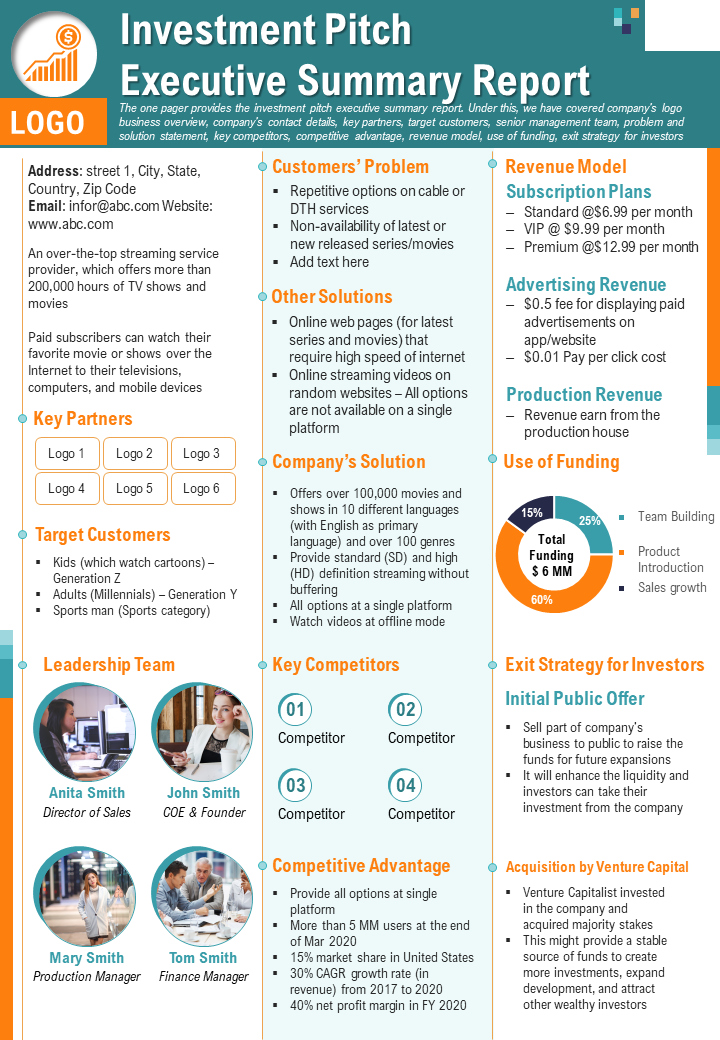
7. Business Executive Summary Presentation Template
Your business brilliance meets a canvas of clarity and impact with our one-page presentation template. This template unravels your business in a single glance with finesse. Let the audience understand your business with an overview that sets the stage. Your mission and vision unfold with key offerings and innovation. Numbers come alive with a bar chart on your financial journey and a pie chart showcasing the competitive markets and market share. Highlight your competitive advantages with a table about your strengths and weaknesses. The business executive summary presentation template gives a snapshot of your historical footprints leading to your current spotlight. Download it now!
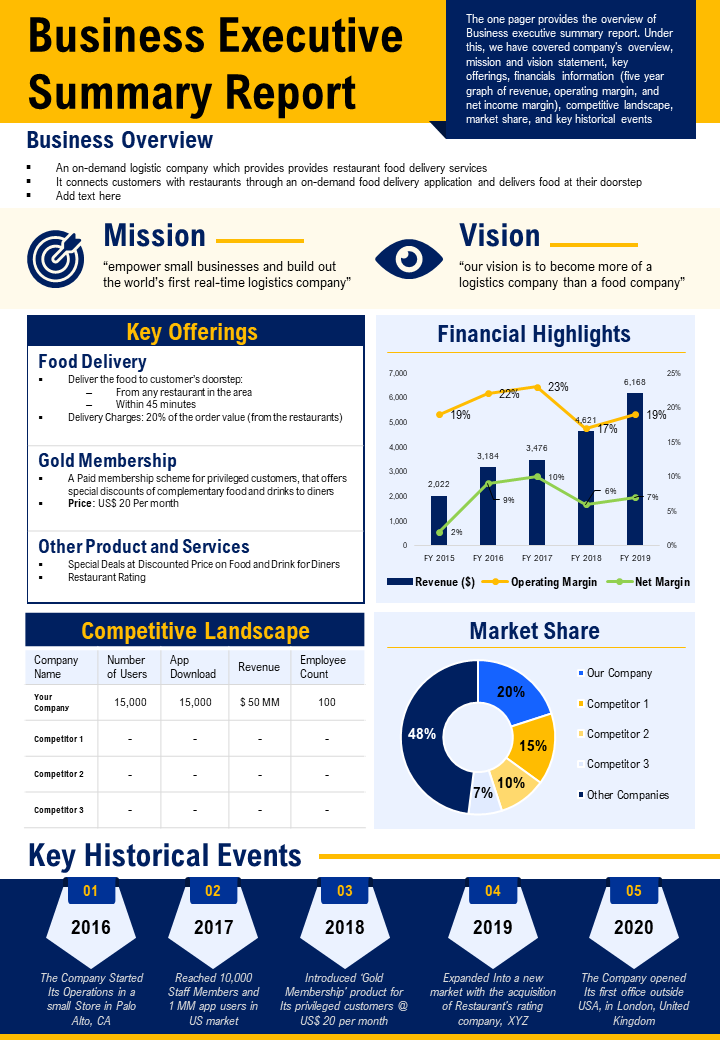
From Seconds to Success!
In today's fast-paced business landscape, the importance of executive summaries cannot be understated. These succinct snapshots distill complex information into vital components, enabling decision-makers to comprehend and act upon key insights in a swift way. Studies have shown that professionals spend an average of just a few seconds to minutes perusing documents before making critical judgments. This highlights the critical role that executive summaries play in capturing attention and conveying value in the shortest time.
An effective executive summary is akin to a guiding beacon for leaders navigating the labyrinth of meetings, reports, and strategic decisions. In a world where clear communication is a cornerstone of success, a well-crafted executive summary can catalyze impactful presentations, engage stakeholders, and steer organizations toward their objectives.
This is where our executive summary templates come into play. These well-thought-out and expert-designed PPT Slides are powerful tools that empower professionals to create concise, compelling, and crystal-clear executive summaries. Organized to cover the essentials – from purpose and findings to recommendations and impact – these designs streamline the process of refining information without sacrificing substance.
Make every word count and every moment matter in your presentation with these executive summary templates.
FAQs on Executive Summary
What is an executive summary.
An executive summary is a concise and condensed version of a document, report, or proposal. It is designed to provide a high-level overview of the main points, findings, and recommendations of the document, allowing busy professionals to grasp the essential information without reading the entire content. In business, research, marketing, and other fields, executive summaries are used to communicate key information to decision-makers, stakeholders, and other interested parties.
What is included in the executive summary?
What's included in an executive summary can vary depending on the type of document it summarizes, but it should cover the following:
- Purpose/Objective : State the purpose of the document and what it aims to achieve in a brief manner.
- Context/Background : Provide a brief introduction to the topic, context, or problem the document addresses.
- Main Findings/Key Points : Highlight the most important findings, insights, or key points from the document.
- Recommendations/Actions : If applicable, outline the main recommendations or actions that are suggested based on the findings.
- Conclusion : Summarize the main results drawn from the document.
- Benefits/Impact : Explain the potential benefits or impact of the findings and recommendations.
- Target Audience : Specify who the document is intended for and who would benefit from reading the full version.
- Scope/Limitations : Brief the limitations or constraints of the document's findings.
- Visuals : Use visuals like charts, graphs, or diagrams to support key points.
How to make an executive summary?
To create an effective executive summary:
- Read the Document : Before writing the summary, read the entire document to understand its content and key points.
- Identify Key Information : Identify the most crucial information, findings, and recommendations from the document.
- Be Concise : Keep your sentences short and to the point. Avoid unnecessary details or jargon.
- Maintain Flow : Structure the summary in a logical way, following the order of the main document's sections.
- Use Clear Language : Write in clear, straightforward language your target audience can easily understand.
- Focus on Impact : Emphasize the impact of the findings and why they matter.
- Proofread and Edit : Review the summary for grammar, punctuation, and clarity. Ensure it captures the essence of the original document in an effective way.
- Tailor to Audience : Customize the tone and level of detail based on the knowledge and interests of your audience.
- Include Visuals : If appropriate, incorporate visuals to illustrate key points.
Related posts:
- Top 10 Business Executive Summary Templates That Add Value To Your Business Documents!
- [Updated 2023] Presenting the most effective One-Page Executive Summary for Startups [with templates designed by professionals]
- [Updated 2023] Top 50 Most Effective Executive Summary Templates [includes One pagers and Full Templates] To Impress Your Clients
- Top 20 Executive Summary Templates To Attract Investors
Liked this blog? Please recommend us

Top 5 Executive Summary Sample for Project Report Templates with Examples
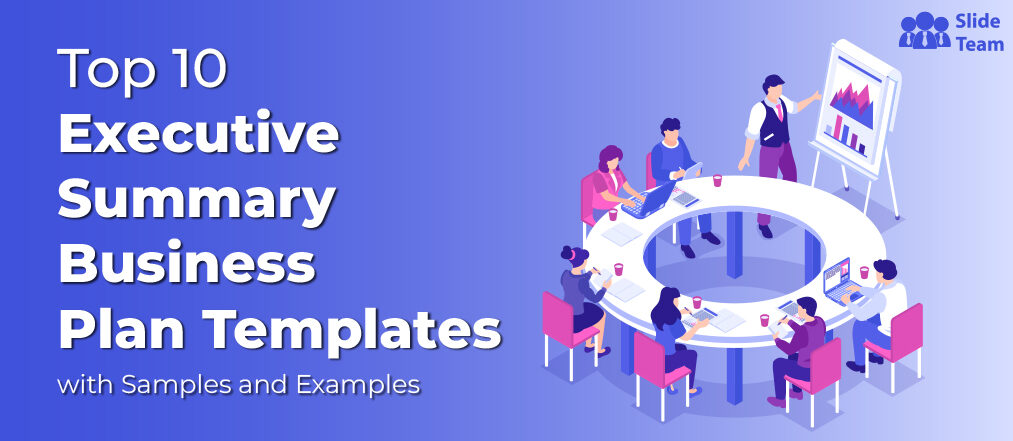
Top 10 Executive Summary Business Plan Templates with Samples and Examples
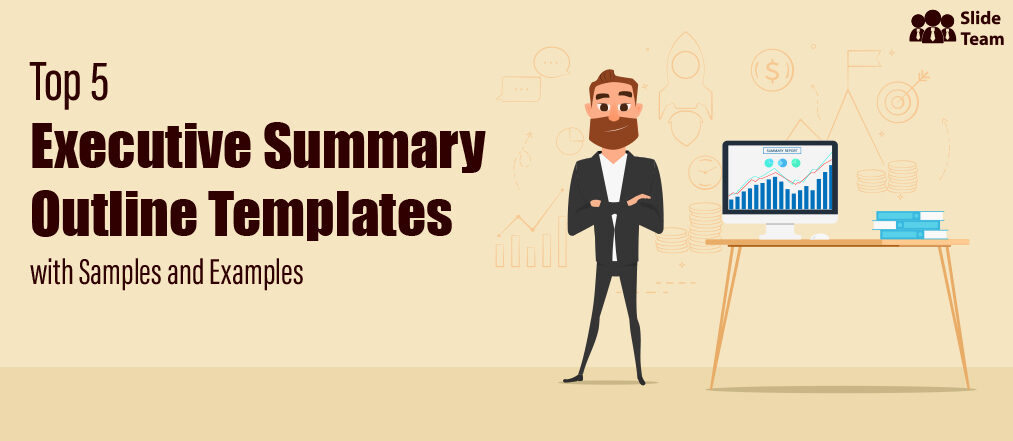
Top 5 Executive Summary Outline Templates with Samples and Examples

Top 10 Start-up Executive Summary Templates with Samples and Examples
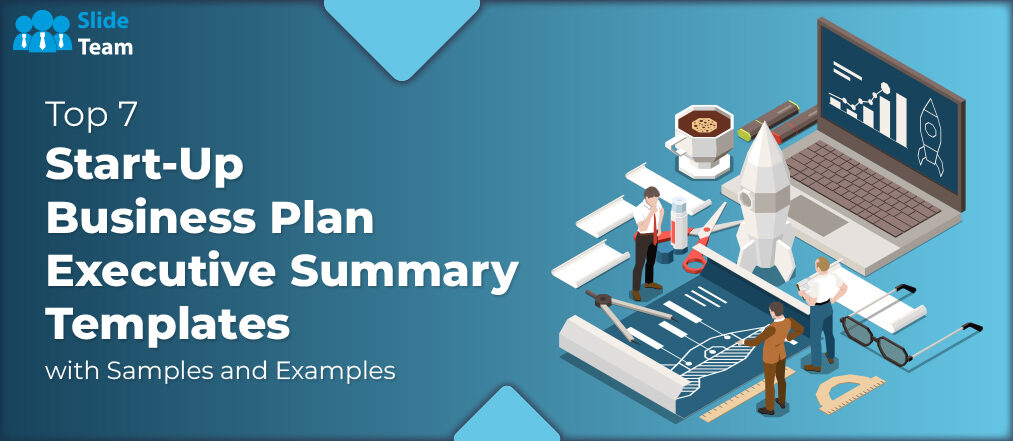
Top 7 Start-Up Business Plan Executive Summary Templates with Samples and Examples
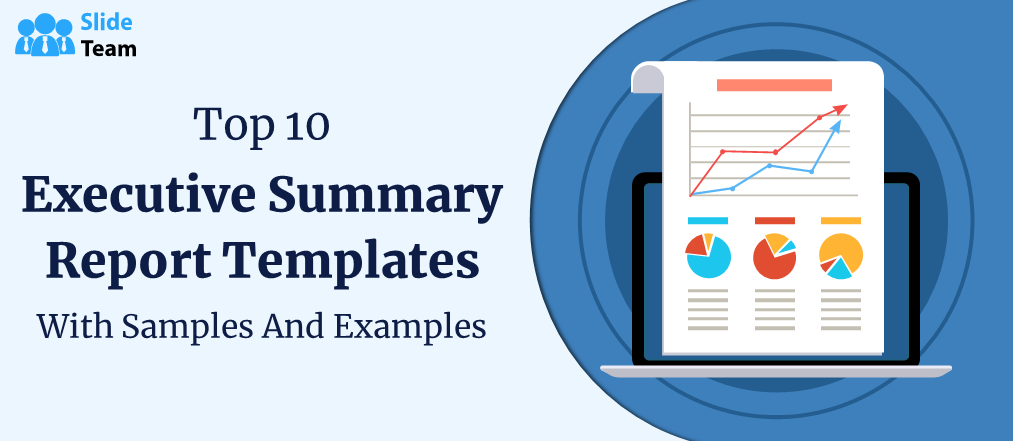
Top 10 Executive Summary Report Templates with Samples and Examples
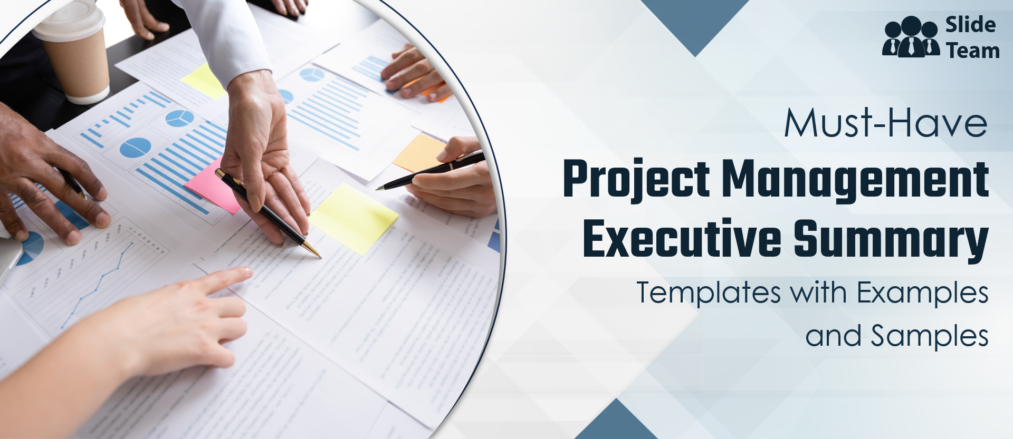
Must-Have Project Management Executive Summary Templates with Examples and Samples

Top 5 Executive Dashboard Templates with Samples and Examples
This form is protected by reCAPTCHA - the Google Privacy Policy and Terms of Service apply.

Digital revolution powerpoint presentation slides

Sales funnel results presentation layouts
3d men joinning circular jigsaw puzzles ppt graphics icons

Business Strategic Planning Template For Organizations Powerpoint Presentation Slides

Future plan powerpoint template slide

Project Management Team Powerpoint Presentation Slides

Brand marketing powerpoint presentation slides

Launching a new service powerpoint presentation with slides go to market

Agenda powerpoint slide show

Four key metrics donut chart with percentage

Engineering and technology ppt inspiration example introduction continuous process improvement

Meet our team representing in circular format

- Data, AI, & Machine Learning
- Managing Technology
- Social Responsibility
- Workplace, Teams, & Culture
- AI & Machine Learning
- Diversity & Inclusion
- Big ideas Research Projects
- Artificial Intelligence and Business Strategy
- Responsible AI
- Future of the Workforce
- Future of Leadership
- All Research Projects
- AI in Action
- Most Popular
- The Truth Behind the Nursing Crisis
- Work/23: The Big Shift
- Coaching for the Future-Forward Leader
- Measuring Culture

The spring 2024 issue’s special report looks at how to take advantage of market opportunities in the digital space, and provides advice on building culture and friendships at work; maximizing the benefits of LLMs, corporate venture capital initiatives, and innovation contests; and scaling automation and digital health platform.
- Past Issues
- Upcoming Events
- Video Archive
- Me, Myself, and AI
- Three Big Points

How to Create Slides That Suit Your Superiors: 11 Tips
When you’re pitching ideas or budgets to execs in your organization, you need to deliver slides that fit those particular people just right. This checklist identifies the key considerations.

- Workplace, Teams, & Culture
- Leadership Skills

Carolyn Geason-Beissel/MIT SMR | Getty Images
I recently interviewed 20 of my customers, all in senior roles at Fortune 100 companies, and asked them their biggest pain point in presenting to higher-ups and even colleagues. What I heard consistently was that it can feel like Goldilocks bouncing from one option to the next, testing to figure out what’s “just right.” Does the audience want deep reports? Sparse slides? Something in between? Like … what?
Teams often come to presentation meetings with vast amounts of backup content just in case an exec wants to take a deep dive on any given point. There’s often a struggle to anticipate every direction attendees might want to go. It’s frustrating, and it’s not efficient.
Get Updates on Transformative Leadership
Evidence-based resources that can help you lead your team more effectively, delivered to your inbox monthly.
Please enter a valid email address
Thank you for signing up
Privacy Policy
There are many ways to build slides. I’m not just talking about crafting them well versus poorly. I’m talking about all of the important decisions regarding how to organize them, how much text to use, when to lean into a chart, the best ways to use bullets and color, and whether to include an appendix with additional information. Before you make your next proposal or request of the executive team, use this list of 11 tips for your next set of slides as a guide.
Four Things You Must Have in Every Exec’s Slides
Before we drill down into the harder aspects, the ones where your executives’ tastes may vary widely, let’s quickly cover four aspects that you can consider the building blocks — the basics you should never proceed without.
Start with an executive summary. Begin the slide deck with a tight executive summary that follows a three-act structure. First, start with stating the current realities. Second, clearly state the problem or opportunity your idea addresses and its potential impact. Third, explain how your recommendation solves the problem or exploits the opportunity and the next steps you’re proposing.
Have a logical organization. The arc of the deck — the package from beginning to end — should make sense. If your audience reads only the headline of every slide, the order should be coherent and make most of the case for you. The content below each slide’s headline must support the statement made in the title. Remove everything that doesn’t support your point; as writers will tell you, you sometimes need to “kill your darlings” when you’re editing.
Begin the slide deck with a tight executive summary that follows a three-act structure.
Make it skimmable. Help your audience to quickly grasp the point without getting bogged down in details. Create a clear visual hierarchy. Guide the reader’s eye through the content: Use bold headings, bullet points, and numbered lists to break down information into digestible pieces. Highlight key takeaways or conclusions in a different color or font size to draw attention to these critical points.
Focus on concise insights. Succinct statements with clear insights are everyone’s jam. Every slide should serve a purpose and contribute directly to the decision-making process. Distill complex information. Don’t use 100 words when 20 words will nail it. If you’re having difficulty trimming, consider using company-approved AI tools to help you take out the fluff.
Five Preferences to Confirm With the Person You Want to Reach
Now we’ll delve into what your particular audience does and does not want. If you haven’t yet, start by asking the person you’re presenting to what they generally prefer. They probably know themselves well but have not been asked to articulate how they like to receive information.
Ask how dense is too dense. Some executives prefer detailed slides with comprehensive data. Others favor a more high-level approach. You’re weighing how to balance informative content with readability, ensuring that slides are not overloaded yet are sufficiently detailed to support decision-making.
Confirm the delivery format and timing. Some execs like information presented to them. Others prefer a pre-read of the material followed by a discussion. I always recommend our tool Slidedocs (I’ve written a free e-book on them), which are visual documents using both words and images. The templates help presenters organize their thoughts into a document for a pre-read or a read-along. They are designed to be skimmable and able to travel through your organization without the help of a presenter.
I’m a huge fan of pre-reads and prefer to use my time in meetings to ask questions and build alignment. If your audience didn’t review your material in advance, ask at the top of the meeting whether they would like you to present it or would prefer to read through it and then discuss it.
Find out how much data visualization they prefer. Charts, graphs, photos, and illustrations often communicate complex data more clearly than words alone. When execs can see what you’re saying, they often can better understand the impact of your idea. Does the exec want to understand exact numbers? Bar charts allow them to move their eyes across a series of specifics. Does the exec want to know the shape of a trend over time? Line charts can show the pattern. (See “Classic Charts Communicate Data Quickly.”) Some prefer charts with annotations that draw attention to what you think is the most important point. Others want to make their own conclusions from the data.
One of my clients, the CEO of a massive commercial real estate company, doesn’t want anything visualized. He prefers numbers, only in a table, and only in two colors — black and red. You might think this is archaic. But the fact that he’s clear to his teams about what he wants takes all the mystery out of how to communicate with him.
When the stakes are high, have a conceptual thinker help with diagrams and concepts. If you don’t have one on your team, and when it’s high stakes, find an internal designer to help you or hire one. You can’t afford to have the baby (your idea) thrown out with the bathwater (terrible slides).
Identify which details need spelling out. How well do the people you’re presenting to know the landscape and function of the company and products you’re talking about? For example, if your engineering team threw a slide into a deck about an issue that requires executive approval, do the execs all speak geek? Or do you need to explain the technology so that they will really understand the ask? Either eliminate internal jargon and acronyms or unpack those bits, especially if your proposal deeply involves expertise outside of the executives’ domain.
Ask whether appendices will be useful. When you’re organizing a presentation, you often troll data, read through complicated reports, and even hire external experts to figure out what’s best for the company. Do your execs want access to that supporting data? You can add a document to the end of the presentation as an appendix to show all of the data and source material. This allows the main content of the slides to remain focused and accessible while still providing comprehensive background information for those who want more.
Two Tips to Improve Your Presentation Skills
Getting materials in place is the biggest step. They will be your best tools for selling your ideas. But there are two extra areas to pay attention to as a presenter: how you handle questions and how you use every experience to improve.
Anticipate questions, and practice your answers. Before you have your meeting, gather a small team to challenge every point you make. Invite colleagues you trust to role-play as “a rapidly inquisitive exec” or “the doubting naysayer exec” so you are prepared to present your idea well. They’re gonna grill you, and practicing will help you remain unruffled when it happens.
Related Articles
Ask for feedback after the presentation. Establish a feedback loop with those you presented to. Ask what worked well and how you can improve. If attendees don’t have the time, find people who have had their ideas funded and talk to them about what they did that worked. Advice and some perspective will help you nail your performance even better next time.
Empathetically understanding your audience members and how they process information, whether it’s executives or peers, sets up your ideas for success. Clarity creates efficiency. When a presentation fits just right, you’ve given your great thinking the best chance of moving through your organization and having maximum impact.
About the Author
Nancy Duarte is CEO of Duarte Inc. , a communication company in the Silicon Valley. She’s the author of six books, including DataStory: Explain Data and Inspire Action Through Story (Ideapress Publishing, 2019).
More Like This
Add a comment cancel reply.
You must sign in to post a comment. First time here? Sign up for a free account : Comment on articles and get access to many more articles.
- DynamicPowerPoint.com
- SignageTube.com
- SplitFlapTV.com

Visit PresentationPoint at “Present to Succeed”, Sofia Bulgaria, 2024
Apr 11, 2024 | Articles , Attractions and Events
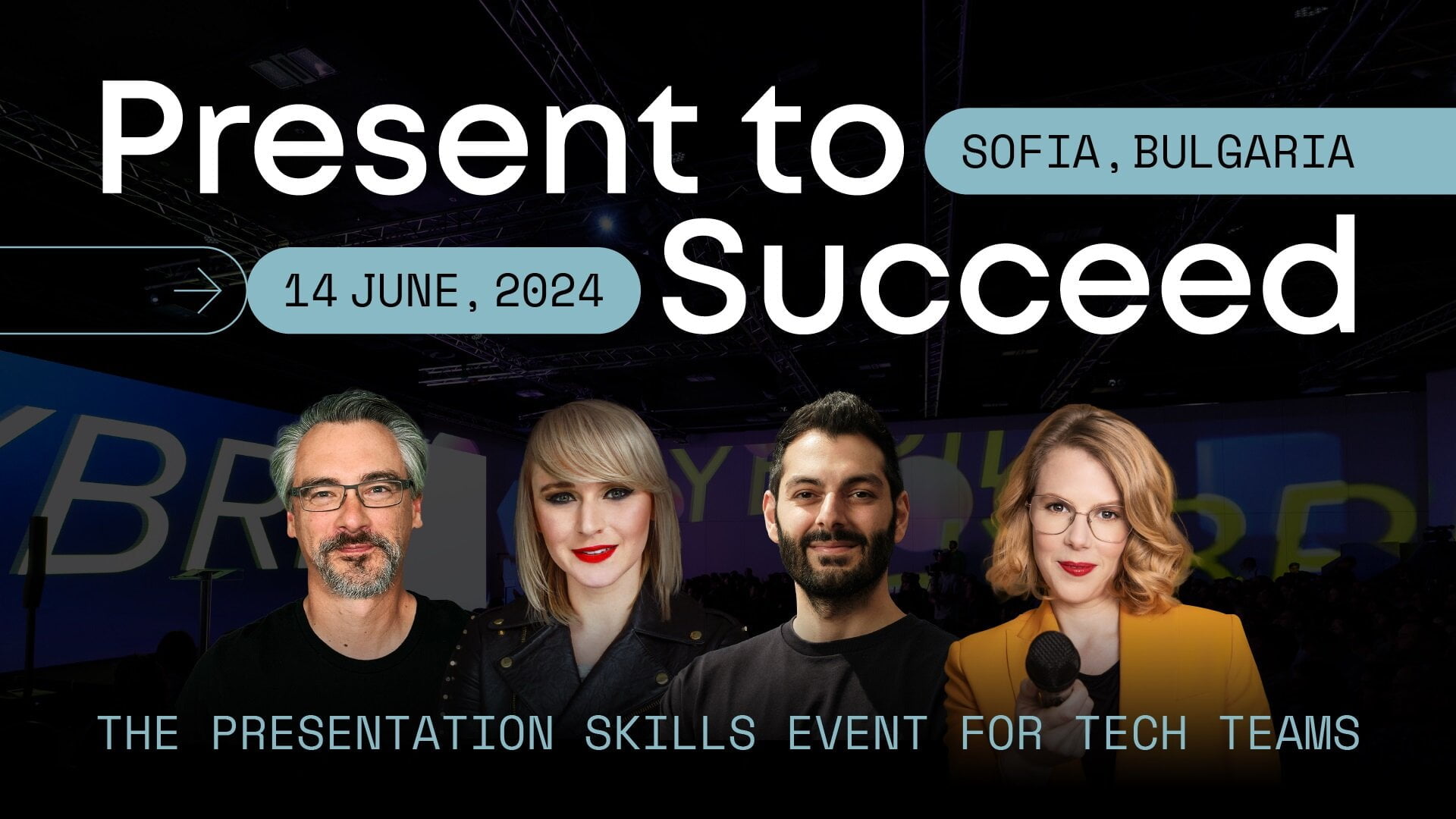

Submit a Comment
Your email address will not be published. Required fields are marked *
Pin It on Pinterest
- StumbleUpon
- Print Friendly

IMAGES
VIDEO
COMMENTS
How to Write an Executive Summary for a Presentation. 1. Start with a Problem Statement. Think of the first paragraph as if of an opening slide for a presentation: you need to make a big compelling statement that immediately communicates your agenda.
Here's a genericized executive summary slide based on material provided by a recent client. This recap was created to give the VP of Sales a comprehensive overview of last quarter's sales performance across all three company brands (A, B, and C). The full presentation deck contained about 30 slides, with detailed sections for each brand.
Let's take a closer look at each component of the executive summary and how it can be used to craft an effective executive summary deck using the McKinsey/BCG/Bain methodology. 1. Objective. The objective of the executive summary should succinctly define the purpose of the presentation and why it is important for the audience to understand the ...
These BCG executive summary slides are a great example of an executive summary done well. So we'll use them to describe best practices. Best practice #1: Bold text for summary sentences, bullet points for supporting data. One of the first things you'll notice about the BCG executive summary is the bold-bullet structure.
In general, there are four parts to any executive summary: Start with the problem or need the document is solving. Outline the recommended solution. Explain the solution's value. Wrap up with a conclusion about the importance of the work. Free cross-functional project template.
Step 3: Outline the structure. Create an outline for your executive summary with sections like introduction, objective, methodology, findings, recommendations, and conclusion. This way, you'll have a logical flow that's easy to follow.
Keep it Simple and Short. The executive summary template should only be 5% - 10% of the length of the entire presentation. Putting too many details in the executive summary is contradicting to its purpose. Make the executive summary focused and simple, by using short paragraphs or bullets, and subheadings.
Conclusion: Creating and presenting best executive summary slides needs a thought-out method. Keep your slides simple, easy to understand, and visually appealing. This will assist you in telling important things to others clearly, so they won't forget this quickly. Elevate your executive summaries to a new level of professionalism and clarity ...
Your executive summary or the presentation is the first thing your viewer would see. Make it worth it by using the tips we mentioned in this article. PowerPoint. Presentation Tips.
Typically, your executive summary should be a one-pager (one and a half pages at worst). To summarise a 3000 - 5000-word document into one page is no easy task, so you'll need to: Present only the most important information (key insights, recommendations, etc). Write concisely - i.e. with brevity and completeness.
Step 2: Write for Your Audience. When writing your executive summary, you want to keep your intended audience in mind always and write it for them. First off, you need to consider your reader's current level of knowledge. Then use languages and terms appropriate for your target audience.
The executive summary can be one slide in the presentation. When preparing, e.g., a 10 slides presentation for executives, make sure to include a 1-page opening slide. Sometimes, it becomes not possible to present the whole material.
Keep it simple and clear. A good executive summary should be concise and easy to understand. After all, the whole point is to summarize your content. To keep things simple, avoid jargon, technical terms, or complex charts that may confuse your audience. Remember, your goal is to communicate effectively and get to the point quickly, not to ...
A creative executive summary presentation involves several vital strategies to capture your audience's attention and convey the main points effectively. 1. Create an Engaging Slide Title: The title of your slide is the first thing your audience will see. Make it count by clearly stating the main takeaway and setting the tone for the rest of ...
Here are some ideas we collected from various sources that can help you create a solid draft executive summary for a presentation: 1. State the Problem. Your first paragraph is akin to the first slide of a presentation, which means you need to create an impact and convey the agenda - set the scene, so to speak.
Try to create an executive summary that is between 5-10% of the length of the finished document (for a report or presentation that is 20 slides or less, create a one-page executive summary). Conclusion. The executive summary is often the first thing an executive or investor reads when they receive your business plan or proposal.
In this video, I (former Bain & Company Manager) will share the benefits of using Executive Summaries in business presentations and how to craft effective Ex...
Here are several general steps to consider when writing an executive summary: 1. Research effective executive summaries. Before you write your own executive summary, it may be helpful to review summaries written by others. This is especially true for those writing an executive summary for the first time.
To put all of that information together, here's the basic format of an executive summary. You can find this same information in our free executive summary template: Introduction, be sure to know your audience. Table of contents in the form of a bulleted list. Explain the company's role and identify strengths.
General tips for making a successful executive summary. -Keep it brief. Your summary should be concise and to the point. Provide the key points of your presentation without too much detail. The goal is not to provide an in-depth description, but to clarify what you would like to present. -Be clear about your intentions.
Let the audience know what the plan is, such as five minutes dedicated to the presentation and the next 25 to questions. Summarize upfront. Use the inverted pyramid method and lead with all the information the audience cares about from the start. Then move onto the supporting details and background information.
1. Executive Summary PowerPoint Presentation Deck. Step into a world of concise brilliance with our versatile collection of industry-tailored executive summary templates, catering to diverse sectors like food and beverage, IT organizations, soft drink companies, car manufacturing organizations, consumer goods firms, fashion clothing brands ...
Download The Templates - https://bit.ly/3epDa0rAn executive summary is a crucial part of any business presentation. It summarizes the overall presentation an...
Begin the slide deck with a tight executive summary that follows a three-act structure. First, start with stating the current realities. Second, clearly state the problem or opportunity your idea addresses and its potential impact. Third, explain how your recommendation solves the problem or exploits the opportunity and the next steps you're ...
Present To Succeed covers a diverse range of topics crucial to effective presentations, including storytelling, slide design, data visualization, public speaking, and presentation tools. With speakers gathering from all corners of the globe, attendees can expect insights and strategies that transcend borders and industries.